
So you suddenly have a lot of staff working remotely. Telework is not new and a good percentage of the workforce already does so. But the companies who have a distributed workforce had time to plan for it, and to plan for it securely.
A Lot of New Teleworkers All At Once
This event can’t be treated like a quick rollout of an application: there are business, infrastructure, and customer security impacts. There will be an increase of work for help desks as new teleworkers wrestle with remote working.
Additionally, don’t compound the problem. There is advice circulating to reset all passwords for remote workers. This opens the door for increased social engineering to attempt to lure overworked help desk staff into doing password resets that don’t comply with policy. Set expectations for staff that policy must be complied with, and to expect some delays while the help desk is overloaded.
Business continuity issues will arise as limited planning for remote workers could max out VPN licenses, firewall capacity, and application timeouts as many people attempt to use the same apps through a narrower network pipe.
Help Staff Make A Secure Home Office
In the best of times, remote workers are often left to their own devices (pun intended) for securing their work at home experience. Home offices are already usually much less secure than corporate offices: weak routers, unmanaged PCs, and multiple users means home offices become an easier attack path into the enterprise.
It doesn’t make sense to have workers operate in a less secure environment in this context. Give them the necessary security tools and operational tools to do their business. Teleworkers, even with a company-issued device, are likely to work on multiple home devices. Make available enterprise licensed storage and sharing tools, so employees don’t have to resort to ‘sketchy’ or weak options when they exceed the limits for free storage on Dropbox or related services.
A Secure Web Gateway as a service is a useful option considering that teleworkers using a VPN will still likely be split tunneling (i.e. not going through corporate security devices when browsing to non-corporate sites, etc.), unlike when they are in the corporate office and all connections are sanitized. That is especially important in cases where a weak home router gets compromised and any exfiltration or other ‘phone home’ traffic from malware needs to be spotted.
A simple way to get this information out to employees is to add remote working security tips to any regularly occurring executive outreach.
Operational Issues
With a large majority of businesses switching to a work-from-home model with less emphasis on in-person meetings, we also anticipate that malicious actors will start to impersonate digital tools, such as ‘free’ remote conferencing services and other cloud computing software.
Having a policy on respecting telework privacy is a good preventative step to minimize the risk of this type of attack being successful. Remote workers may be concerned about their digital privacy when working from home, so any way to inform them about likely attack methods can help.
Any steps to prevent staff trying to evade security measures out of a concern over privacy are likely a good investment.
Crisis Specific Risks
During any major event or crisis, socially engineered attacks and phishing will increase. Human engineering means using any lever to make it a little bit easier for targets to click on a link.
We’re seeing targeted email attacks taking advantage of this. Some will likely use tactics such as attachments named “attached is your Work At Home Allowance Voucher,” spoofed corporate guidelines, or HR documents.
Sadly, we expect hospitals and local governments will see increased targeting by ransomware due the expectation that payouts are likelier during an emergency.
But Hang On – It Is Not All Bad News
The good news is that none of these attacks are new and we already have playbooks to defend against them. Give a reminder to all staff during this period to be more wary of phishing, but don’t overly depend on user education – back it up with security technology measures. Here are a few ways to do that.
|
|
The post Suddenly Teleworking, Securely appeared first on .

We are in unique times and it’s important to support each other through unique ways. Snyk is providing a community effort to make a difference through AllTheTalks.online, and Trend Micro is proud to be a sponsor of their virtual fundraiser and tech conference.
In today’s threat landscape new cloud technologies can pose a significant risk. Applying traditional security techniques not designed for cloud platforms can restrict the high-volume release cycles of cloud-based applications and impact business and customer goals for digital transformation.
When organizations are moving to the cloud, security can be seen as an obstacle. Often, the focus is on replicating security controls used in existing environments, however, the cloud actually enables new levels of visibility and controls that weren’t possible before.
With today’s increased attention on cyber threats, cloud vulnerabilities provide an opportunistic climate for novice and expert hackers alike as a result of dependencies on modern application development tools, and lack of awareness of security gaps in build pipelines and deployment environments.
Public clouds are capable of auditing API calls to the cloud management layer. This gives in-depth visibility into every action taken in your account, making it easy to audit exactly what’s happening, investigate and search for known and unknown attacks and see who did what to identify unusual behavior.
Join Mike Milner, Global Director of Application Security Technology at Trend Micro on Wednesday April 15, at 11:45am EST to learn how to Use Observability for Security and Audit. This is a short but important session where we will discuss the tools to help build your own application audit system for today’s digital transformation. We’ll look at ways of extending this level of visibility to your applications and APIs, such as using new capabilities offered by cloud providers for network mirroring, storage and massive data handling.
Register for a good cause and learn more at https://www.allthetalks.org/.
The post Cloud Native Application Development Enables New Levels of Security Visibility and Control appeared first on .

Cloud computing has revolutionized the IT world, making it easier for companies to deploy infrastructure and applications and deliver their services to the public. The idea of not spending millions of dollars on equipment and facilities to host an on-premises data center is a very attractive prospect to many. And certainly, moving resources to the cloud just has to be safer, right? The cloud provider is going to keep our data and applications safe for sure. Hackers won’t stand a chance. Wrong. More commonly than anyone should, I often hear this delusion from many customers. The truth of the matter is, without proper configuration and the right skillsets administering the cloud presence, as well as practicing common-sense security practices, cloud services are just (if not more) vulnerable.
The Shared Responsibility Model
Before going any further, we need to discuss the shared responsibility model of the cloud service provider and user.

When planning your migration to the cloud, one needs to be aware of which responsibilities belong to which entity. As the chart above shows, the cloud service provider is responsible for the cloud infrastructure security and physical security of such. By contrast, the customer is responsible for their own data, the security of their workloads (all the way to the OS layer), as well as the internal network within the companies VPC’s.
One more pretty important aspect that remains in the hands of the customer is access control. Who has access to what resources? This is really no different than it’s been in the past, exception being the physical security of the data center is handled by the CSP as opposed to the on-prem security, but the company (specifically IT and IT security) are responsible for locking down those resources efficiently.
Many times, this shared responsibility model is overlooked, and poor assumptions are made the security of a company’s resources. Chaos ensues, and probably a firing or two.
So now that we have established the shared responsibility model and that the customer is responsible for their own resource and data security, let’s take a look at some of the more common security issues that can affect the cloud.
Amazon S3
Amazon S3 is a truly great service from Amazon Web Services. Being able to store data, host static sites or create storage for applications are widely used use cases for this service. S3 buckets are also a prime target for malicious actors, since many times they end up misconfigured.
One such instance occurred in 2017 when Booz Allen Hamilton, a defense contractor for the United States, was pillaged of battlefield imagery as well as administrator credentials to sensitive systems.
Yet another instance occurred in 2017, when due to an insecure Amazon S3 bucket, the records of 198 million American voters were exposed. Chances are if you’re reading this, there’s a good chance this breach got you.
A more recent breach of an Amazon S3 bucket (and I use the word “breach,” however most of these instances were a result of poor configuration and public exposure, not a hacker breaking in using sophisticated techniques) had to do with the cloud storage provider “Data Deposit Box.” Utilizing Amazon S3 buckets for storage, a configuration issue caused the leak of more than 270,000 personal files as well as personal identifiable information (PII) of its users.
One last thing to touch on the subject of cloud file storage has to do with how many organizations are using Amazon S3 to store uploaded data from customers as a place to send for processing by other parts of the application. The problem here is how do we know if what’s being uploaded is malicious or not? This question comes up more and more as I speak to more customers and peers in the IT world.
API
APIs are great. They allow you to interact with programs and services in a programmatic and automated way. When it comes to the cloud, APIs allow administrators to interact with services, an in fact, they are really a cornerstone of all cloud services, as it allows the different services to communicate. As with anything in this world, this also opens a world of danger.
Let’s start with the API gateway, a common construct in the cloud to allow communication to backend applications. The API gateway itself is a target, because it can allow a hacker to manipulate the gateway, and allow unwanted traffic through. API gateways were designed to be integrated into applications. They were not designed for security. This means untrusted connections can come into said gateway and perhaps retrieve data that individual shouldn’t see. Likewise, the API requests to the gateway can come with malicious payloads.
Another attack that can affect your API gateway and likewise the application behind it, is a DDOS attack. The common answer to defend against this is Web Application Firewall (WAF). The problem is WAFs struggle to deal with low, slow DDOS attacks, because the steady stream of requests looks like normal traffic. A really great way to deter DDOS attacks at the API gateway however is to limit the number of requests for each method.
A great way to prevent API attacks lies in the configuration. Denying anonymous access is huge. Likewise, changing tokens, passwords and keys limit the chance effective credentials can be used. Lastly, disabling any type of clear-text authentication. Furthermore, enforcing SSL/TLS encryption and implementing multifactor authentication are great deterrents.
Compute
No cloud service would be complete without compute resources. This is when an organization builds out virtual machines to host applications and services. This also introduces yet another attack surface, and once again, this is not protected by the cloud service provider. This is purely the customers responsibility.
Many times, in discussing my customers’ migration from an on-premises datacenter to the cloud, one of the common methods is the “lift-and-shift” approach. This means customers take the virtual machines they have running in their datacenter and simply migrating those machines to the cloud. Now, the question is, what kind of security assessment was done on those virtual machines prior to migrating? Were those machines patched? Were discovered security flaws fixed? In my personal experience the answer is no. Therefore, these organizations are simply taking their problems from one location to the next. The security holes still exist and could potentially be exploited, especially if the server is public facing or network policies are improperly applied. For this type of process, I think a better way to look at this is “correct-and-lift-and-shift”.
Now once organizations have already established their cloud presence, they will eventually need to deploy new resources, and this can mean developing or building upon a machine image. The most important thing to remember here is that these are computers. They are still vulnerable to malware, so regardless of being in the cloud or not, the same security controls are required including things like anti-malware, host IPS, integrity monitoring and application control just to name a few.
Networking
Cloud services make it incredibly easy to deploy networks and divide them into subnets and even allow cross network communication. They also give you the ability to lock down the types of traffic that are allowed to traverse those networks to reach resources. This is where security groups come in. These security groups are configured by people, so there’s always that chance that a port is open that shouldn’t be, opening a potential vulnerability. It’s incredibly important from this perspective to really have a grasp on what a compute resource is talking to and why, so the proper security measures can be applied.
So is the cloud really safe from hackers? No safer than anything else unless organizations make sure they’re taking security in their hands and understand where their responsibility begins, and the cloud service provider’s ends. The arms war between hackers and security professionals is still the same as it ever was, the battleground just changed.
The post Is Cloud Computing Any Safer From Malicious Hackers? appeared first on .
Introduction Wireless networks have become an inherent part of our life and we all use wireless networks in some form in our day to day life. Of all the utilities provided by wireless networks, we use wireless networks widely for connecting to the internet. We connect to the internet wirelessly either by router or using […]
The post Wireless Networks and Security appeared first on Infosec Resources.
When you have a passion for writing and need to earn additional money, there are a number of excellent ways to earn by purchasing essays online. When you have not written in a long time and want to find a way to get started using the writing firm, subsequently selling essays is a wonderful way to start off. There are a lot of men and women that want to know more about these types of essays because they may be very competitive, so be prepared for some stiff competition. This may be an exceptional source of additional income because lots of folks will cover your work and will pay more than they would pay someone else for the exact same work.
There are a few hints to assist you start off and make it simpler to get essays on the internet. First, you want to understand what sort of essay that you would like to compose. There are various sorts of essays like essays about sciencefiction history, English, philosophy, literature, mathematics, social science, etc..
You also ought to know which type of essay is most suitable to your abilities and knowledge concerning various kinds of subjects. Some kinds of essays have special skills demanded of them while some don’t. Should you know what kind of essay that you wish to compose, you can restrict your options of what sort of essay to buy. You will then need more to pick from and you can select a price range that you feel comfy with.
The next thing to do is to get a location at which you can sell these records. It isn’t important how big the company is, it doesn’t matter how often the documents are offered. It just matters that you’re prepared to market and can afford to purchase. It’s also wise to be sure you’re willing to take orders.
You must be sure you have a list of potential buyers and a couple of sample essays to give to each one. This will allow you to develop your confidence that you can write well enough to persuade someone to purchase from you.
Selling essays is an excellent way to earn extra money. With these tips, you can succeed in making money by selling essays.
First, decide on the subject of the essay. Once you have decided the topic of the article, be certain you’ve got the essential information to write the article. Know the fundamental writing skills like grammar, punctuation, grammar, and other elements of grammar and syntax before you begin writing the article. You also will need to have enough info to understand what the topic of this essay is until you begin writing.
It’s essential to make sure the essay is not too long or too short. If it is too short, it won’t be read and if it’s too long, then it will not provide the reader free pre written essays with sufficient details. To make an educated decision. Don’t write the article, if you are unsure if it is adequate.
Selling essays is an excellent way to earn a little additional money. It’s very easy and you have many choices. Be certain you know what kind of essay to buy and make sure you are prepared.
The post Tips For Purchasing Essays Online appeared first on Infosec Resources.
How do we know which term paper essay writer helper authors for hire are legitimate? The answer is: You do not! That is why it’s so important to check these 2 websites to find out just who is writing your assignment Prior to Making your final decision:
It is always a good idea to request references. How do we do this? Well, most writers submit their testimonials by email. As you will notice in lots of customer reviews on this site, we’re doing a fantastic job of discovering the very best writers potential.
If you’re hiring a term paper writers for hire, we have a webpage on this site where you can obtain names and contact info. But, please make certain that you read the data carefully and be certain that the title is correct. Don’t settle for a last name when it isn’t. You should check with a former client to make certain that the writer is professional and reputable.
This site has over two million terms and subjects that term paper authors can write about. These topics range from business writing to the science and technology field. Our writers specialize in different areas, but each one of our authors is experienced in writing about a specific topic. To see what we have to offer, click on the’Term Papers’ tab at the top of the webpage. So as to discover a specific writer, simply type in your subject, and you will see a list of writers with experience on the topic.
One good author is going to have been known to this website by an earlier customer. If you wish to understand which authors we urge, simply take a moment to browse our authors’ profiles to see what kind of articles they have written. While they are more expensive than the less expensive writers available on the market, we feel that our authors are of greater quality and can provide better results.
We have used both of the above websites as we were trying to find the best term paper writers to hire for quite some time and we agree that both of them are reliable resources. Both sites will provide you information about writing solutions, and both will let you have a look at samples of past clients’ work. When you are employing a writer, it’s crucial that you do your homework and find a company or author that’s qualified to work together with you and your specific topic. This is the only method to make sure you’re getting the most accurate and handiest composition feasible for your homework.
The post Term Paper Writers For Hire – 3 Things to Search For in Requirements and Topic Writers appeared first on Infosec Resources.
Affordable essays are something which all people can love. Nonetheless, so as to acquire such essays performed in a good price, you have to take a few unique actions. This article will help you through a few of the methods you can approach the process of getting cheap essays to be written to your class.
The very first thing you need to do would be to make sure you just write your own essay. This is most likely the single most important step. You might have heard each of the ridiculous stories about writers who spend months on study and put together essays that are all rewritten each week. It’s not worthwhile. Just write your essay.
Once you begin on writing cheap essays, then the next thing you need to keep in mind is to paper.online write at a consistent pace. You can always speed up as you move along but you won’t ever have the ability to write at a quicker rate than you are currently writing at. Be patient. And don’t worry about plagiarism.
Remember, these essays aren’t supposed to be an academic paper, so that they are supposed to be an educational experience for the students. Write your essay from the point of view of your viewers; the perspective of the reader.
Find a way to be creative and entertaining while writing your own essay. So long as it remains true to what your audience should hear and understand, you need to have the ability to stay on topic. Some great ways to do this include using some game or story based on the mission.
Find a means to include the course exercise inside the essay too. Get out of the classroom and do something different. Use your imagination. What would you prefer in order to perform if you are finished with your mission?
Finally, remember you are going to want to get into the habit of practicing your own essay. Don’t simply sit right down and write. Just take time each day to write out the different facets of your essay. This can allow you to get accustomed to composing, and you will also see the content of your article more clearly.
When you can receive an essay composed without any mistakes in under 2 hours, you will understand that you’re capable of writing them, and you won’t need to pay a good deal of cash to get them done. You will be prepared to go next year!
The post Easy Essay Tips – Getting Cheap Essays Done For Longer appeared first on Infosec Resources.
According to Statista, 3.5 billion people worldwide are forecasted to own a smartphone by the end of 2020. These connected devices allow us to have a wealth of apps and information constantly at our fingertips – empowering us to remain in constant contact with loved ones, make quick purchases, track our fitness progress, you name it. Hackers are all too familiar with our reliance on our smartphones – and are eager to exploit them with stealthy tricks as a result.
One recent example of these tricks? Suspicious text messages claiming to be from USPS. According to Gizmodo, a recent SMS phishing scam is using the USPS name and fraudulent tracking codes to trick users into clicking on malicious links.
Let’s dive into the details of this scheme, what it means for users, and what you can do to protect yourself from SMS phishing.
To orchestrate this phishing scheme, hackers send out text messages from random numbers claiming that a user’s delivery from USPS, FedEx, or another delivery service is experiencing a transit issue that requires urgent attention. If the user clicks on the link in the text, the link will direct them to a form fill page asking them to fill in their personal and financial information to “verify their purchase delivery.” If the form is completed, the hacker could exploit that information for financial gain.
However, scammers also use this phishing scheme to infect users’ devices with malware. For example, some users received links claiming to provide access to a supposed USPS shipment. Instead, they were led to a domain that did nothing but infect their browser or phone with malware. Regardless of what route the hacker takes, these scams leave the user in a situation that compromises their smartphone and personal data.

While delivery alerts are a convenient way to track packages, it’s important to familiarize yourself with the signs of phishing scams – especially as we approach the holiday shopping season. Doing so will help you safeguard your online security without sacrificing the convenience of your smartphone. To do just that, follow these actionable steps to help secure your devices and data from SMiShing schemes:
Be skeptical of text messages claiming to be from companies with peculiar asks or information that seems too good to be true. Instead of clicking on a link within the text, it’s best to go straight to the organization’s website to check on your delivery status or contact customer service.
Many spammers send texts from an internet service in an attempt to hide their identities. Combat this by using the feature on your mobile device that blocks texts sent from the internet or unknown users. For example, you can disable all potential spam messages from the Messages app on an Android device by navigating to Settings, clicking on Spam protection, and turning on the Enable spam protection switch. Learn more about how you can block robotexts and spam messages on your device.
Prepare your mobile devices for any threat coming their way. To do just that, cover these devices with an extra layer of protection via a mobile security solution, such as McAfee Mobile Security.
To stay updated on all things McAfee and on top of the latest consumer and mobile security threats, follow @McAfee_Home on Twitter, listen to our podcast Hackable?, and ‘Like’ us on Facebook.
The post Special Delivery: Don’t Fall for the USPS SMiShing Scam appeared first on McAfee Blogs.

In the early days of the COVID-19 pandemic, another pandemic of sorts took root—this one an “infodemic.” Whether designed to mislead, instill fear, capitalize on crank remedies, or push phony cures that caused harm or worse, millions of outright false stories about COVID-19 proliferated across the internet. And continue to do so.
Now, with our upcoming election in the U.S., there’s concern that this infodemic of misinformation about COVID-19 will keep people away from the polls or from working at them. Particularly elders.
With this blog, my aim is to point you toward trustworthy resources online that can help you get your vote cast and counted safely.
First, a word about COVID-19 misinformation in general.
Since the initial outbreak, we’ve monitored online threats and scams related to COVID-19. As shown in our July 2020 Threat Report, the first three months saw the number of malicious and scam websites related to COVID-19 jump from 1,600 to more than 39,000, along with a wave of spam emails and posts that peddled bogus sites for protective gear, masks, and cures. Now, in mid-September, our threat detection team has uncovered three million online threats related to COVID-19 and counting. (See the daily tally here for the latest figures.)
Elsewhere, global and national public health officials have worked diligently to counter these waves of misinformation, such as the World Health Organization’s COVID-19 “mythbuster” site, in addition to further mythbusting from major news outlets around the world and yet more mythbusting from respected science publications. However, instances of misinformation, both big and small, persist and can lead to negative health consequences for those who buy into such misinformation.
Whether you’ll vote in person or by mail, these links provide a mix of trustworthy information about voting and the latest verified information about the virus:
Be aware that our collective understanding of COVID-19 continues to evolve. The pandemic isn’t even a year old at this time, and new research continues to reveal more about its nature. Be sure to check with these resources along with your local public health resources for the latest on the virus and how to stay safe.
If you’re considering voting by mail, the following is for you. Published by U.S. News and World Report, this article breaks down how you can vote by mail in your state. While all 50 states allow for mail-in voting in some form or fashion, specifics vary, and some states make it easier to do than others. (For example, a handful of states like Texas, Indiana, and Louisiana currently do not allow COVID-19 concerns as a valid reason for requesting a mail-in ballot.)
Note that this article was published at the end of August, so be sure to follow the links for your state as published in the article for the absolute latest information. Yet don’t wait to look into your absentee or mail-in options. As noted above, each state has its terms and deadlines, so it’s best to review your options now.
Meanwhile, five states— Colorado, Hawaii, Oregon, Washington state, and Utah already conduct their elections entirely by mail. Such practices have proven to be successful alternatives to voting in person, they have slightly increased voter turnout while minimizing the risks of voter fraud.
Get your vote out safely. Whether it’s by visiting the polls following the safety guidelines or by way of mail as also allowed by your state, it can be done—particularly when you have trusted information sources at hand.
To stay updated on all things McAfee and for more resources on staying secure from home, follow @McAfee_Home on Twitter, listen to our podcast Hackable?, and ‘Like’ us on Facebook.
The post U.S. Election 2020 – Don’t Let COVID-19 Misinformation Suppress Your Vote appeared first on McAfee Blogs.

If you’re thinking career change or career shift, there’s a field that has an estimated 4 million jobs open. Cybersecurity.
According to survey and research data from the International Cybersecurity Organization (ICS)2, there’s a cybersecurity workforce gap—a terrifically high volume of jobs left unfilled. Published in 2019, the gap they identified looked like this:
Needless to say, there’s opportunity in the field for both technical and non-technical roles.
Here’s an important thing to keep in mind about cybersecurity:, it’s not solely about understanding technology. It’s about understanding people too and how people and technology interact.
The moment you see cybersecurity through that broader lens, you can see how the field opens widely to encompass a range of roles. Of course, there are analysts and engineers, yet it also includes other roles like digital forensics and cyber investigation, healthcare information security, cryptography, and even cyber law. Additionally, there’s needed expertise in the realms of privacy, governance, ethics, and even digital ethics. And if you take a role with a security company such as ours, the opportunity further extends to positions in account management, marketing, and operations. (In fact, you can drop by our careers page for a look at our current openings and what workday life is like around here.)
There are plenty of reasons. Above that data published in 2019, our unprecedented reliance on the internet to work, learn, and stay connected in 2020, demand for cybersecurity jobs is yet more so on the rise. As so many of us turned increasingly to the internet to get through our day, the same is true for hackers and crooks.
With that, let’s take a quick look at several of the factors working in your favor as you consider a change.
We’ve all seen the news stories of major breaches at big retailers, credit reporting agencies, hotels, and even healthcare providers. It’s not just the private sector that’s been grappling with cybersecurity concerns, there’s need in the public sector as well—like municipalities. In all, every organization needs cybersecurity (just as we all need cybersecurity for our homes), and thus there’s plenty of opportunity out there. Using just one of the many possible cybersecurity roles as an example, the U.S. Bureau of Labor Statistics predicts a 32% increase in demand for information security analysts through 2028—which is far higher than the average of other professions.
In fact, the same (ICS)2 survey discovered that only 42% of current cybersecurity pros said that their first job after higher education was in the field of cybersecurity. In other words, the majority of cybersecurity pros ended up that way by some means of career shift or change. And they got there through certifications and training rather than by way of a degree from a college or university.
Our own Chief Human Resources Officer, Chatelle Lynch, put it quite well in an interview with Business Insider just a few weeks ago: “It’s no secret that the demand for cybersecurity staff has steadily grown over the past decade,” she says. “This means opportunity, so if you don’t have a degree, don’t let that slow you down. You may have unique work experience or relevant certifications, alternative learning, or transferable skills that you need to make sure you highlight when applying and interviewing.”
For example, she goes on to say that prior military service, IT experience, and volunteer or hobbyist activities (even online gaming) are a good foundation for cybersecurity roles.
These skills absolutely apply, and they’re sought after skills as well. The ability to work independently, lead projects, write and document well, and particularly strong people skills are vital for a role where you’ll be interfacing with numerous individuals, departments, and business units. Likewise, as called out above, certain roles focus more on the non-technical side of security solutions.
The beauty of making a career change to cybersecurity is that there are plenty of ways you can get it done at home and on your time.
If you’re just getting started, you can test the waters for free or at relatively low cost with a Massively Open Online Course (MOOC) that gives you the basics on cybersecurity. Future Learn’s “Introduction to Cybersecurity” from The Open University is one example of an intro program, as is the University of Michigan’s “Securing Digital Democracy” class that’s offered through Coursera.
If you’re already an IT pro or have a strong technical background, there are similar MOOC courses available that cater to your current level of knowledge and skill. The University of Maryland’s “Cybersecurity Specialization” and “Usable Security” are geared accordingly.
For a list of cybersecurity programs available online, drop by CyberDegrees.org. Their listing is one of many good places to start.
Other free and low-cost avenues out there include subscribing to some security bloggers, grabbing some hands-on work with coding and IT networking fundamentals from online learning companies like Udemy, Codecademy, and Khan Academy, or joining some online cybersecurity groups for a little professional networking. In all, there’s plenty of opportunity to learn from others, both in structured class settings and in more unstructured peer and mentorship relationships.
When you’re ready to start your job search, there’s a good chance that your interview will be conducted online. Online interviews have been part of the job-hunting landscape for a few years now, yet with many employers enacting work from home measures, it’s the way hiring gets done right now. I expect this to continue, as employers have embraced its many benefits, particularly in the early stages of interviews. If the prospect of an online interview is new to you, I put together a pair of articles this spring that can help.
As you make the jump, here’s the most important thing you’ll need: a love of technology and a desire to protect the people who use it. If you can combine a drive to understand both technology and people better with the further drive to see it all through, you’ll be well on your way. Like any career shift or change, there’s work ahead, yet it’s my impression that our field is a welcoming and supportive one—and very much on a keen lookout for new talent.
To stay updated on all things McAfee and for more resources on staying secure from home, follow @McAfee_Home on Twitter, listen to our podcast Hackable?, and ‘Like’ us on Facebook.
The post Career change? Cybersecurity companies are hiring. appeared first on McAfee Blogs.

Forecasts predict that roughly 80 million votes will get cast by mail-in ballots—double the number cast by mail in the 2016 election. Here are a couple tips to make sure your vote counts for the 2020 election.
Smart use of the internet will help you cast a mail-in ballot that counts.
Projections abound, yet forecasts predict that roughly 80 million votes will get cast by mail-in ballots—double the number cast by mail in the 2016 election. While we’ll only know the final tally of mail-in voters sometime after election day, what we know right now is that nearly 75% of U.S. voters will be able to vote by mail in the 2020 election
If you’re one of those voters, or know someone who is, this quick five-point primer of online resources should help.
Pew Research found that Americans are split 50/50 as to whether voting in the 2020 election will be “easy” or “hard.” Compare that to the 2018 figures where 85% said that voting would be “easy” in that election. We can chalk that up to several factors this year, most notably the effect of the pandemic on voting, which I touched on in my blog last week.
However, there are other concerns at play. We’ve seen concerns about mail-in ballot fraud, along with confusion about how to get a mail-in ballot, and yet further confusion as to who is eligible to get a mail-in ballot in the first place… just to name a few.
These concerns all share a common remedy: the facts.
Good information, direct from your state election officials, will point the way. Skip social media altogether. It is not a trusted resource. In all, it’s a mistake to get any election information on social media, according to F.B.I. Director, Christopher Wray. Instead, let’s point ourselves in the right direction.
To stay updated on all things McAfee and for more resources on staying secure from home, follow @McAfee_Home on Twitter, listen to our podcast Hackable?, and ‘Like’ us on Facebook.
The post Election 2020 – Five Tips to Secure a Mail-In Ballot That Counts appeared first on McAfee Blogs.

During COVID-19, people stuck inside have scoured the internet for content to consume – often searching for free entertainment (movies, TV shows, and music) to avoid any extra costs. As these habits increase, so do the potential cyberthreats associated with free internet content – making our fourteenth Most Dangerous Celebrities study more relevant than ever.
To conduct our Most Dangerous Celebrities 2020 study, McAfee researched famous individuals to reveal which celebrities generate the most “dangerous” results – meaning those whose search results bring potentially malicious content to expose fans’ personal information.
Known for his BAFTA-winning celebrity chat show and BBC radio show, the UK’s national treasure, Graham Norton, has found himself at the top of McAfee’s 2020 Most Dangerous Celebrities list.
Graham Norton is a household name thanks to his hugely popular talk show, The Graham Norton Show, which has seen him interview A-listers including Nicole Kidman, Hugh Grant and Helen Mirren. He is also known for his BBC radio show, as well as his inimitable Eurovision commentary. Not shy of celebrity friends, Norton is joined in the top ten list by fellow national treasures such as Ricky Gervais (No.2), and Idris Elba (No.7) and Mary Berry (no.10). Also included in the top ten list are British actor Tom Hardy (No.3) and Gavin and Stacey star, Ruth Jones (No.4). Rounding out the rest of the top ten are UK’s very own Mick Jagger (No.5), Aussie actress Margot Robbie (No.6) and models Kate Moss (No.8) and Bella Hadid (No.9).
Many consumers don’t realize that simple internet searches of their favorite celebrities could potentially lead to malicious content, as cybercriminals often leverage these popular searches to entice fans to click on dangerous links. This year’s study emphasizes that consumers are increasingly searching for content, especially as they look for new forms of entertainment to stream amidst a global pandemic.
With a greater emphasis on streaming culture, consumers could potentially be led astray to malicious websites while looking for celebrity gossip and new shows or movies to watch. For example, given Graham is strongly associated with malicious search terms, indicates that online criminals are using Britain’s love for celebrity gossip and the Eurovision for personal gain. If an unsuspecting user clicks on a malicious link while searching for their favorite celebrity film, their device could suddenly become plagued with adware or malware.
Whether you and your family are checking out your new favorite actress in her latest film or streaming a popular singer’s new album, it’s important to ensure that your searches aren’t potentially putting your online security at risk. Follow these tips so you can be a proactive fan while safeguarding your digital life:
Users looking for information on their favorite celebrities should be cautious and only click on links to reliable sources for downloads. The safest thing to do is to wait for official releases instead of visiting third-party websites that could contain malware.
Refrain from using illegal streaming sites
When it comes to dangerous online behavior, using illegal streaming sites could wreak havoc on your device. Many illegal streaming sites are riddled with malware or adware disguised as pirated video files. Do yourself a favor and stream the show from a reputable source.
Safeguard yourself from cybercriminals with a comprehensive security solution like McAfee Total Protection. This can help protect you from malware, phishing attacks, and other threats.
Use a website reputation tool such as McAfee WebAdvisor, which alerts users when they are about to visit a malicious site.
Kids are fans of celebrities too, so ensure that limits are set for your child on their devices and use parental control software to help minimize exposure to potentially malicious or inappropriate websites.
To stay updated on all things McAfee and for more resources on staying secure from home, follow @McAfee_Home on Twitter, listen to our podcast Hackable?, and ‘Like’ us on Facebook.
The post Check Out the McAfee Most Dangerous Celebrity 2020 appeared first on McAfee Blogs.

During COVID-19, people stuck inside have scoured the internet for content to consume – often searching for free entertainment (movies, TV shows, and music) to avoid any extra costs. As these habits increase, so do the potential cyberthreats associated with free internet content – making our fourteenth Most Dangerous Celebrities study more relevant than ever.
To conduct our Most Dangerous Celebrities 2020 study, McAfee researched famous individuals to reveal which celebrities generate the most “dangerous” results – meaning those whose search results bring potentially malicious content to expose fans’ personal information.
Thanks to her recent starring roles, American actress Anna Kendrick has found herself at the top of McAfee’s 2020 Most Dangerous Celebrities list.
The Top Ten Most Dangerous Celebrities
You probably know Anna Kendrick from her popular roles in films like “Twilight,” Pitch Perfect,” and “A Simple Favor.” She also recently starred in the HBO Max series “Love Life,” as well as the 2020 children’s film “Trolls World Tour.” Kendrick is joined in the top ten list by fellow actresses Blake Lively (No. 3), Julia Roberts (No. 8), and Jason Derulo (No. 10). Also included in the top ten list are American singers Mariah Carey (No. 4), Justin Timberlake (No. 5), and Taylor Swift (No. 6). Rounding out the rest of the top ten are American rapper Sean (Diddy) Combs (No. 2), Kate McKinnon (No. 9), and late-night talk show host Jimmy Kimmel (No. 7).

Lights, Camera, Security
Many consumers don’t realize that simple internet searches of their favorite celebrities could potentially lead to malicious content, as cybercriminals often leverage these popular searches to entice fans to click on dangerous links. This year’s study emphasizes that consumers are increasingly searching for content, especially as they look for new forms of entertainment to stream amidst a global pandemic.
With a greater emphasis on streaming culture, consumers could potentially be led astray to malicious websites while looking for new shows and movies to watch. However, people must understand that torrent or pirated downloads can lead to an abundance of cyberthreats. If an unsuspecting user clicks on a malicious link while searching for their favorite celebrity film, their device could suddenly become plagued with adware or malware.
Whether you and your family are checking out your new favorite actress in her latest film or streaming a popular singer’s new album, it’s important to ensure that your searches aren’t potentially putting your online security at risk. Follow these tips so you can be a proactive fan while safeguarding your digital life:
Users looking for information on their favorite celebrities should be cautious and only click on links to reliable sources for downloads. The safest thing to do is to wait for official releases instead of visiting third-party websites that could contain malware.
When it comes to dangerous online behavior, using illegal streaming sites could wreak havoc on your device. Many illegal streaming sites are riddled with malware or adware disguised as pirated video files. Do yourself a favor and stream the show from a reputable source.
Safeguard yourself from cybercriminals with a comprehensive security solution like McAfee Total Protection. This can help protect you from malware, phishing attacks, and other threats.
Use a website reputation tool such as McAfee WebAdvisor, which alerts users when they are about to visit a malicious site.
Kids are fans of celebrities too, so ensure that limits are set for your child on their devices and use parental control software to help minimize exposure to potentially malicious or inappropriate websites.
To stay updated on all things McAfee and for more resources on staying secure from home, follow @McAfee_Home on Twitter, listen to our podcast Hackable?, and ‘Like’ us on Facebook.
The post Anna Kendrick Is McAfee’s Most Dangerous Celebrity 2020 appeared first on McAfee Blogs.

On September 22nd, the Federal Bureau of Investigation (FBI) and the Cybersecurity and Infrastructure Security Agency (CISA) issued an advisory about the potential threat from foreign actors and cybercriminals attempting to spread false information. Their joint public service announcement makes a direct statement regarding how this could affect our election:
“Foreign actors and cybercriminals could create new websites, change existing websites, and create or share corresponding social media content to spread false information in an attempt to discredit the electoral process and undermine confidence in U.S. democratic institutions.”
Their call to action is clear—critically evaluate the content you consume and to seek out reliable and verified information from trusted sources, such as state and local election officials. Not just leading up to Election Day, but during and after as well.
Here’s why: it’s estimated that roughly 75% of American voters will be eligible to vote by mail, potentially leading to some 80 million mail-in ballots being cast. That’s twice the number from the 2016 presidential election, which could prolong the normal certification process. Election results will likely take days, even weeks, to ensure every legally cast ballot is counted accurately so that the election results can ultimately get certified.
That extended stretch of time is where the concerns come in. Per the FBI and CISA:
“Foreign actors and cybercriminals could exploit the time required to certify and announce elections’ results by disseminating disinformation that includes reports of voter suppression, cyberattacks targeting election infrastructure, voter or ballot fraud, and other problems intended to convince the public of the elections’ illegitimacy.”
In short, bad actors may attempt to undermine people’s confidence in our election as the results come in.
Our moment to act as smart consumers, and sharers, of online news has never been more immediate.
Before we look at how we can combat the spread of false information this election, let’s see how it cascades across the internet.
It’s been found that false political news traveled deeper and more broadly, reached more people, and was more viral than any other category of false information, according to a Massachusetts Institute of Technology study on the spread of true and false news online, which was published by Science in 2018.
Why’s that so? In a word: people. According to the research findings,
“We found that false news was more novel than true news, which suggests that people were more likely to share novel information … Contrary to conventional wisdom, robots accelerated the spread of true and false news at the same rate, implying that false news spreads more than the truth because humans, not robots, are more likely to spread it.”
Thus, bad actors pick their topics, pumps false information about them into social media channels, and then lets people spread it by way of shares, retweets, and the like—thanks to “novel” and click-baity headlines for content people may not even read or watch, let alone fact check.
Done on a large scale, false information thus can hit millions of feeds, which is what the FBI and CISA is warning us about.
The FBI and CISA recommend the following:
If there’s a common theme across our election blogs so far, it’s trustworthiness.
Knowing which sources are deserving of our trust and being able to spot the ones that are not takes effort—such as fact-checking from reputable sources like FactCheck.org, the Associated Press, and Reuters or researching the publisher of the content in question to review their credentials. Yet that effort it worthwhile, even necessary today. The resources listed in my recent blogs can help:
To stay updated on all things McAfee and for more resources on staying secure from home, follow @McAfee_Home on Twitter, listen to our podcast Hackable?, and ‘Like’ us on Facebook.
The post Election 2020 – Keep Misinformation from Undermining the Vote appeared first on McAfee Blogs.

When you spot a .GOV web domain tacked onto the end of a U.S. election website, that’s a strong sign you can turn to it for trustworthy election information. However, the overwhelming majority of local county election websites fail to use the .GOV domain.
Recent research by McAfee found that more than 80% of the 3,089 county election administration websites in the U.S. don’t use a .GOV domain. The concern behind that stat is this: the lack of .GOV domain usage could allow bad actors to create fake election websites—which could in turn spread disinformation about the election and potentially hamper your ability to cast a valid ballot.
Moreover, nearly 45% of those 3,089 sites fail to use HTTPS encryption, a security measure which can further prevent bad actors from re-directing voters to fake websites that can misinform them and potentially steal their personal information.
And it appears that a number of fake sites have cropped up already.
Let’s take a closer look at what’s happening and what you can do to protect your vote.
Not anyone can get a .GOV domain. It requires buyers to submit evidence to the U.S. government that they represent a legitimate government entity, such as a local, county, or state election administrative body. Thus, .GOV sites are quite difficult to fake.
Compare that to elections site that use publicly available domains like .COM, .ORG, and .US. A bad actor could easily create fake election sites by purchasing a URL with a similar or slightly mis-typed name to the legitimate election site—a practice known as typosquatting—and use it spread false information.
Typosquatted election sites are more than a theory. Just this August, it was reported that the Federal Bureau of Investigation (FBI) and Department of Homeland Security (DHS) issued a warning bulletin to election officials that stated, ““The FBI between March and June 2020 identified suspicious typosquatting of U.S. state and federal election domains, according to recent FBI reporting from a collaborative source.”
And just last week, the Feds issued another warning about the risk of fake websites exploiting the lack of .GOV in the names of election websites.
What makes this approach of mimicry and typosquatting so attractive to bad actors? Rather than clear the much more difficult hurdle of meddling with ballots and other vote-tabulating infrastructure, bad actors can take the relatively easier route of faking websites that pass along incorrect voter information, all in an effort to keep people from casting a valid vote in the first place.
While we have no direct control over the use of the .GOV domain and HTTPS encryption by our local election sites, there are still steps we can take to protect our vote. Here’s what you can do:
To stay updated on all things McAfee and for more resources on staying secure from home, follow @McAfee_Home on Twitter, listen to our podcast Hackable?, and ‘Like’ us on Facebook.
The post Election 2020 – Fake Election Websites: Five Tips So You Don’t Get Fooled appeared first on McAfee Blogs.
Maybe you’ve seen videos where Robert Downey Jr. and other cast members of The Avengers follow the yellow brick road after they swap faces with the cast of 1939’s The Wizard of Oz. Or how about any of the umpteen videos where the face of actor Nicolas Cage is swapped with, well, everybody, from the cast of Friends to Forrest Gump. They’re funny, uncanny, and sometimes a little too real. Welcome to deepfakes, a technology that can be entertaining, yet one that has election year implications—now and for years to come.
Deepfakes are phoney video or audio recordings that look and sound real, so much so that the best of them can dupe people into thinking they’re the real thing. They’re not unlike those face-swapping apps your children or nieces and nephews may have on their phones, albeit more sophisticated. Less powerful versions of deepfaking software are used by the YouTube channels that create the videos I mentioned above. However, more sophisticated deepfake technologies have chilling repercussions when it comes to public figures, such as politicians.
Imagine creating a video of a public figure where you literally put words into their mouth. That’s what deepfakes effectively do. This can lead to threat tactics, intimidation, and personal image sabotage—and in an election year, the spread of disinformation.
Deepfakes can make you question if what you’re seeing, and hearing, is actually real. In terms of an election year, they can introduce yet another layer of doubt into our discourse—leading people to believe that a political figure has said something that they’ve never said. And, conversely, giving political figures an “out” where they might decry a genuine audio or video clip as a deepfake, when in fact it is not.
The technology and security industries have responded by rolling out their own efforts to detect and uncover deepfakes. Here at McAfee, we’ve launched McAfee Deepfakes Lab, which provides traditional news and social media organizations advanced Artificial Intelligence (AI) analysis of suspected deepfake videos intended to spread reputation-damaging lies about individuals and organizations during the 2020 U.S. election season and beyond.
However, what can you do when you encounter, or think you encounter, a deepfake on the internet? Just like in my recent blog on election misinformation, a few tips on media savvy point the way.
While the technology continually improves, there are still typical telltale signs that a video you’re watching is a deepfake. Creators of deepfakes count on you to overlook some fine details, as the technology today largely has difficulty capturing the subtle touches of their subjects. Take a look at:
This is important. Like I pointed out in my recent article on how to spot fake news and misinformation in your social media feed, deepfake content is meant to stir your emotions—whether that’s a sense of ridicule, derision, outrage, or flat-out anger. While an emotional response to some video you see isn’t a hard and fast indicator of a deepfake itself, it should give you a moment of pause. Listen to what’s being said. Consider its credibility. Question the motives of the producer or poster of the video. Look to additional credible sources to verify that the video is indeed real.
How the person speaks is important to consider as well. Another component of deepfake technology is audio deepfaking. As recently as 2019, fraudsters used audio deepfake technology to swindle nearly $250,000 dollars from a UK-based energy firm by mimicking the voice of its CEO over the phone. Like its video counterpart, audio deepfakes can sound uncannily real, or at least real enough to sow a seed of doubt. Characteristically, the technology has its shortcomings. Audio deepfakes can sound “off,” meaning that it can sound cold, like the normal and human emotional cues have been stripped away—or that the cadence is off, making it sound flat the way a robocall does.
As with all things this election season and beyond, watch carefully, listen critically. And always look for independent confirmation. For more information on our .GOV-HTTPS county website research, potential disinformation campaigns, other threats to our elections, and voter safety tips, please visit our Elections 2020 page: https://www.mcafee.com/enterprise/en-us/2020-elections.html
To stay updated on all things McAfee and for more resources on staying secure from home, follow @McAfee_Home on Twitter, listen to our podcast Hackable?, and ‘Like’ us on Facebook.
The post Election 2020 – How to Spot Phony Deepfake Videos this Election appeared first on McAfee Blogs.

Election 2020: Make Sure Your Voice is Heard with These Tips & Best Practices
Last year, India exercised one of the greatest feats of democracy, trying to enable over 900 million people to vote in their general election. My mom lives in India, and I remember talking with her about their ambitious plans to reach every voter, no matter how remote their location. They sent poll workers deep into the jungle, and across rivers, to reach just a handful of voters. The result: a record turnout at over 67%.
In the United States, we too have an opportunity to fulfill our civic duties, with various options available to us to make sure our votes are heard. While many people choosing to mail in their votes for the very first time, there’s also a lot of confusion around election rules and security, not to mention a flood of misinformation online to be wary of.
Here at McAfee, we want to help you vote with confidence in this critical election. That’s why we’ve put together a number of tools, resources, and best practices to empower voters. Our hope is that every voice can be heard.
Demystifying Mail-In Voting
Let’s start with some questions you may have around mail-in voting, since twice as many people plan to mail in their ballots this year, compared to 2016. Of course, with the COVID-19 pandemic still active, it’s understandable that many people, especially the vulnerable, would prefer to mail their ballot, rather than go to a polling station. I personally got my mail-in ballot and am ready to mail it this week. If you haven’t decided on how to vote, you still have time to decide.
To get accurate information on mail-in voting, go directly to your state and local websites for guidance, including how to fill out your ballot, and when to turn it in. Rules vary state to state, but one thing we do know is that mail-in voting has proven to be a reliable and secure way to have your voice heard.
It’s great to see long lines to vote in some states already. If you are still concerned about election security and online scams, my colleague Judith Bitterli has written a great guide for locating reliable sources and protecting your vote (Key tip: always look for a .gov domain name).
She also has advice for making sure that your mail-in ballot counts.
Safe Election Surfing
When looking online for election resources, be aware that scammers and cybercriminals are always trying to take advantage of trending topics to misdirect users to dangerous websites and links. In fact, the FBI recently warned that bad actors have been setting up fake election websites, in an attempt to steal voters’ personal information, or get them to download dangerous files.
The Bureau suggests that you visit the U.S. Election Assistance Commission website for accurate information in a variety of languages. If you are concerned about clicking on risky links during the election or year-round, one smart action you can take is to install McAfee WebAdvisor, which warns you of risky sites before you click on them.
Although it can be tempting to believe election information posted on social media, especially by friends and family members, know that business school MIT Sloan says “fake news is at its peak” during online presidential years, and even your loved ones can be fooled.
But whether information is clickbait, or legitimate, it can still be posted to risky websites designed to steal your information, or download malware. That’s why McAfee released a new social media protection tool as part of WebAdvisor. Using color codes, the tool shows you which links are safe or risky right in your social feed, and can be used across all six major social media platforms. This makes it easier to avoid dangerous links posted on social channels. Given the increase in phishing we’ve observed in the last few months across PC and mobile platforms, a comprehensive security solution like McAfee® Total Protection can help keep your personal information and devices safe.
In-Person Voting
If you still plan to vote in person, or even better, volunteer as a poll worker, make sure that you have reliable information on voting times and locations. You’ll probably also want to look into local rules on health and safety precautions, so you are well prepared.
False and misleading information about COVID 19 has been swirling since the start of the pandemic, so it’s important that you seek verified information about the virus. Here again are some great tips from Judith on how to keep COVID misinformation from suppressing your vote.
Exercise Your Right
Now that you know how to sidestep misinformation, find trusted resources, and plan your vote — either through the mail or in person— I hope that you will exercise your right, with confidence.
The post Election 2020: Make Sure Your Voice is Heard with These Tips appeared first on McAfee Blogs.

As the news and conversations leading up to Election Day intensify, and with early voting already in full swing, the flood of misinformation and outright disinformation online continues—and will undoubtedly continue in the days after as the results are tabulated and announced.
Perhaps you’ve seen some instances of it yourself. For instance, one recent news story reported that numerous legitimate social media accounts have shared misinformation about the vote. An example: photos of old, empty election envelopes that were properly disposed of after the 2018 election, used to make the false claim that they were uncounted votes from the 2020 election. It’d be naïve for us to think that postings like this, and others, would suddenly come to a halt on Election Day.
I touched upon this topic in my earlier blog about how misinformation online can undermine our election, yet it’s worthy of underscoring once again. It’s easy for our attention to focus on the days leading up to the election, however, this election stands to be like few others as the high volume of mail-in ballots may keep us from knowing who the certified victor is for possibly weeks after Election Day.
How that timeline plays out in practice remains to be seen, yet we should all prepare ourselves for a glut of continued misinformation and disinformation that aims to cloud the process. Feeds will get filled with it, and it’ll be up to us to make sense of what’s true and what’s false out there.
Sadly, much of onus for fact-checking will fall on us, particularly when 55% of Americans say they “often” or “sometimes” get their news via social media. There are a few reasons why:
• First, social media platforms are new to fact-checking and their processes are still developing, particularly around the transparency of their fact-checking methodology;
• Secondly, corporate leadership of the two major social media platforms have stated differing views about fact checking on their platforms;
• And third, the sheer volume of posts that these platforms pump out in any given day (or minute!) make it difficult to fact-check posts at scale.
Where does that leave us? In unprecedented times.
Historically, we’ve always had to be savvy consumers of news, where a balanced diet of media consumption allowed us to develop a clearer picture of events. Yet now, in a time of unfiltered social media, news comes to us from a multitude of publishers, bloggers, and individuals. And within that mix, it’s difficult to immediately know who the editorial teams behind those stories are—what their intentions, credentials, and leanings are—and if they’re drawing their information from bona fide, verified sources. The result is that we must read and view everything today with an increased level of healthy skepticism.
That takes work, yet my recent blog on How to Spot Fake News and Misinformation in Your Social Media Feed offers you a leg up with several pointers to help you sniff out potential falsehoods.
In addition, here’s a short list of fact-checking resources that you can turn to when something questionable comes up in your feed. Likewise, they make for good browsing even if you don’t have a specific story that you want to check up on. You can keep these handy:
• PolitiFact from the Poynter Institute
• FactCheck.org from the Annenberg Public Policy Center
• AP News Fact Check from the Associated Press
• Reuters Fact Check from Reuters News
• Snopes.com from Snopes Media Group
With the election just days away and a result that may not be declared at the end of Election Day, we all need to scrutinize the news that presents itself to us, particularly on social media. Fact-checking what you see and read, along with cross-referencing it with multiple, reputable sources, will help you get the best information possible—which is absolutely vital when it comes time to cast your ballot.
To stay updated on all things McAfee and for more resources on staying secure from home, follow @McAfee_Home on Twitter, listen to our podcast Hackable?, and ‘Like’ us on Facebook.
The post Election 2020: Lookout for Fake News Before and After the Election appeared first on McAfee Blogs.

This blog is part of our SOCwise series where we’ll be digging into all things related to SecOps from a practitioner’s point of view, helping us enable defenders to both build context and confidence in what they do.
Although there’s been a lot of chatter about supply chain attacks, we’re going to bring you a slightly different perspective. Instead of talking about the technique, let’s talk about what it means to a SOC and more importantly focusing on the SUNBURST attack, where the adversary leveraged a trusted application from SolarWinds.
Below you are going to see the riveting discussion between our very own Ismael Valenzuela and Michael Leland where they’ll talk about the supply chain hacks and the premise behind them. More importantly, why this one in particular was so successful. And lastly, they’ll cover best practices, hardening prevention, and early detection.
Michael: Ismael, let’s start by talking a little bit about what the common types of supply chain attacks. We know from past experience that they’ve primarily been software; though, it’s not unheard of to have hardware-based supply chain attacks as well. But really, it’s about hijacking or masquerading as a vendor or a trusted supplier and objecting malicious code into trusted, authorized applications. Sometimes even hijacking the certificate to make it look legitimate. And this last one was about injecting into third party libraries.
In relation to SUNBURST, it was a long game, right? This was an adversary long game attack where they had over 12 months to plan, stage, deploy, weaponize and reap the benefits. And we’re going to talk more about what they did, but more importantly, also how we as practitioners can leverage the sources of telemetry we have for both detection and hopefully future prevention. The first question that most people ask is, is this new and clearly this is not a new technique or tactic, but let’s talk a little bit about why this one was different.
Ismael: Right! The most interesting piece about SolarWinds is not that much of it is a supply chain attack because as you said, it’s true. It’s not new. We’ve seen similar things in the past. I know there’s a lot of controversy around some of them like Supermicro, we and many others over the last few years and it’s difficult to prove these types of attacks. But to me, the most interesting piece is not just how it got into the environment, but we talked about malicious updates into legitimate applications. For example, we’ve seen some of that in the past with modifying code on GitHub, right? Unprotected reports, attackers, threat actors are modifying the code.
We’re going to talk a little bit about what organizations can do to identify these but what I really want to highlight out of this is about the attackers, they have a plan right? They compromise the environment carefully, they stayed dormant for about two weeks, and after that, as we have seen in recent research, they started to deploy second stage payloads. The way they did that was very, very interesting, and its changing the game. It’s not radically new, but there’s always something new that we may have not seen before. And it’s important for defendants to understand these behaviors so they can start trying to detect them. In summary, they have a plan and we should ask ourselves if we have a plan for these type of attacks? Not only the initial vector but also what happens after that.
Michael: Let’s take a look at the timeline (figure 1 below) and talk about the story arc of what took place. I think the important thing is, again the adversary knew long before the attack long before the weaponization of the application, long before the deployment, they had this planned out. They knew they were going after a very specific vendor. In this case, SolarWinds knew as far back as 2018, early 2019, that they had a registration domain registered for it already. And they didn’t even give it a DNS look up until almost a year later. But the code application 2019 was weaponization in 2020. We’re talking about months almost a year of time passed, and they knew very well going into it what their intent was.

Ismael: Yep, absolutely. And as I mentioned before, even once they have the back door in place, the infamous DLL now stays dormant for two weeks. And then they start a careful reconnaissance discovery trying to find out where they are, what type of information they have around them, the users, and identity management. In some cases, we have seen them pivoting and stealing the tokens and credentials then pivoting to the cloud, all of that takes time. right? Which indicates that the attacker has a lot of knowledge on how to do these in a stealthy way. But if we think in terms of attack chains it also helps us to understand where we could have better opportunities to catch these types of activities.
Michael: We’ve set the stage to understand kind of what exactly took place and a lot of people have talked about the methodology and the attack life cycle. But they had a plan, they weren’t specifically advanced in the way they leveraged the tools. They were very specific about leveraging multiple somewhat novice or novel methods to make use of the vulnerability. More importantly, it was the amount of effort they put into planning also the amount of time they spent trying not to get seen, right. We look at telemetry all the time, whether it’s in a SIEM tool or EDR tool, and we need those pieces of telemetry that tell us what’s happening, and they were very stealthy in the way they were leveraging the techniques.
Let’s talk a little bit about what they did that was unique to this specific attack and then we’ll talk more about how we can better define our defenses and prevention around what we learned.
Ismael: Yep, absolutely! And one of the interesting things that we have seen recently is how they disassociated the stage one and stage two to make sure that stage one, the backdoor/DLL wasn’t going to be detected or burnt. So once again, you were talking about the long game. They were planning, they were architecting their attack for the long game. Even if you would find an artifact from a specific machine, it would be harder for you to trace that back to the original backdoor. So they would maintain persistency in the environment for quite some time. I know that this is not new necessarily. We have been telling defenders for a long time: You need to focus on finding persistency, because attackers, they need to stay in the environment.
We need to look at command and control but obviously these techniques are evolving. They went to great lengths to ensure that the artifacts, the indicators of compromise on each of these different systems for stage two, and at this point we know they use colon strike beacons. Each of these beacons were unique, not just for each organization, which would make sense but also for each computer within each organization. What does that mean for a SOC? Well, imagine you’re doing this and in response you find some odd behavior coming out of the machine, you look at the indicators and what are you going to do next…. scoping, right? Let’s see where else in my network. I’m seeing activity going into that domain to those IPS or those registry keys or that, you know, WMI consumer, for example. But the truth is that those indicators were not used anywhere else, not even in your environment. So that was interesting.
Michael: Given that we don’t have specific indicators that we could attribute to something malicious in that stage, what we do know is that they’re leveraging common protocols in an uncommon way. The majority of this tactic took place from a C2 perspective through the partial exfiltration being done using DNS. To the organizations that aren’t successfully or effectively monitoring the types of DNS traffic, the DNS taking place on non-standard ports or more quarterly, the volume of DNS that’s originating from machines that don’t typically have it and volume metric analysis can tell us a lot. If in fact, there’s some heuristic value that we can leverage to detect. What else should we be thinking about in terms of the protection side of things, an abuse of trust?
We trusted an application; we trusted a vendor. This was a clear abuse of that. Zero trust would be one methodology that can incorporate both micro-segmentation as well as explicit verification and more importantly, least trust methodology that we can ensure. I also think about the fact that we’re giving these applications rights and privileges to our environment and administrative privileges. We need to make sure that we’re monitoring both those accounts and service accounts that are being utilized by these applications; specifically, so that we can prescribe a domain, walls and barriers around what they have access to. What else can we do in terms of detection or providing visibility for these types of attacks?
Ismael: When we’re talking about a complicated or advanced attack, I like to think in terms of frameworks like the new cybersecurity framework, for example that talks about prevention, detection, and response but also identifying the risks and assets first. If you look at it from that perspective and look at an attack chain, even though some of the aspects of these attack were very advanced, there’s always limitations from the attacker perspective. There’s no such thing as the perfect attack, so be aware of the perfect attack fallacy. There’s always something the attacker’s going to do that can help you to detect them. With that in mind, think about putting the MITRE attack behaviors, tactics and the techniques on one side of the matrix and on the other side, like NIST cybersecurity framework identify, protect, detect.
Some of the things I would suggest is identifying the assets of risk, and I always talk about BCP. This is continuity planning. Sometimes we work in silos and we don’t leverage some of the information that can be in your organization that can point you to the crown jewel. You can’t protect everything, but you need to know what to protect and know how the information flows. For example, where are your soft spots, where are your vendors located on the network, your/their products, how do they get updated? It will be helpful for you to determine or define a defensible secure architecture that enforces it by trying to protect that…the flow of the data.
When protection fails, it could be a firewall rule that can be any type of protection. The attempts to bypass the firewalls can be turned into detections. Visibility is very important to have across your environment, that doesn’t mean to just manage devices, it also means the network, and endpoints, and servers. Attackers are going to go after the servers, the main controllers, right? Why? Because they want to steal those credentials, those identities used somewhere else and maybe pivot to the cloud. So having enough visibility across the network is important, which means having the camera’s point to the right places. That is when EDR or XDR can come into play, product that keep that telemetry and give you visibility of what’s going on and potentially detect the attack.
Michael: I think it’s important as we conclude our discussion to chat about the fact that telemetry can come in various flavors; more importantly, both real-time and historical telemetry that’s of significant value, not only in the detection side, but in the forensic investigation/scoping side, and understand exactly where an adversary may have landed. It’s not just having the telemetry accessible, it’s also sometimes the lack of telemetry. That’s the indicator that tells us when logging gets disabled on a device and we stop hearing from it then the SIEM starts seeing a gap in its visibility to a specific asset. That’s why combination of both real-time endpoint protection technologies deployed on both endpoints and servers, as well as the historical telemetry that we’re typically consuming in our analytics frameworks, and technologies like SIEM
Ismael: Absolutely, and to reiterate the point of finding those places where attackers are going to be, can be spotted more easily. If you look at the whole attack chain maybe the initial vector is harder to find, but start looking at how they got privileges, their escalation, and their persistence. Michael, you mentioned cleaning logs apparently were disabling the auditing logs by using auditpol on the endpoint or creating new firewall rules on the endpoints. If you consume these events, why would somebody disable the event logging temporarily by turning it off and then back on again after some time? Well, they were doing this for a reason.
Michael: Right. So we’re going to conclude our discussion, hopefully this was informative. Please subscribe to our Securing Tomorrow blog where you can keep up to date with all things SOC related and feel free to visit McAfee.com/SOCwise for more SOC material from our experts.
The post SOCwise Series: Practical Considerations on SUNBURST appeared first on McAfee Blogs.

Technological advancements continually emerge that make our lives easier. Right? As beneficial and convenient as emerging tech is, it can pose serious risks to our online safety and privacy—risks that you might find yourself ill-prepared to handle. In fact, according to our 2021 Consumer Security Mindset research, 45% of Canadian respondents don’t feel very confident about their ability to prevent a cyberattack and believe that they don’t have what they need to ward one off.
With many of us turning to online platforms for things we used to do in-person, activities like banking, shopping, taxes, and more, the need for broader online privacy protection has never been greater. As we continue to integrate technology into our everyday lives, we must learn to recognize the risks they pose and understand how to safeguard our online security.
Telehealth visits have opened the door for many to get the medical care they need when visiting the doctor or going to the hospital isn’t feasible. Digital health platforms have demonstrated many benefits for optimizing time and cost efficiencies for both patients and providers, but at what cost?
Despite efforts to address barriers to virtual healthcare adoption, Canada currently lacks a national framework for governing virtual care. As a result, many healthcare providers are left to act on their best judgements regarding patient data interoperability across provinces and providers. The lack of a pan-Canadian governance framework also makes it difficult for digital health platforms to operate with the assurance of certain security protocols, leaving many of us to wonder how to best protect our data in the face of an ambiguous virtual healthcare system. The risk is made all the more severe when factoring in sensitive biometric data from monitoring devices that can be used for malicious purposes when in the hands of cyber attackers. Those of us who take advantage of digital health devices must understand how to secure our data privacy and control its usage to mitigate further risks.
The first line of defense to ensure your data remains protected is to understand the security policies put in place by your healthcare provider and any third-party digital platforms that they leverage. Additionally, you’ll want to ensure that your healthcare provider uses a telehealth platform that integrates data encryption. Take matters into your own hands by enabling two-factor authentication and use strong passwords across all devices and accounts. Using a VPN and running anti-malware and anti-virus scans can also mitigate the risk of security threats during telehealth visits and while using integrated medical devices.
Student privacy is a top concern as households turn to remote learning. In a rush to optimize remote learning experiences in the face of a rapidly evolving digital landscape, many educators and remote learners may not realize the hazards that put student privacy at risk.
We’re almost a year into distance learning and schools have now adopted a range of technologies to optimize the digital classroom, including virtual learning platforms, holistic learning solutions, and even social media applications. However, many of these digital platforms are not designed for child usage, nor do they have privacy policies in place to ensure that the student data gathered is protected. Many learning platforms may even treat student data as consumer data, raising more red flags regarding student data privacy and compliance. Online learning has also garnered the attention of cybercriminals looking to exploit student data, resulting in online bullying, identity theft, and more.
For educators and parents alike, knowledge is the greatest asset to mitigating the risks of remote learning. IT teams and educators must understand the implications of the student data they collect, govern access to it, and control its usage to comply with child privacy regulations. Parents can take proper precautions by discussing the importance of privacy with their children. Keeping learning platforms up to date and monitoring their children to prevent them from downloading suspicious apps or straying to unknown websites are all ways to ensure safer remote learning environments.
Remote work has become commonplace nowadays as more companies permit their employees to work from home long-term and, for some, permanently. Given the abrupt shift to remote workplaces in the past year, companies have found themselves severely unprepared to handle the security and logistical concerns that accompany a distributed remote workforce.
In a recent Fenwick poll among HR, privacy, and security professionals across industries, approximately 90% of employees now handle intellectual property, confidential, and personal information in their homes. Endpoint security, or the protection of end-user devices such as our laptops and mobile devices, poses more of a concern as employees trade in office networks for their in-home Wi-Fi. If these devices and networks are unsecured or if the data is not encrypted, employees run the risk of exposing sensitive information to hackers. A lack of proper employee security training opens additional opportunities for online threats to take advantage of unsuspecting victims through common phishing scams.
Those of us working from home can help ensure the safety of our company’s confidential information by boosting our awareness of security threats and prevention measures via company-mandated security trainings. Additionally, we can promote a safer remote working environment by practicing basic digital hygiene like keeping all devices and software up to date, using a VPN and a strong password across devices.
With the limited availability of in-person exercise classes, many of us have turned to virtual fitness experiences to augment our personal health regimens. Some have even taken their fitness routines one step further to include and high-tech equipment like at-home spin bikes or other wearable devices to track and monitor progress.
Although these devices create a more engaging experience and connect users across the globe through online sharing, there are risks, too. Wearables and other devices embedded with sensors and software that collect and share data across an interconnected network are considered Internet of Things (IoT) technology. IoT devices don’t have the same stringent security protocols as laptops and mobile devices, making them more susceptible to cyberthreats.
To prevent cyber attackers from infiltrating IoT devices connected to your home network, start by securing your network router. Change the default name and password of your router so hackers can’t identify the make and model. Create an additional layer of security by enabling the highest level of encryption to secure your Wi-Fi network. We also suggest creating a guest network for your IoT devices so that even if someone does infiltrate your IoT device, they won’t be able to access other devices like laptops and mobile devices.
Some of the platforms I use the most allow me to keep track of and manage my finances. Whether it’s my mobile banking app or taking advantage of online tax filing, there is such a convenience in having the ability to pay bills, deposit checks, and more, all with the devices I use every day. But many of us may not realize just how much trust we put into these platforms to protect our online privacy, especially when we don’t have a clear picture of who exactly is on the other end of our online transactions.
While recognizing the signs of online banking and tax-related fraud helps ease the burdens associated with these schemes, there are multiple steps users can take to prevent becoming a victim of these scams in the first place. If you receive a call regarding your taxes, make sure the caller is a CRA employee before handing over money or personal information on the phone. You can also double-check your tax account status and make sure the CRA has your current address and email. This will also show whether you owe a balance if a hacker does try to trick you into paying up. By being mindful of how cybercriminals take advantage of the platforms we use out of convenience, we can better protect against threats to our personal privacy.
Digital devices are part of how we live our lives every day, whether we’re taking conference calls on our laptops, tracking the latest mile on our smartwatches, or banking on the go. Although our everyday digital devices make our lives that much more convenient, securing them makes our lives that much safer by minimizing online threats to ourselves and those around us. Safeguarding the digital platforms we use for work, school, fitness, you name it, is the first step to ensuring our private information remains just that—private.
To stay updated on all things McAfee and on top of the latest consumer and mobile security threats, follow @McAfee_Home on Twitter, subscribe to our email, listen to our podcast Hackable?, and ‘Like’ us on Facebook.
The post Privacy in Practice: Securing Your Data in 2021 and Beyond appeared first on McAfee Blogs.

In a poll conducted by the Canadian Medical Association, nearly half of Canadians have used telehealth services since the start of the pandemic. Additionally, in a recent McAfee study, we found that 21% of Canadians have used the internet for a doctor visit in 2020, and 28% said that such online visits will become a part of their routine moving forward Telehealth, or virtual care. This includes clinical services delivered remotely via electronic communications, such as videoconferencing, mobile apps and remote patient monitoring technology. Many of us have readily accepted these medical services out of necessity, as COVID have limited in-person hospital visits.
Hackers are taking advantage of the rise in virtual health services and exploiting their vulnerabilities to steal sensitive medical records. These vulnerabilities are the result of bigger issues stemming from obscure patient health information regulations and health care system budgetary constraints.
Understanding the risks associated with telehealth is the first step to securing your online safety during your virtual doctor’s visits.
At the onset of the pandemic, the number of reported Canadian cyberattacks jumped 50% from Q4 2019 to Q1 2020. Health care is one of the most targeted industries for cyberattacks. One attack even compromised the organization that manages Ontario’s medical records. Health care is such a highly targeted industry because it holds a wealth of information that fetches a high price on the dark web. Experts say medical records are more valuable than credit card details due to the amount of vital information stored in them, such as birth dates and patient ID numbers. Hackers can then hold this information for ransom or use it to steal your identity. Further, cybercriminals see health care institutions as easy targets. Canadian health care IT departments have insufficient budgets and are ill-prepared to handle the rising threats.
Canada also does not have federal guidelines governing virtual care and patient health information. Rather, health care providers and virtual care platforms are limited to the broad guidelines outlined by the Personal Information Protection and Electronic Documents Act (PIPEDA). As these are not digital security specific purpose defined guidelines and requirements, it makes it more difficult for health care providers and telehealth companies to protect patient data.
Telehealth makes care accessible to everyone; unfortunately, if you’re not careful, telehealth also opens the door for hackers. Hackers can infiltrate the technology used for online doctor’s appointments, because video conferencing technologies have several security flaws. From there, hackers can disrupt calls, eavesdrop and steal your private health information.
The advent of telehealth services has also prompted an increase in emails. Since patients may be expecting emails from their doctor, they may let their guard down and fall victim to phishers posing as a health care organization.
Prepare for your next virtual doctor’s appointment with these best practices to secure your virtual safety.
Before heading into your next telehealth appointment, ask your health care provider the right questions to online understand what risks you may face. Ascertaining this information will help you understand what actions you need to take to mitigate the risk on your end, like staying alert for eavesdroppers or finding alternative ways to confirm personal information. Here are some questions you can ask:
Phishing is a common tactic hackers use to access private health information and trick users into downloading malware. Beware of seemingly official emails under the guise of your health care provider asking for payment information or prompting you to take immediate action. If the email logo doesn’t look right, the message is poorly written, or the URL displayed doesn’t match the one that’s linked, then it’s likely a phishing scam.
Contact your health care provider before verifying sensitive information online, such as payment details or document transfer methods, to avoid falling victim to phishing. We recommend logging into your healthcare provider’s official website or app to confirm pertinent healthcare information as well. If you accidentally reply to a phishing email, perform a full malware scan on your device to ensure your private information remains secure.
It’s important to keep telehealth applications up to date to benefit from the latest bug fixes and security patches. This includes apps belonging to your IoT devices, such as glucose monitors, blood pressure monitors or other network-enabled diagnostic devices. These devices represent more entry points that hackers can infiltrate, making it especially critical to keep them up to date and close any security loopholes.
Get creative with your telehealth portal password, or better yet, use a security solution that includes a password management system. McAfee Total Protection includes a robust password management system that creates and saves strong passwords across all your accounts in one centralized location.
Ensure you’re using a telehealth platform that leverages multi-factor authentication, so even if a hacker were to acquire your password, there’s an added layer of security they won’t be able to bypass.
It’s always best to use a virtual private network (VPN) when conducting activities online, and medical visits are no exception. Using a VPN like McAfee Safe Connect VPN will ensure your data is encrypted and your private health information stays between you and your doctors. A VPN is especially important if you’re connecting from a network other than your password-protected home Wi-Fi.
Medical services are just one of many activities that have turned virtual due to the pandemic. Keep in mind these new virtual outlets come with elevated risks. Hackers are taking advantage of software vulnerabilities and taking victims unaware through social engineering tactics to steal sensitive personal information. Remember to secure your online health by taking a proactive stance against malicious threats so you can focus on your physical health during your telehealth visits.
To stay updated on all things McAfee and on top of the latest consumer and mobile security threats, follow @McAfee_Home on Twitter, subscribe to our email, listen to our podcast Hackable?, and ‘Like’ us on Facebook.
The post Check up on Your Virtual Safety: Tips for Telehealth Protection appeared first on McAfee Blogs.

After much anticipation, you finally get a notification that you’re eligible to receive your COVID-19 vaccine. Upon getting your first dose, you may be eager to celebrate by sharing a picture of your vaccination card on social media. After all, many of your peers have been doing the same. However, these posts could actually put your online privacy and personal information at risk. While you want to share the good news, experts warn that scammers could potentially exploit the information on your card.
With more people becoming eligible to receive the COVID-19 vaccine, there has been a surge in social media posts featuring peoples’ vaccine cards. However, the Better Business Bureau stated that posting photos of your card can give criminals the data they need to create and sell fake vaccination cards. Not only do vaccine cards remind you of when your next appointment is, but they also contain important personal information such as your name, date of birth, and when and where you were vaccinated.
Currently, these cards are the only proof that people have that they’ve been vaccinated. While there is still uncertainty around the next phase of the pandemic and when life will return to “normal,” it’s possible these cards could be what gets you into a restaurant or on an airplane. If you post your vaccination card on social media, scammers could potentially forge your card and use it as their own pass into public places or use it to receive a second dose. Publicly posting medical information could also void your HIPAA protections. Furthermore, cybercriminals could significantly profit from your personal information since health care records sell for more than Social Security and credit card numbers on the dark web.
Your digital wellness is just as important as your physical wellness, so protecting your online data is crucial. It’s a good rule of thumb not to post photos with your name and other identifiable information on the internet. Although it may be tempting to post your vaccination card on social media, consider these tips to help protect your online security:
Think about who you want to share the good news with and what social media platform would be best for this. Create private groups or carefully select which followers can see your posts. Then, verify that you’ve updated your privacy settings accordingly. This will prevent scammers from lurking on your posts and extracting your personal information.
Instead of posting a photo of your vaccine card, share a picture of yourself outside the vaccination center. If your vaccination center provides “I got vaccinated” stickers, you can post a picture of that as well.
Taking steps towards protecting your digital well-being is just as important as taking steps towards protecting your physical health. By following these steps, you can help ensure that your online security will not be jeopardized by celebrating your vaccination.
To stay updated on all things McAfee and on top of the latest consumer and mobile security threats, follow @McAfee_Home on Twitter, subscribe to our email, listen to our podcast Hackable?, and ‘Like’ us on Facebook.
The post Protect Your Digital Wellness: Don’t Post Your Vaccination Card Online appeared first on McAfee Blogs.

In a year where people relied on their digital lives more than ever before and a dramatic uptick in attacks quickly followed, McAfee’s protection stood strong.
We’re proud to announce several awards from independent third-party labs, which recognized our products, protection, and the people behind them over the course of last year.
The Cybersecurity Excellence Awards is an annual competition honoring individuals and companies that demonstrate excellence, innovation, and leadership in information security. We were honored with four awards:
Further recognition came by way of three independent labs known for their testing and evaluation of security products. Once more, this garnered several honors:
As the threat landscape continues to evolve, our products do as well. We’re continually updating them with new features and enhancements, which our subscribers receive as part of automatic product updates. So, if you bought your product one or two years ago, know that you’re still getting the latest award-winning protection with your subscription.
We’d like to acknowledge your part in these awards as well. None of this is possible without the trust you place in us and our products. With the changes in our work, lifestyles, and learning that beset millions of us this past year, your protection and your feeling of security remain our top priority.
With that, as always, thank you for selecting us.
To stay updated on all things McAfee and on top of the latest consumer and mobile security threats, follow @McAfee_Home on Twitter, subscribe to our email, listen to our podcast Hackable?, and ‘Like’ us on Facebook.
The post McAfee Awarded “Cybersecurity Excellence Awards” appeared first on McAfee Blogs.

Even as the internet kept us connected with family and friends during the pandemic, people remain understandably eager to reconnect in person as vaccines roll out and restrictions ease. In fact, people are making travel plans accordingly. Nearly two-thirds (64%) of people worldwide said that they’re planning to travel for leisure this year. And, as always, they’re bringing their devices with them.
These are a few of the top-line findings from our 2021 Consumer Security Mindset Report: Travel Edition, which garnered responses from more than 11,000 people aged 18 to 75 in eleven countries across North and South America, Europe, Asia, and the South Pacific. More broadly, this survey provides insight into people’s plans and preferences for travel and how they view online security while traveling—particularly after relying heavily on the internet at home during the pandemic for more than a year.
Indeed, people feel more connected by the internet today than they did prior to the onset of COVID-19 with a significant 76% of respondents stating as much. In light of that increasing reliance on the internet, 61% reported implementing more protection for their devices, connected homes, and online activities in general. This was particularly the case in nations like India (86%), Mexico (79%), and Brazil (68%). However, other nations trended much lower than the average, such as the UK (47%) and France (34%). In the U.S., that figure was lower than the international trend with roughly half of the people implementing more protection.

As called out earlier, people are taking the first steps toward leisure travel once again. Only 12% of people in the U.S said that they were planning on traveling internationally compared to a global average of 16%, while nations like Singapore (30%), the UK (25%), and Germany (24%) trending well above the average. In contrast, the outlook for domestic leisure travel appears exceptionally strong, particularly for respondents in Australia (88%), India (79%) and the U.S. (77%) who plan to travel as such.
The pandemic has shaped people’s views on where they’d like to stay, with 62% stating that their preference for lodging has changed this year. Well over one-third of respondents in the U.S., Australia, Indonesia, and Canada said that staying with family and friends as their preferred option. Globally speaking, hotel and motel accommodations topped the list at 41%. Vacation home rentals entered the mix as well with roughly 25% of respondents saying a rental was part of their plan.
Yet how have attitudes changed toward connecting to networks outside of the home, particularly after the past year saw the majority of people improve their security at home?
For a baseline, we found that 80% of respondents said that they’ve connected a device when visiting a home or place that is not their own. The devices they mentioned most include laptops, streaming devices, Bluetooth speakers, and gaming devices as well. To connect those devices, they’ll use the home network of the friend’s or rental home where they’re staying (48%) or the network provided by the hotel where they’re staying (48%). And while in-between places, public Wi-Fi remains a popular means of network connection at 50%, along with airport Wi-Fi (41%) plus transit Wi-Fi (31%). 
As to how secure people feel on those networks, the answer varies greatly. While people expect low risk or no risk at all on their home network (85%) or a friend’s home (73%), they’re far less apt to trust other networks. In general, they see Wi-Fi networks as most vulnerable to cyber threats than any other network or device at 68% and feel most at risk connecting to networks in hotels (25%) and rentals (21%).
Despite these findings, only 47% people said they take the same online security measures that they take at home when they’re on holiday or vacation. Similarly, just 52% of people check if the network they are joining is secure before they connect. Of that, 22% say they don’t check because they feel the network poses no threat and another 26% say that they simply don’t know how to check.
As travel becomes an actual possibility for people once again, it’s an opportunity to remember just how important security is outside the home. Whether people are at home or away, there will be banking to do, chances to shop online, and moments to stream a few shows while at the airport or on the road. Protecting laptops and mobile devices for travel become extra important when using public, airport, and public Wi-Fi, as those networks can expose people to more threats than their home networks.
With that, here are five things people can do to protect themselves and others while traveling:
The post Seeking Reconnection: Internet Usage and the Return to Travel appeared first on McAfee Blogs.

There used to be a time when one roommate split the cost of rent with another by writing a check. Who still owns a checkbook these days? Of course, those days are nearly long gone, in large part thanks to “peer to peer” (P2P) mobile payment apps, like Venmo, Zelle, or Cash App. Now with a simple click on an app, you can transfer your friend money for brunch before you even leave the table. Yet for all their convenience, P2P mobile payment apps could cost you a couple of bucks or more if you’re not on the lookout for things like fraud. The good news is that there are some straightforward ways to protect yourself.
You likely have one of these apps on your phone already. If so, you’re among the many. It’s estimated that 70% of adults in the U.S. use mobile payment apps like these. And chances are that you have more than just the one. Only 25% of adults in the U.S. use just a single payment app.
Yet with all those different apps come different policies and protections associated with them. So, if you ever get stuck with a bum charge, it may not always be so easy to get your money back.
With that, here are seven quick tips for using your P2P mobile payment apps safely.
In addition to securing your account with a strong password, go into your settings and set up your app to use a PIN code, facial ID, or fingerprint ID. (And make sure you’re locking your phone the same way too.) This provides an additional layer of protection in the event your phone is stolen or lost and someone, other than you, tries to make a payment with it.
What’s worse than sending money to the wrong person? When paying a friend for the first time, have them make a payment request for you. This way, you can be sure that you’re sending money to the right person. With the freedom to create account names however one likes, a small typo can end up as a donation to a complete stranger. To top it off, that money could be gone for good!
Another option is to make a test payment. Sending a small amount to that new account lets both of you know that the routing is right and that a full payment can be made with confidence.
Bye, bye, bye! Unlike some other payment methods, new mobile payment apps don’t have a way to dispute a charge, cancel a payment, or otherwise use some sort of recall or retrieval feature. If anything, this reinforces the thought above—be sure that you’re absolutely making the payment to the right person.
Credit cards offer a couple of clear advantages over debit cards when using them in association with mobile payment apps (and online shopping for that matter too). Essentially, they can protect you better from fraud:
Report any activity like this immediately to your financial institution. Timing can be of the essence in terms of limiting your liabilities and losses. For additional info, check out this article from the Federal Trade Commission (FTC) that outlines what to do if your debit or credit card is stolen and what your liabilities are.
Also, note the following guidance from the FTC on payment apps:
“New mobile apps and forms of payment may not provide these same protections. That means it might not always be easy to get your money back if something goes wrong. Make sure you understand the protections and assurances your payment services provider offers with their service.”
It’s sad but true. Crooks are setting up all kinds of scams that use mobile payment apps. A popular one involves creating fake charities or posing as legitimate ones and then asking for funds by mobile payment. To avoid getting scammed, check and see if the charity is legit. The FTC suggests researching resources like Better Business Bureau’s Wise Giving Alliance, Charity Navigator, Charity Watch or, GuideStar.
Overall, the FTC further recommends the following to keep yourself from getting scammed:
With so much of your life on your phone, getting security software installed on your it can protect you and the things you keep on your phone. Whether you’re an Android owner or iOS owner, mobile security software can keep your data, shopping, and payments secure.
The post Avoid Making Costly Mistakes with Your Mobile Payment Apps appeared first on McAfee Blogs.

[Disclaimer: The McAfee ATR team disclosed this vulnerability to Peloton and promptly started working together to responsibly develop and issue a patch within the disclosure window. The patch was tested and confirmed effective on June 4, 2021.]
Picture this: A hacker enters a gym or fitness center with a Peloton Bike+. They insert a tiny USB key with a boot image file containing malicious code that grants them remote root access. Since the attacker doesn’t need to factory unlock the bike to load the modified image, there is no sign that it was tampered with. With their newfound access, the hacker interferes with the Peloton’s operating system and now has the ability to install and run any programs, modify files, or set up remote backdoor access over the internet. They add malicious apps disguised as Netflix and Spotify to the bike in the hopes that unsuspecting users will enter their login credentials for them to harvest for other cyberattacks. They can enable the bike’s camera and microphone to spy on the device and whoever is using it. To make matters worse, they can also decrypt the bike’s encrypted communications with the various cloud services and databases it accesses, potentially intercepting all kinds of sensitive information. As a result, an unsuspecting gym-goer taking the Peloton Bike+ for a spin could be in danger of having their personal data compromised and their workout unknowingly watched.
That’s a potential risk that you no longer have to worry about thanks to McAfee’s Advanced Threat Research (ATR) team. The ATR team recently disclosed a vulnerability (CVE-2021-3387) in the Peloton Bike+, which would allow a hacker with either physical access to the Bike+ or access during any point in the supply chain (from construction to delivery), to gain remote root access to the Peloton’s tablet. The hacker could install malicious software, intercept traffic and user’s personal data, and even gain control of the Bike’s camera and microphone over the internet. Further conversations with Peloton confirmed that this vulnerability is also present on Peloton Tread exercise equipment; however, the scope of our research was confined to the Bike+.
As a result of COVID-19, many consumers have looked for in-home exercise solutions, sending the demand for Peloton products soaring. The number of Peloton users grew 22% between September and the end of December 2020, with over 4.4 million members on the platform at year’s end. By combining luxury exercise equipment with high-end technology, Peloton presents an appealing solution to those looking to stay in shape with a variety of classes, all from a few taps of a tablet. Even though in-home fitness products such as Peloton promise unprecedented convenience, many consumers do not realize the risks that IoT fitness devices pose to their online security.
IoT fitness devices such as the Peloton Bike+ are just like any other laptop or mobile phone that can connect to the internet. They have embedded systems complete with firmware, software, and operating systems. As a result, they are susceptible to the same kind of vulnerabilities, and their security should be approached with a similar level of scrutiny.
Following the consumer trend in increasing IoT fitness devices, McAfee ATR began poring over the Peloton’s various systems with a critical eye, looking for potential risks consumers might not be thinking about. It was during this exploratory process that the team discovered that the Bike’s system was not verifying that the device’s bootloader was unlocked before attempting to boot a custom image. This means that the bike allowed researchers to load a file that wasn’t meant for the Peloton hardware — a command that should normally be denied on a locked device such as this one. Their first attempt only loaded a blank screen, so the team continued to search for ways to install a valid, but customized boot image, which would start the bike successfully with increased privileges.
After some digging, researchers were able to download an update package directly from Peloton, containing a boot image that they could modify. With the ability to modify a boot image from Peloton, the researchers were granted root access. Root access means that the ATR team had the highest level of permissions on the device, allowing them to perform functions as an end-user that were not intended by Peloton developers. The Verified Boot process on the Bike failed to identify that the researchers tampered with the boot image, allowing the operating system to start up normally with the modified file. To an unsuspecting user, the Peloton Bike+ appeared completely normal, showing no signs of external modifications or clues that the device had been compromised. In reality, ATR had gained complete control of the Bike’s Android operating system.
The McAfee ATR team disclosed this vulnerability to Peloton and promptly started working together to responsibly develop and issue a patch within the disclosure window. The patch was tested and confirmed effective on June 4, 2021. The discovery serves as an important reminder to practice caution when using fitness IoT devices, and it is important that consumers keep these tips in mind to stay secure while staying fit:
Stay on top of software updates from your device manufacturer, especially since they will not always advertise their availability. Visit their website regularly to ensure you do not miss news that may affect you. Additionally, make sure to update mobile apps that pair with your IoT device. Adjust your settings to turn on automatic software updates, so you do not have to update manually and always have the latest security patches.
Do your research before making a significant investment in an IoT device. Ask yourself if these devices are from a reputable vendor. Have they had previous data breaches in the past, or do they have an excellent reputation for providing secure products? Also, take note of the information your IoT device collects, how vendors use this information and what they release to other users or third parties.
Above all, understand what control you have over your privacy and information usage. It is a good sign if an IoT device allows you to opt-out of having your information collected or lets you access and delete the data it does collect.
Protect your data from being compromised by stealthy cybercriminals by using an identity theft solution such as the one included in McAfee Total Protection. This software allows users to take a proactive approach to protecting their identities with personal and financial monitoring, as well as recovery tools.
If you are one of the 4.4 million Peloton members or use other IoT fitness devices, it is important to keep in mind that these gadgets could pose a potential security risk just like any other connected device. To elevate your fitness game while protecting your privacy and data, incorporate cybersecurity best practices into your everyday life so you can confidently enjoy your IoT devices.
As stated, McAfee and Peloton worked together closely to address this issue. Adrian Stone, Peloton’s Head of Global Information Security, shared that “this vulnerability reported by McAfee would require direct, physical access to a Peloton Bike+ or Tread. Like with any connected device in the home, if an attacker is able to gain physical access to it, additional physical controls and safeguards become increasingly important. To keep our Members safe, we acted quickly and in coordination with McAfee. We pushed a mandatory update in early June and every device with the update installed is protected from this issue.”
Peloton is always looking for ways to improve products and features, including making new features available to Members through software updates that are pushed to Peloton devices. For a step-by-step guide on how to check for updated software, Peloton Members can visit the Peloton support site.
The post Is Your Peloton Spinning Up Malware? appeared first on McAfee Blogs.

The gig economy has become more prevalent in today’s world with the appeal and necessity of flexible work opportunities. Many take advantage of short-term contracts, side jobs, and freelance work to retain more control over how they spend their day and earn their income. However, the proliferation of these flexible work opportunities has transcended into the dark web, allowing individuals to conduct nefarious activities. Rather than contracting handyman or moving services on the dark web, you can find hackers contracting their website hacking services or buyers placing ads looking for a hacker to hire. These acts pose significant risks to online users, given the amount of stolen personal information on dark websites. Take a look at the activities you can expect to find on the dark web and the steps you can take to safeguard your online privacy.
The dark web is part of the public internet that search engines do not index. In other words, what happens on the dark web, stays on the dark web with no traceable records. Most people don’t realize that the dark web is not illegal despite its association with criminal activities. However, the dark web has retained a criminal reputation since it is challenging to track what goes on. As a result, criminals will often frequent the dark web to conduct a variety of illegal transactions, including hacking services.
Researchers are discovering an uptick in activity on dark web forums that includes buying and selling black hat hacking services. 90% of the activity on these forums is from people looking to hire hackers to infiltrate websites and steal databases. Additionally, 4% of the people frequenting dark web forums requested hacking services related to website hacking and malicious code injection.
Another 7% of people on the dark web are hackers contracting out their services and tools. These services and tools include web shells, a file uploaded to a server that an attacker can use to execute operating system commands, as well as access to administrative website interfaces and ready-made exploits. Many of the services offered on these forums range in specialties such as site infiltration to data extraction. As a result, they often attract a variety of customers with numerous requests.
Further, many of the ads seeking hacking services are aimed at database hacking. Those targeting databases are often financially incentivized hackers and companies out to steal their competitor’s information. Databases remain a popular target for hackers since they contain a significant amount of personal information ranging from first and last names to credit card numbers. Cybercriminals can then use this information to commit numerous crimes such as monetary theft, unemployment and tax relief fraud, and identity theft.
For example, the Canada Revenue Agency (CRA) had to suspend approximately 800,000 accounts after discovering matching credentials for sale on the dark web. In a previous data breach, hackers used login credentials to access taxpayer accounts, apply for COVID-19 relief funds, and reroute the funds into their bank accounts. Taxpayers could not log in to their accounts without first taking the necessary steps to regain safe access.
Users must protect their online presence and information as these criminal activities continue to escalate in demand. Here are the five must-dos after discovering a data breach to retain your online security.
Be one of the first to know about a data breach by leveraging security software such as McAfee Total Protection. A comprehensive security solution that includes dark web monitoring actively monitors the dark web for data breaches and exposed information. This information includes but is not limited to your date of birth, email addresses, credit card numbers, and personal identification numbers. Robust security software also provides steps for remediation after a data breach to guide the user to regain control and integrity of their data and privacy.
Companies are required to notify their customers of a data breach under the PIPEDA legislature. Be on the lookout for breach notices from relevant companies since they are often the first to know about a data breach impacting their online customers.
Create news alerts for companies that have access to your information to stay notified of the latest events. Additionally, create notifications for your bank and other financial accounts to monitor for suspicious activity such as unauthorized transactions or a drop in credit score. You will be better prepared to mitigate any cybersecurity threats with the right security software and knowledge of the latest risks.
Looking back to the 800,00 taxpayers whose accounts were suspended, they could not regain access without first changing their login credentials. Changing your login credentials such as your usernames, passwords, and security questions is a critical first step to take after any data breach.
Changing your credentials prevents hackers from accessing your personal information and ensures that you regain control over your account security. The chances of a hacker accessing your data are exceptionally high if you use the same credentials across different accounts. Thus, it’s essential to change your usernames and passwords regularly to ensure your information remains secure.
Just as important as changing your password regularly is changing your password following best practices. Create stronger passwords by using a combination of the following:
Long passwords with a minimum of 12 characters are also more effective than shorter passwords since it makes it more difficult for a hacker to guess. In sum, ensure all passwords are long, complex, and only used once. Use a password manager with a built-in generator like the one included in McAfee’s Total Protection solution to make it easier to access and manage passwords.
If your credentials are exposed in a data breach, using multifactor authentication will ensure hackers cannot access your information using only your login credentials. So even if your username and password are exposed, there is still a layer of security that hackers will not be able to bypass. Block out unauthorized login attempts by enabling multifactor authentication wherever applicable.
The dark web continues to be a primary destination for cybercrime. Online users must remain cautious about the information they retain in their online accounts and the websites with access to their personal information. Your data security and privacy are not always a guarantee, but the more precautions you take with your online safety, the better protected you will be.
To stay updated on all things McAfee and on top of the latest consumer and mobile security threats, follow @McAfee_Home on Twitter, subscribe to our newsletter, listen to our podcast Hackable?, and ‘Like’ us on Facebook.
The post The Rise of the Dark Web Gig Economy appeared first on McAfee Blogs.

Among the many major shifts in lifestyle during the COVID-19 pandemic, the way we used healthcare was one of the most significant. Providers limited in-person visits, elective procedures were delayed, and we avoided hospitals. In response, we went online and started using telehealth and other virtual solutions in ways we never had before.
Our latest consumer mindset survey confirms this was more than a passing trend, showing an almost 50% rise since the beginning of the pandemic in the use of PCs and Mobile devices to access health information, meet virtually with health care providers, and manage prescriptions. Survey respondents also showed they adapted by increasing their usage of smart fitness devices, like Fitbits, to track their personal health.
Navigating the healthcare system and accessing more of our services through the web means more of our personal information is now online. From patient intake forms to test results, a great deal of data about our health, including confidential information like vaccination records, is potentially available. Survey respondents confirmed that they shared and accessed their personal health information across the internet, despite 1/3 or more of respondents having concerns for their privacy and security of their personal information.
This trend hasn’t gone unnoticed by cybercriminals. In fact, the US Department of Health and Human Services is currently investigating nearly 800 health-related data breaches impacting nearly 60 million individuals. All of which is to say that telehealth advances may help us avoid sitting in a doctor’s office, but we need to be more mindful about our security when using these new online services.
Despite the adoption of many telehealth and online health services, security was still a concern for many of our survey respondents. A majority said the primary reason they do not use smart devices for their personal health was because of privacy and security concerns. Fortunately, just as there is preventive medicine, there are also preventive cybersecurity measures we can take to keep our personal data safer online. Here are a few we recommend:
The shift to managing our health online comes with a few safety considerations, but by following the steps above, we can enjoy convenience and access to a healthier life online and off.
The post How to Make Telehealth Safer for a More Convenient Life Online appeared first on McAfee Blogs.

This fall, many students are headed back-to-school full time. However, just as workplaces now accommodate for remote work, schools are accommodating hybrid learning environments. While this may signal the end of things like snow days, it’s also created a new, more flexible style of learning that relies on computers, online connectivity, and apps to connect students with teachers and learning resources. It’s also a trend that’s not without risk, as evidenced by the more than 900 cybersecurity incidents, including personal data breaches, since 2016, according to the K-12 Cybersecurity Resource Center. This new style of learning comes with many implications for cybersecurity that we’ll discuss below, along with ways to protect learners and students of all ages.
Cameras and video conferencing software have become an integral part of the online learning experience. In the early days of 2020, we saw growing pains in the form of Zoom bombing, unintended sharing, and, on the lighter side, people learning to use fake backgrounds with hilarious consequences. And while many of these wrinkles have been smoothed out, for online learners, the fact remains that privacy is at risk anytime they use a camera.
Younger students:
Older students:
The good news is that while we’re all navigating the new world of learning online, there are more tools than ever to help you do so safely. A comprehensive security suite, like one of McAfee’s products, contains many of these security tools in one package, including tools for:
Younger students:
Older students:
Your child or teen’s portal to their online classroom is an important investment. After all, you’ll want them to be able to connect securely, communicate easily, and be able to handle any kind of online work they may need to do. Depending on the age of your child, this device may also have to be bomb-proof. Don’t worry some experts have already done the thinking for you with this list of computers for online learners.
There are many apps being used to facilitate online learning. And chances are, students will have to register, log-in, and provide identification. Regardless of age, here’s what NOT to provide.
Younger students:
Older students:
When students are learning in-person, the concept of being a good citizen is one that’s reinforced in the classroom and on the playground. Online, as students use forums, chats, and even social media to communicate, the concept of digital citizenship is just as important.
There’s a reason elementary schools have recess and high schools have lunch breaks. It gives kids time to step away from the books, stretch their legs, and refresh their minds. The same concept applies with online learning.
Younger students:
Older students:
For more extensive information about any of the recommendations above, please visit these resources.
The post 7 Safety Tips to Schooling in a Digital World appeared first on McAfee Blogs.

We’ve all been there. It’s the middle of the night and you wake up to a sad and sniffly kiddo shuffling into your room. Yup, looks like someone has a temperature. You phone the on-call doctor to make sure it’s nothing serious and then set an alarm so you can make an appointment when the office opens. Yet this time that doctor’s visit could go a little differently. It may not take place in the office at all. You may be offered a chance to see the doctor with a telemedicine visit.
Telemedicine has been in use for some time. For several years now, it’s connected patients to health care services using live video and sometimes special diagnostic tools that pass along information via the internet. Overall, it’s a way of going to the doctor without actually going to the doctor’s office. Historically, it’s done a great job of caring for people who live in remote locations and for people with ongoing conditions that need long-term monitoring.
That all changed last year. Telemedicine visits saw a big spike during the early days of the pandemic, partly to help keep the spread of the virus in check and to protect vulnerable patients. Even though that spike has since tapered off, one study found that about 40 percent of consumers in the U.S. say they’ll use telemedicine moving forward—and our own research from earlier this year put that worldwide figure at nearly 30 percent. Telemedicine seems to be taking root.
While telemedicine leaves many families with more healthcare options, it may leave them with a few more questions about their security as well. After all, our health data is a precious thing. In the U.S., HIPPA privacy standards protect our information and consultations with healthcare professionals. However, online visits add an entirely new dimension to that.
If your health care provider recommends a telemedicine visit for you or your child, it can be both a convenient and safe experience with a little prep on your part. With a few straightforward security measures lined up (some of which you may already have in place), you can make sure that everyone’s private health information will be safe and secure during your virtual visit.
A great first step for a safer telemedicine visit is to protect your devices with comprehensive security software. Like security software protecting you while you manage your finances, file your taxes online, and so forth, it will help protect you while sharing your private health information. Plus, it will give you plenty of other features that can help you manage your passwords, protect your identity, safeguard your privacy in general, and more.
Be sure to protect your tablets and smartphones while you’re at it, even if you’re not using them for telemedicine. With all the shopping and banking we do on those devices, it’s a smart move to protect them in addition to laptops and computers.
Your telemedicine visit may require setting up a new account and password, one that will add to your growing list considering all the banking, social media, and payment apps you probably use. Plus, there are the umpteen other passwords you have for your online shopping accounts, your children’s school records, your taxes, and so on. Don’t give into the temptation of re-using an old password or making a simple one. Hackers count on that, where stealing one password means stealing several—and gaining access to multiple accounts in one blow.
When you set up your account, use a strong, unique password. This may also be a good time to get a handle on all your passwords with a password manager. Also found in comprehensive security software, a password manager can create and securely store strong and unique passwords for you, which can keep you safe and make your day a little easier too.
A VPN, or virtual private network, offers a strong layer of additional protection when you’re transmitting health data or simply having a private conversation about your health with a professional. A VPN creates an encrypted tunnel to keep you and your activity anonymous. In effect, your data is scrambled and hidden to anyone outside your VPN tunnel, thus making your private information difficult to collect.
Like many of the security steps, we’re talking about here, using a VPN offers benefits beyond telemedicine. A VPN is a must when using public Wi-Fi, like at airports and cafes, because it makes a public connection private (and safe from prying eyes). Additionally, it’s also great for use at home when taking care of sensitive business like your banking or finances.
If you’re searching for a telemedicine provider online, keep an eye out for sketchy links and scams. The sad thing with the increased use of telemedicine is that hackers have clued in and are looking for targets. One way you can stay safer is to use a web advisor with your browser that can identify potentially hazardous links and sites. Anti-phishing technologies in your security software can help as well by preventing email-based scams from reaching your inbox in the first place.
Even better than searching online, consider contacting your pediatrician or doctor’s office for a recommendation, as they can point out the best healthcare options for you and your concerns—and let you know if a telemedicine visit is the best course of action for you in the first place. This way, you can get comfortable with what your visit will look like, find out what special apps (if any) are used, and how your care provider will protect your privacy. Also, you can decide which device you will use and where you’ll use it so that you feel at ease during your virtual visit.
A reputable care provider will likely put all this pre-appointment information together for you on their website or “frequently asked questions” (FAQ) page, which will include helpful links and numbers to call if you need help or have questions. For an example of what that could look like, check out the telemedicine page that Virginia Mason/Franciscan Health designed for its patients.
We’ve talked plenty about digital security, yet there’s the old-fashioned issue of physical eavesdropping to think about too. When it’s time for your actual appointment, pick a place in your home where you can assure yourself some privacy. (Of course, don’t go online for your virtual appointment in a public place.) Look for a space where you can’t be overheard by neighbors and passers-by—preferably someplace like your bedroom where you can be comfortable as well. If your child has an appointment, let them know that this is like any other doctor’s visit and help them keep their voice down so they can keep their info private.
With telemedicine becoming more and more of an option for families, it’s just one of the many tools your doctor or pediatrician can use to keep you and your family well. So as always, if you have a health concern, call your doctor or pediatrician’s office for guidance. They’ll know the best path forward.
In the meantime, there are some great resources out there that can help you make the best decision about telehealth if the time comes. One really helpful article from the American Academy of Pediatrics helps parents get up to speed on telemedicine and outlines a few cases where a telemedicine visit might be right for your child.
With the sniffles, fevers, and plenty of, “Mom, I don’t feel so good …” comments that come along with parenthood, it’s nice to know that telemedicine gives us another tool we can use to keep our families well—one that’s ultimately up to you and your doctor to choose if it’s right for your child.
The post 6 Tips for a Safer and Easier Telemedicine Visit appeared first on McAfee Blog.

A good time to check if someone is using your identity is before it even happens.
One of identity theft’s several downsides is how people discover they’ve become a victim in the first place—by surprise. They go to rent an apartment, open a line of credit, or apply for financing, only to discover that their finances or reputation has taken a hit because of identity thief.
And those hits add up, particularly when you look at the dollars involved. In 2020, the Federal Trade Commission (FTC) reported $3.3 billion in financial losses from 4.7 million reported cases of fraud, a 45% increase over the year prior. Of those reports, identity theft was the leading fraud category, accounting for 29% of fraud incidents.
Plenty. Depending on the type and amount of information an identity thief gets their hands on, they can harm your finances and reputation in several ways, including:
Rather than ending up with a rude and potentially costly surprise of your own, you can get ahead of thieves by checking to see if someone is using your identity before it’s a problem or before it really takes root.
Major data breaches that expose personal information seem to hit the headlines with some regularity, not to mention the many, many more that don’t get national or international press coverage. Most recently we have the Neiman Marcus breach, where this major retailer alerted 4.6 million customers that “an unauthorized party obtained personal information associated with certain Neiman Marcus customers’ online accounts.”
And as it is with many such breaches, it took quite some time before the theft of information was discovered. Per Neiman Marcus, it’s believed that the breach occurred in May 2020 and only discovered in September of 2021. Potentially compromised information included:
Whether or not you have reason to suspect that your information got caught up in this recent large-scale breach, it serves as a good reminder that any time is the right time to check up on your identity. Acting now can save headaches, potentially big headaches, later.
Quite a bit of identity theft prevention begins with taking stock of the accounts and services you have in your name. This ranges anywhere from bank accounts to public utilities and from credit cards to loans, all of which contain varying degrees of personal information about you. With a sense of where your personal identity is being used, you can better look for instances where it’s being misused.
Ways you can spot for possible identity theft include:
If you stop receiving a bill that normally comes to you, such as a utility bill or for a department store credit card, that could be a sign that a thief has changed the mailing address and has potentially hijacked your identity.
This is rather straightforward, yet it reminds us how important it is to look at our statements closely. Charges that you didn’t ring up or that seem slightly higher than normal are a surefire sign that you should follow up with the bank or company involved and let them know of possible fraud.
In the U.S., you have annual access to free credit reports from the major credit reporting agencies. Not only will this give you a sense of your credit score, but it will also show the credit that’s open in your name, along with addresses associated with your identity. Spotting an account that you haven’t signed up for or seeing an address of a residence that you’re not renting are other common signs that your identity may have been compromised.
With the number of accounts many of us have these days, a credit monitoring service can help you stay on top of what’s happening in your name. Often offered through banks, credit unions, and even insurance providers, credit monitoring can alert you in several instances, including:
Overall, credit monitoring can act as another set of eyes for you and spot potential identity issues. Different services provide different levels of monitoring, so consider reviewing a few options to find the one that works best for you.
One like our own Identity Protection Service will monitor several types of personally identifiable information, alert you of potentially stolen personal info, and offer guided help to neutralize the threat—in addition to offering several preventative steps to help keep theft from happening in the first place. With this set up on your computers and smartphone you can stay in the know and address issues immediately.
Along with keeping an eye on what’s happening with your identity online and elsewhere, there are a few more things you can do to make it tougher for thieves to steal your identity.
Given all the banking and shopping we do on our computers and phones, installing and using comprehensive online protection software is a must these days. It puts several layers of security in place, such as creating complex passwords automatically, shielding credit card info from prying eyes, and protecting your privacy and data online by connecting with a VPN. In short, online protection software acts as a solid first line of defense.
As mentioned above, comprehensive online protection software often includes a password manager that can generate strong, unique passwords for each of your accounts and remember them for you. It’s extra protection that makes life a lot easier for you by managing all the accounts you’re juggling. Also, use MFA (multi-factor authentication) on the accounts that give you the option, which makes it harder for a thief to crack your accounts with a password alone.
Sensitive documents come in all forms. Top-of-the-line examples include things like tax returns, bank statements, and financial records. Yet there are also things like your phone and utility bills, statements from your doctor’s office, and offers that come to you via mail. Together, these things can contain personal information such as account numbers, your full Social Security Number, the last four digits of your Social Security Number (which can still be useful to thieves), and other information that may uniquely identify you. You’ll want to dispose of sensitive documents like these so that they can’t be harvested by hackers.
For physical documents, consider the low-cost investment of a paper shredder to help ensure they don’t fall into the wrong hands when you are done with them. (And let’s face it, they’re fun to use!) For digital documents, simply deleting a file is not enough – online protection software is a great resource that often includes a digital document shredder, designed to render the data practically unusable when you’re ready to trash the file.
Your Social Security Number is one of the most prized possessions a thief can run away with because it is so closely associated with you and things like your tax returns, employment, and so on. Keep it stored in a safe location rather than on your person or in your wallet. Likewise, be careful about giving out your SSN. While organizations like the IRS, your bank, and employer require it, there are other organizations who do not—but may ask for it anyway. (Doctor’s offices are a prime example.) If you get such a request, ask them what they intend to use it for and then ask if another form of identification will work instead.
Phishing attacks are one of the primary ways identity thieves steal personal information. Whether they come via a direct message, on social media, or through email, text, or phone calls, thieves use them to harvest your personal info by posing as a legitimate organization—such as in this recent IRS phishing scam. Phishing is a topic all unto itself, and you can check out this quick read to see how you can spot phishing scams and protect yourself from them.
Like any criminal, identity thieves do their dirtiest work in the shadows—quietly stealing money under your nose, or worse, as we outlined above. By shining a light on your identity and keeping regular track of what’s happening with it, you can spot unusual activity right away. Even the small stuff is important. A co-worker of mine once saw an incorrect address listed on his credit report. Turned out, that address was used to rack up several large charges at a retailer, which he was able to fix with the aid of the credit reporting agency and the retailer in question.
No doubt about it. Identity theft is indeed on the rise, and your best bet to avoid such a nasty surprise is to keep an eye on your digital identity the same way you keep an eye on your actual wallet.
The post How to Check if Someone is Using Your Identity appeared first on McAfee Blog.







If you hadn’t heard of Telegram till 2021 then you wouldn’t be alone. This relatively unknown messaging and social media platform has risen from relative anonymity to become one of the biggest players in the ‘secret messaging’ business in less than a year. When What’s App changed its terms of usage in early 2021 and informed users that their data would be shared with their new parent Facebook, many ‘jumped ship’ in search of a less intrusive messaging option. But it was Facebook’s six-hour outage in early October that really made Telegram an enticing option. On that same day, Telegram gained a record 70 million users.
According to Statista, Telegram is now the 10th most popular social media platform worldwide, coming in ahead of Snapchat, Pinterest, and even Twitter! So, as Telegram’s popularity continues to grow, it’s highly likely that your kids will be soon giving it a try if they haven’t already! So, how does it work? Is it safe? And, should you intervene. Here’s what you need to know…
Although many of us first heard about Telegram this year, it has in fact been around since 2013. Founded by Russian brothers Pavel and Nikolai Durov, Telegram was founded as part of their efforts to offer a forum for free speech online after their first social networking site, known as VK, was taken over by the Russian Government.
Widely considered to be a Russian ‘Mark Zuckerberg’, VK made Pavel a billionaire. Pavel claims he was pushed out for refusing to provide VK data to the Russian government and shut down anti-corruption advocates. He has since cut ties with VK and moved to Germany. Telegram was last reported to be located in Dubai.
All you need is the Telegram app and a mobile phone number to start your Telegram account and yes, it works across both the Apple and Android platforms. Although it was started primarily as a messaging app, it has evolved into a social network that can be used to build groups around common interests. Both public and private groups can be set up as well as channels. It is also possible to search for people located close to you. And if you love stickers then you’ll love Telegram. Many consider it to have the best range of any messaging app!
Right from the start, Telegram has positioned itself as an app committed to private and secure messaging. However, the fact that end-to-end encryption is not automatically used on messages sent in Telegram means it is not as ‘secure’ as privacy focussed messaging platforms such as Signal which offer end-to-end encryption for all communication.
It is important to note that Telegram users can choose for their chats to be ‘secret’ which means they will be end-to-end encrypted, meaning that only the sender and receiver can read the message – but you must opt in to have the additional level of privacy. But group chats, one of the app’s most popular features, cannot be end-to-end encrypted.
One of the biggest issues with Telegram is the content shared in the app and the company’s “hands-off” approach to moderation. Telegram’s a truly unique combination of messaging and social media plus its publicly relaxed content moderation strategy means it attracts a certain style of the user who may have been outed from more mainstream online platforms.
A quick Google will produce multiple examples of how Telegram has been widely used by fringe political groups. Security experts have acknowledged that Telegram is in fact ‘the app of choice’ for terrorist organizations. Neo-nazi groups have reportedly used Telegram as a recruiting platform and the far-right QAnon has reportedly set up a home on Telegram after messaging app Parler was suspended earlier this year.
Now, of course, this sounds completely horrid and makes Telegram seem very unattractive. But I can assure you that my Telegram user experience has been quite bland. I have been using the app on and off for several months now and I’ve never been exposed to political or fringe content but I also haven’t gone looking for it. For me, it has been yet another way of connecting with people in my life with a couple of great stickers to assist!
In my opinion, Telegram is an app best suited for a robust adult mind. According to the terms and conditions, Telegram users need to be 16+ to join up however as worldly parents, we all know those age restrictions are not a deterrent for many young people!
While my experience has been no different from using other messaging apps like WhatsApp, I believe Telegram is not an appropriate app for an under 18 as there are too many risks:
Now, of course, it is possible to adjust settings to minimize the risks when using the app. If location services are turned off and profiles are not marked visible, then finding ‘random’ groups and people via location will not be an option. And if the default privacy settings are adjusted so that your child can only be contacted by ‘my contacts’ as opposed to ‘everybody’ then this will minimize the risk of receiving communication from people they don’t know.
So, if you or your kids are looking for a top-notch end-to-end encrypted messaging app then there are definitely better options around, such as Signal. And let’s not forget about WhatsApp which offers end-to-end encrypted messaging on everything sent in the app. Yes, your information will be shared with Facebook but only if you are messaging a business on the app, according to the company. Messages and calls between parties are still protected by end-to-end encryption. So many choices, so many messages to send!
Happy messaging!
Alex x
The post Telegram – What Parents Need To Know Now appeared first on McAfee Blog.









Something’s not right. Maybe your phone is losing its charge way too quickly. Or one day it suddenly starts turning itself off and on again. Perhaps it’s running hot, so hot it’s hard to hold. Likewise, you might see outgoing calls that you never dialed or strange spikes in your data usage. Signs like these could mean that your smartphone’s been hacked. Learn how to protect your smartphone with McAfee Mobile Security
Several signs of a potential smartphone hack can look like a technical issue, at least on the surface. Yet the fact is that these issues may be a symptom of a deeper problem, such as malware installed on your smartphone. Malware can eat up system resources or conflict with other apps and your operating system, all of which can cause your phone to act sluggish or erratically.
Yet, in a way, that’s good news. Because malware can run inefficiently on your phone and create hiccups both large and small, it can tip you off to its presence. And with all the important information we carry in the palms of our hands nowadays, that’s good news twice over. Knowing the signs, subtle or otherwise can alert you to an otherwise largely invisible problem.
Whether hackers physically sneak it onto your phone or by tricking you into installing it via a phony app, a sketchy website, or a phishing attack, hacking software can create problems for you in a couple of ways:
Some possible signs of hacking software on your phone include:
Maybe you’ve seen some of the signs we mentioned earlier. Is your device operating slower, are web pages and apps harder to load, or does your battery never seem to keep a charge? These are all signs that you could have malware running in the background, zapping your phone’s resources.
Like the performance issues above, malware or mining apps running in the background can burn extra computing power (and data). Aside from sapping performance, malware and mining apps can cause your phone to run hot or even overheat.
If you find apps you haven’t downloaded, or calls, texts, and emails that you didn’t send, that’s a red flag. A hacker may have hijacked your phone to send premium-rate calls or messages or to spread malware to your contacts. Similarly, if you see spikes in your data usage, that could be a sign of a hack as well.
Malware can also be behind spammy pop-ups, changes to your home screen, or bookmarks to suspicious websites. In fact, if you see any configuration changes you didn’t personally make, this is another big clue that your smartphone has been hacked.
While there are several ways a hacker can get into your phone and steal personal and critical information, here are a few tips to keep that from happening:
The post How To Tell If Your Smartphone Has Been Hacked appeared first on McAfee Blog.


























pipe-1200


Whether it’s for routine care, a prescription refill, or a simple follow-up, online doctor visits offer tremendous benefits in terms of both convenience and ease of care—all good reasons to help mom and dad get connected with it. 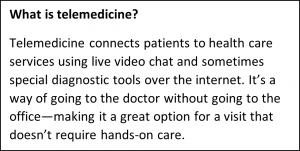
There’s no doubt that more older adults than ever are taking advantage of online doctor visits, more formally known as telemedicine. While usage numbers have risen dramatically across all age groups, it’s particularly so for elders. Pre- and post-pandemic numbers saw a 63-fold increase in Medicare telemedicine use.
However, many older patients are missing out and not using telemedicine for one reason or another. What’s holding them back? Several things, according to research from the University of California, San Francisco:
Moreover, another issue is that many older adults do not know that telemedicine is an option. Research from the University of Michigan showed that 55% of older adults surveyed were unaware if their healthcare provider even offered telemedicine as a service. And perhaps quite telling is that the same survey revealed nearly half of older adults harbored concerns about privacy and did not feel personally connected to their care provider during their visits.
For us as children and grandchildren of older adults, it can be tough knowing that a loved one is missing out on an avenue of care that they could otherwise benefit from. While we absolutely respect what they feel is comfortable and trustworthy for them, there are several other areas where we can help the older loved ones in our lives overcome the issues and concerns they face.
With that, let’s talk about the technology behind telemedicine and how you can help them use it, and address some of those privacy issues as well.
As indicated above, paying a visit to the doctor via telemedicine can be a big jump. Just as the idea of it is new for many of us, it’s yet newer for older adults. There’s a good chance that you’re familiar with video chats and calls already, which gives you a foundation we can work with when it’s time to see the doctor on a screen. That may not be the case for older adults. Add that into the privacy concerns and decades of seeing a doctor in person, you can see why some older adults simply choose to opt-out.
One way you can help is to have a few video chats with your older loved ones. In addition to the regular calls you make, you might want to try having a video chat with them from time to time. It’s an outstanding way to spend time together when you can’t be together in person, and it may develop a comfort level with the technology so that they may be willing to give telemedicine a try. You can check out my earlier article in this series that covers video chats with mom and dad, along with straightforward steps to get them up and running on the technology and how to use it.
One thing your parents will need for their visit is a reliable device that they’re comfortable using. It could be a computer or laptop, or it may be a smartphone or tablet. Note that in some cases their healthcare provider may use a telemedicine solution that has certain requirements as well, so you’ll want to see what those are and ensure that the device mom or dad has is compatible. (For example, the care provider may have an app that’s available through the Apple App Store or Google Play. Others may have an online platform that can be accessed by several different kinds of devices.)
If they’re using a smartphone or tablet, that will likely make things easier because the camera and microphone are already integrated into the device—all set up and ready to go. For a computer or laptop, you can help them get familiar with the setup, like the microphone levels, speaker volume, and camera. For audio, you can see a set of headphones or smartphone earbuds work well for them, which can help prevent audio feedback loops and simply make it easier to hear the caregiver.
If you’re looking for a little assistance with a Windows computer, you can check out this quick article for setting up the audio and this article for setting up the camera. For Macs, check out this article for audio and this article for the video.
If they don’t already have comprehensive online protection software for their devices, look into getting it. This will protect them against malware, viruses, and phishing attacks. They’ll also benefit from other features that help them manage their passwords, protect their identity, safeguard their privacy, and more.
As for privacy in general, medical information is among the most precious information any of us have. For example, here in the U.S., we have HIPPA privacy standards to protect our medical records and conversations. Yet there’s also the issue of eavesdropping, which is a risk in practically any online communication.
To help address privacy issues and concerns, health care providers will often post a set of Frequently Asked Questions (FAQ) as part of their telemedicine service. Within that, you’ll very likely find a section on personal privacy and the technologies in place to protect it. Here’s a good example of a telemedicine FAQ from the University of Washington Medicine and another example from the telemedicine page that Virginia Mason/Franciscan Health designed for its patients.
In all, if your parents have concerns about their privacy, you can absolutely assure them that it’s a valid concern. Consult the provider’s FAQ for guidance. If either of you has further questions, feel free to call the healthcare provider and speak with them.
In addition to digital security, there’s the possibility of physical eavesdropping, somebody actually listening in on their conversation from another room, apartment, or from the street. Help your older loved ones pick a place in their home where they can have some privacy and where they can’t be overheard by neighbors and passers-by. A bedroom is a fine place—or any location that’s familiar and comfortable as well. When choosing a private place, a well-lit location is important as well so that the camera captures a nice and clear image.
Additionally, you can help them prep for their visit by putting together a list of things to discuss during the visit. The U.S. Department of Health and Human Services suggests writing things down:
In addition to the above, there are further measures you can help your parents or older loved one take to further secure their telemedicine visit—and their internet usage in general.
Your telemedicine visit may require setting up a new account and password. When doing so, make sure it’s with a strong, unique password. A password manager can help. Also found in comprehensive online protection software, a password manager can create and securely store strong and unique passwords for your mom and dad, giving them one less thing they need to remember and worry about.
A VPN, or virtual private network, offers a strong layer of additional protection when you’re transmitting health data or simply having a private conversation about your health with a professional. A VPN creates an encrypted tunnel to keep you and your activity anonymous. In effect, your data is scrambled and hidden to anyone outside your VPN tunnel, thus making your private information difficult to collect. Check with the care provider to see if their telemedicine solution uses a VPN. If not, you can always get a VPN as part of your online protection software.
Beyond their devices, securing their internet router is an important step in making a telemedicine visit safe and secure. The data that travels along it is of a highly personal nature already, so make sure the router has a strong and unique password. Also, change the name of their router so it doesn’t give away their address or any other signs of their identity. One more step is to check that your router is using an encryption method, like WPA2, which will keep your signal secure. If you have questions, check with their internet provider—they may even offer up a newer, more secure router to replace an older one.
As with anything concerning their health, have your parents and loved ones consult with their caregivers to ensure that a telemedicine visit is a proper course for them.
So while the technical ins and outs of preparing for a telemedicine visit may have their challenges for some older adults, we should also realize that getting comfortable with the idea of a telemedicine visit in the first place may take some time and effort. Starting with regular video chats with the family may increase familiarity and ease with holding a conversation over video. Likewise, having a conversation with their doctor about telemedicine may put some concerns to rest as well. After all, they will have a relationship with their doctor. Getting the facts from the doctor, face to face may help.
We all want what’s best, particularly when it comes to the care of our parents and older loved ones in our lives, and choosing to try telemedicine is a highly personal decision for them. I hope this article and the resources cited within it will help you enable them to make the choice that’s comfortable, effective, and right for them.
The post Helping Mom & Dad: Online Doctor Visits and Telemedicine appeared first on McAfee Blog.

Editor’s Note: This is the third in a series of articles about how we can help our elder parents get the most out of digital life—the ways we can help them look after their finances and health online, along with how they can use the internet to keep connected with friends and family, all safely and simply.
Now here’s a great topic. Spending more quality time with our folks, even if they’re far away. That’s the beauty of a family video chat. It’s a way to connect with more than voice. It’s a way to share moments together.
If your parents and the older loved ones in your family haven’t come around to the idea of video chats just yet, now’s a good time to give it a try. Video chats are far easier to enjoy than ever, and with a little initiative from you, the family can gather around a video chat rather quickly. In fact, there’s plenty you can do to get them started.
Clearly, a video chat is different than a phone call. Beyond the technological differences, it’s quite a different way of interacting. After all, there you are, face-to-face, talking over a device. And that may feel a little awkward, especially for our parents. They’ve lived lives where long-distance conversations meant using a phone that was anchored to the kitchen wall.
So aside from the technical considerations of video chats, there’s a degree of freedom that may leave our parents wondering what to do and how to act in this new medium. Just like when we first used video chat ourselves, questions come up … Where should I be looking on the screen … How should I hold the phone … Can everyone on this call see up my nose?
You can ease them in by taking the lead, welcoming them into the notion that your video chat can be much more than a phone call. More than simply talking, it’s a chance to create a shared space together.
A great example is this: a co-worker recently told me about his in-laws who were scouting out retirement communities to live in. Even though his in-laws lived 2,000 miles away, they all got to do a little house-hunting together. Using a smartphone, they took room-to-room tours of model homes together, got views of the tree-lined streets, checked out the pools and rec centers, and so on. A few weeks later, they shared another video call where his in-laws walked the family through their new place after they’d settled in. And all of it started with a simple request, “Hey, turn on FaceTime so we can take a look too!”
So, in a way, video chats truly are an opportunity to create moments together. It could be as simple as asking grandma to read a book to the kids, have mom and dad share what they’re having for a birthday dinner, or ask them to show how hard it’s snowing outside their home. Anything you can do to encourage a little free interaction of some sort may make a video chat feel far more comfortable. You can really relax and interact once you settle in and let the possibilities unfold.
In a way, a video call is much like dropping by the house for a visit. Placing a video call unannounced may catch mom in her curlers, so to speak. Or, as we’ve heard our parents say when they looked at a messy living room, we may catch them when “the house isn’t ready for guests.” In either case, scheduling a time for a video call gives everyone time to prepare. Whether it’s sprucing up your appearance or simply getting into the headspace for a face-to-face interaction, a designated time helps everyone get ready.
On your end, it’s an opportunity for you to prepare as well. Do the kids have some recent schoolwork or a project they’re proud of? Have them bring it for some show-and-tell. Doing some cooking lately and you just can’t seem to get the family secret BBQ sauce just right? Bring your folks into the kitchen for some cooking advice. Find an old treasure in storage? Break it out and flip through your old grade-school art scrapbook with them on the call. As you prepare, think about sharing and moments, some of the things you’d like to do together over a video call. That’ll make it all the more special.
As you know, there are plenty ways to hold a video call. There’s a good chance you’ve used several platforms and apps yourself already, whether with friends, work, or a mix of both. So when it comes to picking what’s best for your video call, the question to ask here is what’s your parent’s comfort level with technology.
If your parents are pretty comfortable with technology, you can share one of my earlier articles on video calls with them, which walks through the ins and outs of different apps and options. If they’re a little less savvy with technology, ideally they have a smartphone or tablet that they can use. Chances are, that device will have video calling built right in, such as Apple’s FaceTime or Google Duo on Android devices—both of which make video calls an easier “point and shoot” experience.
Even if you’re using different devices, you can still use apps like FaceTime between Androids and iPhones. It’s rather straightforward, as all it takes is for one party or other to click a link. Additionally, Google Duo is available as an app in Apple’s App Store, which makes it easy for everyone to get on one platform as needed.
If a smartphone or tablet isn’t in the picture, there are certainly options for laptops and computers, several you may also know well already. Of the free and relatively straightforward apps out there, you can choose from:
With a free account that can run through a browser window, you and your parents can enjoy a call without having to manually download an app.
This comes standard on Windows PCs and supports apps for all kinds of tablets and smartphones too. If you want to create a video chat without an account, you can simply visit this page and start an instant video chat with a click.
Free to anyone with a free Google Gmail account, you can use Google Meet just by clicking its icon from your Google apps menu or by visiting https://meet.google.com/. Like Zoom and Skype, it can run in the window of a browser, so there’s no app to manually download.
Of course, your folks will need a camera and microphone for their computer. If they don’t have one, there are plenty of moderately priced web cameras that include a microphone. I suggest getting one with a physical lens cap. That way they can protect privacy. Of course, they can always simply disconnect it when they’re not using it.
Setting up a laptop or computer for video calls may take a little bit of work. You can help your parents by walking them through the process with these articles:
Once you’re all set up, here are a few things that you and your parents can do to help keep your calls private and secure.
If your video chap app generates a link that others can click to join in, be sure to create a password that uninvited parties can’t join in as well. Also, don’t be shy about asking your family members to use a password on the calls they initiate. It’s pretty much standard practice nowadays.
Likewise, with any chat link that’s sent to you, be sure that link is legitimate. Confirm the link with the family member who sent it, particularly if you weren’t expecting one. (This is another good reason to schedule calls. Family members will be on the lookout for that link.)
Make sure that you’re using comprehensive online protection software that helps steer you clear of scam emails and links, along with browser protection that blocks links that could send you to sketchy websites. That way, if you do get sent a bogus invite link from a scammer, you’ll be protected.
Aside from giving you the latest features and functionality, updates also often include essential security improvements. Set your computer to update itself automatically and consider using security software that will scan for vulnerabilities and install updates automatically as needed.
An interesting closing note is that getting comfortable with video chat may open a world of other possibilities as well. Perhaps once they get online and see how video chats work, they’ll reach out to other friends and them get in on it too, creating more opportunities to reach out and spend time with others. In other words, you may really start something here by getting mom and dad on video chat.
Additionally, early research has shown that older adults who use regularly technologies like video chat have seen positive impacts in their long-term memory compared to those who just interacted over the phone or in person. Similarly, research has shown that the use of technology, in general, can enhance mental health for older adults as well.
With that, I hope you’ll give it a try with your parents and older loved ones. Meet the inevitable technical bumps in the road with a smile because this journey will be absolutely worth it. For all of you.
The post Helping Mom & Dad: Family Video Chats appeared first on McAfee Blog.









Millions of U.S. government employees and contractors have been issued a secure smart ID card that enables physical access to buildings and controlled spaces, and provides access to government computer networks and systems at the cardholder’s appropriate security level. But many government employees aren’t issued an approved card reader device that lets them use these cards at home or remotely, and so turn to low-cost readers they find online. What could go wrong? Here’s one example.

A sample Common Access Card (CAC). Image: Cac.mil.
KrebsOnSecurity recently heard from a reader — we’ll call him “Mark” because he wasn’t authorized to speak to the press — who works in IT for a major government defense contractor and was issued a Personal Identity Verification (PIV) government smart card designed for civilian employees. Not having a smart card reader at home and lacking any obvious guidance from his co-workers on how to get one, Mark opted to purchase a $15 reader from Amazon that said it was made to handle U.S. government smart cards.
The USB-based device Mark settled on is the first result that currently comes up one when searches on Amazon.com for “PIV card reader.” The card reader Mark bought was sold by a company called Saicoo, whose sponsored Amazon listing advertises a “DOD Military USB Common Access Card (CAC) Reader” and has more than 11,700 mostly positive ratings.
The Common Access Card (CAC) is the standard identification for active duty uniformed service personnel, selected reserve, DoD civilian employees, and eligible contractor personnel. It is the principal card used to enable physical access to buildings and controlled spaces, and provides access to DoD computer networks and systems.
Mark said when he received the reader and plugged it into his Windows 10 PC, the operating system complained that the device’s hardware drivers weren’t functioning properly. Windows suggested consulting the vendor’s website for newer drivers.
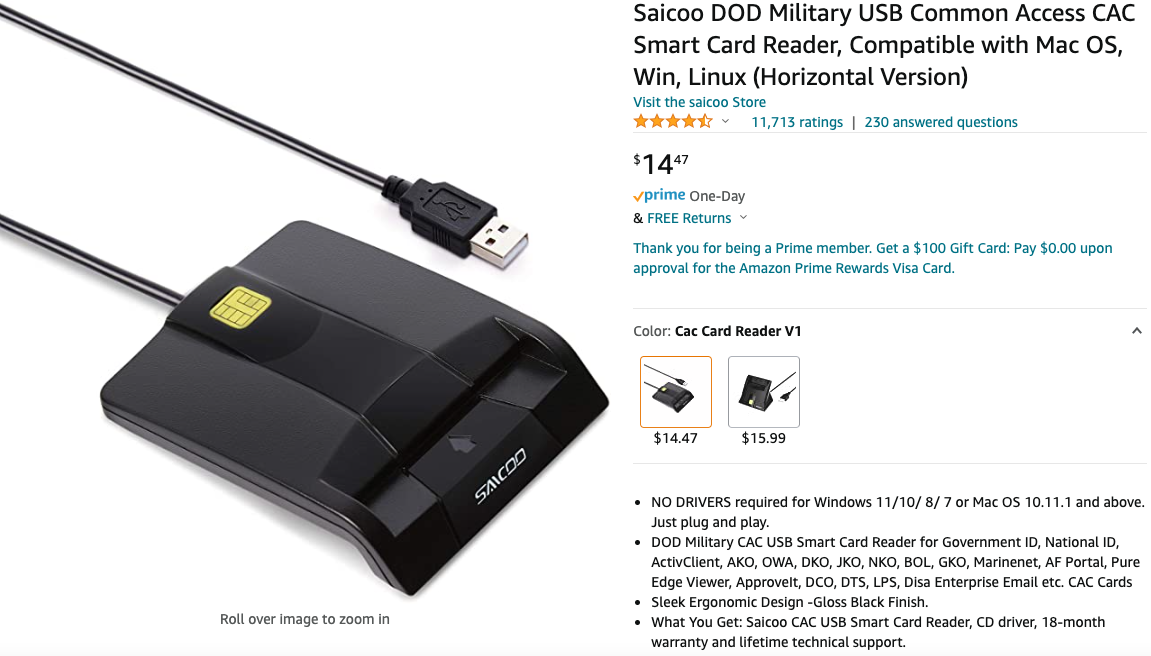
The Saicoo smart card reader that Mark purchased. Image: Amazon.com
So Mark went to the website mentioned on Saicoo’s packaging and found a ZIP file containing drivers for Linux, Mac OS and Windows:
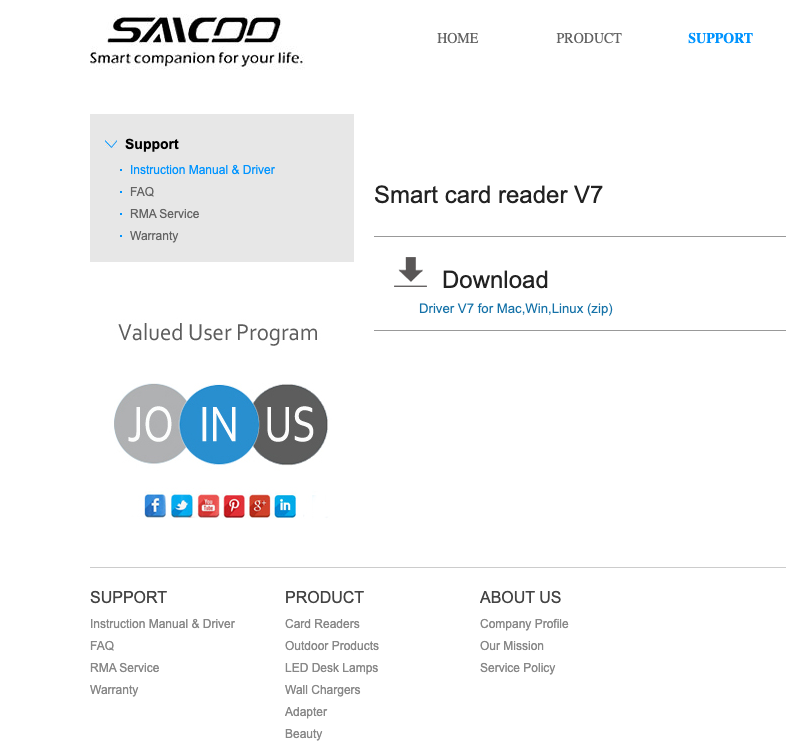
Image: Saicoo
Out of an abundance of caution, Mark submitted Saicoo’s drivers file to Virustotal.com, which simultaneously scans any shared files with more than five dozen antivirus and security products. Virustotal reported that some 43 different security tools detected the Saicoo drivers as malicious. The consensus seems to be that the ZIP file currently harbors a malware threat known as Ramnit, a fairly common but dangerous trojan horse that spreads by appending itself to other files.
Ramnit is a well-known and older threat — first surfacing more than a decade ago — but it has evolved over the years and is still employed in more sophisticated data exfiltration attacks. Amazon said in a written statement that it was investigating the reports.
“Seems like a potentially significant national security risk, considering that many end users might have elevated clearance levels who are using PIV cards for secure access,” Mark said.
Mark said he contacted Saicoo about their website serving up malware, and received a response saying the company’s newest hardware did not require any additional drivers. He said Saicoo did not address his concern that the driver package on its website was bundled with malware.
In response to KrebsOnSecurity’s request for comment, Saicoo sent a somewhat less reassuring reply.
“From the details you offered, issue may probably caused by your computer security defense system as it seems not recognized our rarely used driver & detected it as malicious or a virus,” Saicoo’s support team wrote in an email.
“Actually, it’s not carrying any virus as you can trust us, if you have our reader on hand, please just ignore it and continue the installation steps,” the message continued. “When driver installed, this message will vanish out of sight. Don’t worry.”
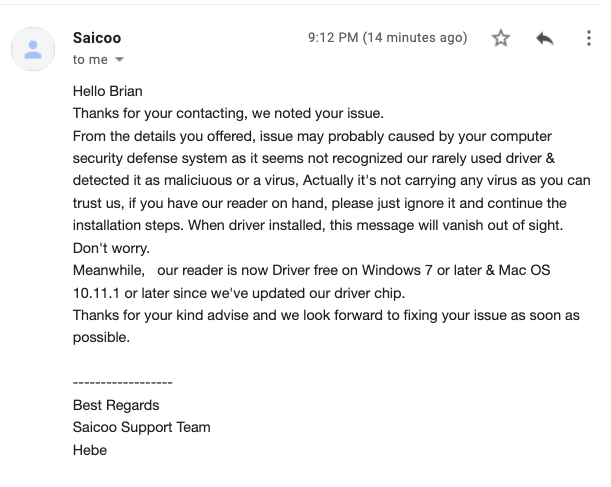
Saicoo’s response to KrebsOnSecurity.
The trouble with Saicoo’s apparently infected drivers may be little more than a case of a technology company having their site hacked and responding poorly. Will Dormann, a vulnerability analyst at CERT/CC, wrote on Twitter that the executable files (.exe) in the Saicoo drivers ZIP file were not altered by the Ramnit malware — only the included HTML files.
Dormann said it’s bad enough that searching for device drivers online is one of the riskiest activities one can undertake online.
“Doing a web search for drivers is a VERY dangerous (in terms of legit/malicious hit ratio) search to perform, based on results of any time I’ve tried to do it,” Dormann added. “Combine that with the apparent due diligence of the vendor outlined here, and well, it ain’t a pretty picture.”
But by all accounts, the potential attack surface here is enormous, as many federal employees clearly will purchase these readers from a myriad of online vendors when the need arises. Saicoo’s product listings, for example, are replete with comments from customers who self-state that they work at a federal agency (and several who reported problems installing drivers).
A thread about Mark’s experience on Twitter generated a strong response from some of my followers, many of whom apparently work for the U.S. government in some capacity and have government-issued CAC or PIV cards.
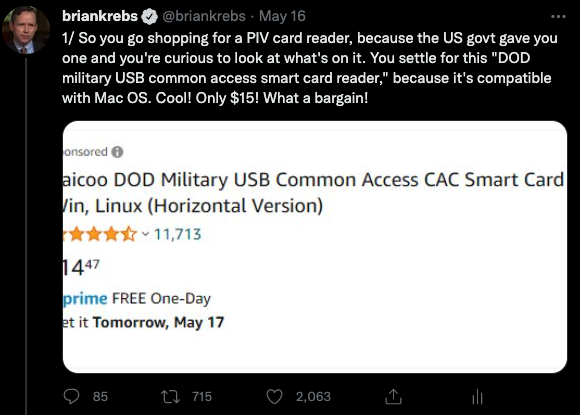
Two things emerged clearly from that conversation. The first was general confusion about whether the U.S. government has any sort of list of approved vendors. It does. The General Services Administration (GSA), the agency which handles procurement for federal civilian agencies, maintains a list of approved card reader vendors at idmanagement.gov (Saicoo is not on that list). [Thanks to @MetaBiometrics and @shugenja for the link!]
The other theme that ran through the Twitter discussion was the reality that many people find buying off-the-shelf readers more expedient than going through the GSA’s official procurement process, whether it’s because they were never issued one or the reader they were using simply no longer worked or was lost and they needed another one quickly.
“Almost every officer and NCO [non-commissioned officer] I know in the Reserve Component has a CAC reader they bought because they had to get to their DOD email at home and they’ve never been issued a laptop or a CAC reader,” said David Dixon, an Army veteran and author who lives in Northern Virginia. “When your boss tells you to check your email at home and you’re in the National Guard and you live 2 hours from the nearest [non-classified military network installation], what do you think is going to happen?”
Interestingly, anyone asking on Twitter about how to navigate purchasing the right smart card reader and getting it all to work properly is invariably steered toward militarycac.com. The website is maintained by Michael Danberry, a decorated and retired Army veteran who launched the site in 2008 (its text and link-heavy design very much takes one back to that era of the Internet and webpages in general). His site has even been officially recommended by the Army (PDF). Mark shared emails showing Saicoo itself recommends militarycac.com.

Image: Militarycac.com.
“The Army Reserve started using CAC logon in May 2006,” Danberry wrote on his “About” page. “I [once again] became the ‘Go to guy’ for my Army Reserve Center and Minnesota. I thought Why stop there? I could use my website and knowledge of CAC and share it with you.”
Danberry did not respond to requests for an interview — no doubt because he’s busy doing tech support for the federal government. The friendly message on Danberry’s voicemail instructs support-needing callers to leave detailed information about the issue they’re having with CAC/PIV card readers.
Dixon said Danberry has “done more to keep the Army running and connected than all the G6s [Army Chief Information Officers] put together.”
In many ways, Mr. Danberry is the equivalent of that little known software developer whose tiny open-sourced code project ends up becoming widely adopted and eventually folded into the fabric of the Internet. I wonder if he ever imagined 15 years ago that his website would one day become “critical infrastructure” for Uncle Sam?
In part one of this issue of our Black Hat Asia NOC blog, you will find:
Cisco Meraki was asked by Black Hat Events to be the Official Wired and Wireless Network Equipment, for Black Hat Asia 2022, in Singapore, 10-13 May 2022; in addition to providing the Mobile Device Management (since Black Hat USA 2021), Malware Analysis (since Black Hat USA 2016), & DNS (since Black Hat USA 2017) for the Network Operations Center. We were proud to collaborate with NOC partners Gigamon, IronNet, MyRepublic, NetWitness and Palo Alto Networks.

To accomplish this undertaking in a few weeks’ time, after the conference had a green light with the new COVID protocols, Cisco Meraki and Cisco Secure leadership gave their full support to send the necessary hardware, software licenses and staff to Singapore. Thirteen Cisco engineers deployed to the Marina Bay Sands Convention Center, from Singapore, Australia, United States and United Kingdom; with two additional remote Cisco engineers from the United States.
From attendee to press to volunteer – coming back to Black Hat as NOC volunteer by Humphrey Cheung
Loops in the networking world are usually considered a bad thing. Spanning tree loops and routing loops happen in an instant and can ruin your whole day, but over the 2nd week in May, I made a different kind of loop. Twenty years ago, I first attended the Black Hat and Defcon conventions – yay Caesars Palace and Alexis Park – a wide-eyed tech newbie who barely knew what WEP hacking, Driftnet image stealing and session hijacking meant. The community was amazing and the friendships and knowledge I gained, springboarded my IT career.
In 2005, I was lucky enough to become a Senior Editor at Tom’s Hardware Guide and attended Black Hat as accredited press from 2005 to 2008. From writing about the latest hardware zero-days to learning how to steal cookies from the master himself, Robert Graham, I can say, without any doubt, Black Hat and Defcon were my favorite events of the year.
Since 2016, I have been a Technical Solutions Architect at Cisco Meraki and have worked on insanely large Meraki installations – some with twenty thousand branches and more than a hundred thousand access points, so setting up the Black Hat network should be a piece of cake right? Heck no, this is unlike any network you’ve experienced!
As an attendee and press, I took the Black Hat network for granted. To take a phrase that we often hear about Cisco Meraki equipment, “it just works”. Back then, while I did see access points and switches around the show, I never really dived into how everything was set up.

A serious challenge was to secure the needed hardware and ship it in time for the conference, given the global supply chain issues. Special recognition to Jeffry Handal for locating the hardware and obtaining the approvals to donate to Black Hat Events. For Black Hat Asia, Cisco Meraki shipped:
Let’s start with availability. iPads and iPhones are scanning QR codes to register attendees. Badge printers need access to the registration system. Training rooms all have their separate wireless networks – after all, Black Hat attendees get a baptism by fire on network defense and attack. To top it all off, hundreds of attendees gulped down terabytes of data through the main conference wireless network.
All this connectivity was provided by Cisco Meraki access points, switches, security appliances, along with integrations into SecureX, Umbrella and other products. We fielded a literal army of engineers to stand up the network in less than two days… just in time for the training sessions on May 10 to 13th and throughout the Black Hat Briefings and Business Hall on May 12 and 13.
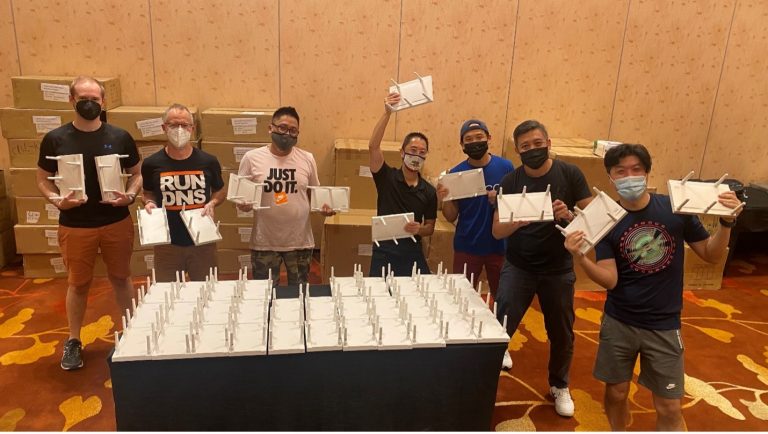
Let’s talk security and visibility. For a few days, the Black Hat network is probably one of the most hostile in the world. Attendees learn new exploits, download new tools and are encouraged to test them out. Being able to drill down on attendee connection details and traffic was instrumental on ensuring attendees didn’t get too crazy.
On the wireless front, we made extensive use of our Radio Profiles to reduce interference by tuning power and channel settings. We enabled band steering to get more clients on the 5GHz bands versus 2.4GHz and watched the Location Heatmap like a hawk looking for hotspots and dead areas. Handling the barrage of wireless change requests – enable or disabling this SSID, moving VLANs (Virtual Local Area Networks), enabling tunneling or NAT mode, – was a snap with the Meraki Dashboard.
While the Cisco Meraki Dashboard is extremely powerful, we happily supported exporting of logs and integration in major event collectors, such as the NetWitness SIEM and even the Palo Alto firewall. On Thursday morning, the NOC team found a potentially malicious Macbook Pro performing vulnerability scans against the Black Hat management network. It is a balance, as we must allow trainings and demos connect to malicious websites, download malware and execute. However, there is a Code of Conduct to which all attendees are expected to follow and is posted at Registration with a QR code.
The Cisco Meraki network was exporting syslog and other information to the Palo Alto firewall, and after correlating the data between the Palo Alto Dashboard and Cisco Meraki client details page, we tracked down the laptop to the Business Hall.

We briefed the NOC management, who confirmed the scanning was violation of the Code of Conduct, and the device was blocked in the Meraki Dashboard, with the instruction to come to the NOC.

The device name and location made it very easy to determine to whom it belonged in the conference attendees.

A delegation from the NOC went to the Business Hall, politely waited for the demo to finish at the booth and had a thoughtful conversation with the person about scanning the network. 
Coming back to Black Hat as a NOC volunteer was an amazing experience. While it made for long days with little sleep, I really can’t think of a better way to give back to the conference that helped jumpstart my professional career.
Meraki MR, MS, MX and Systems Manager by Paul Fidler
With the invitation extended to Cisco Meraki to provide network access, both from a wired and wireless perspective, there was an opportunity to show the value of the Meraki platform integration capabilities of Access Points (AP), switches, security appliances and mobile device management.

The first amongst this was the use of the Meraki API. We were able to import the list of MAC addresses of the Meraki MRs, to ensure that the APs were named appropriately and tagged, using a single source of truth document shared with the NOC management and partners, with the ability to update en masse at any time.
On the first day of NOC setup, the Cisco team walked around the venue to discuss AP placements with the staff of the Marina Bay Sands. Whilst we had a simple Powerpoint showing approximate AP placements for the conference, it was noted that the venue team had an incredibly detailed floor plan of the venue. This was acquired in PDF and uploaded into the Meraki Dashboard; and with a little fine tuning, aligned perfectly with the Google Map.
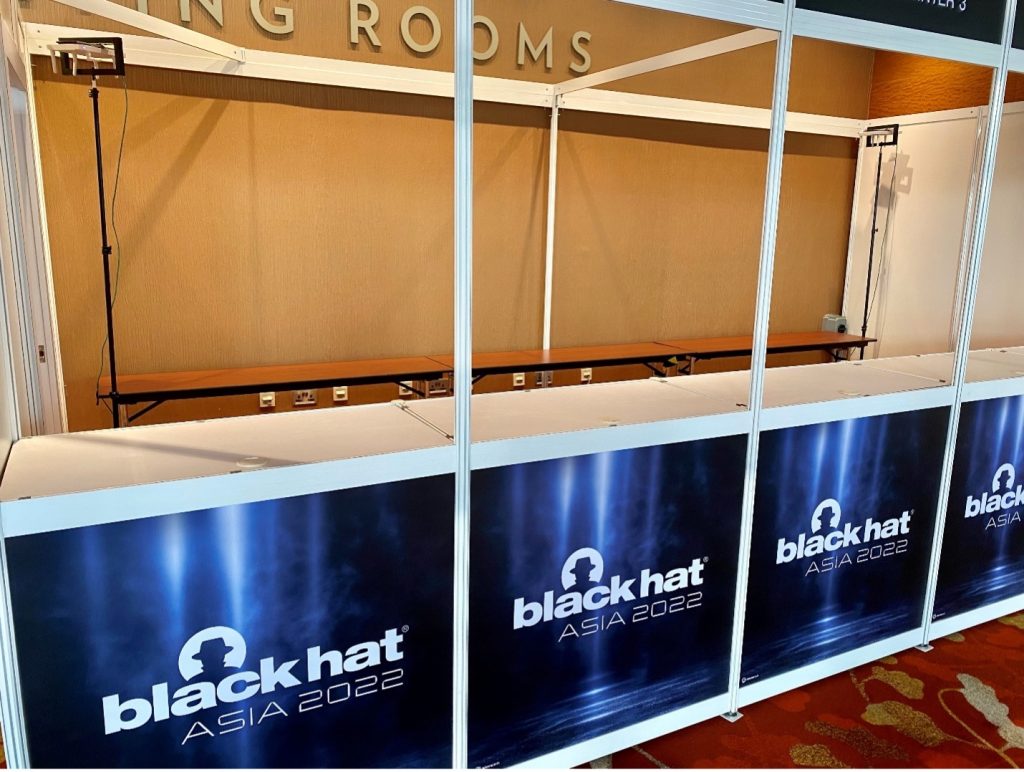
Meraki APs were then placed physically in the venue meeting and training rooms, and very roughly on the floor plan. One of the team members then used a printout of the floor plan to mark accurately the placement of the APs. Having the APs named, as mentioned above, made this an easy task (walking around the venue notwithstanding!). This enabled accurate heatmap capability.
The Location Heatmap was a new capability for Black Hat NOC, and the client data visualized in NOC continued to be of great interest to the Black Hat management team, such as which training, briefing and sponsor booths drew the most interest.

The ability to use SSID Availability was incredibly useful. It allowed ALL of the access points to be placed within a single Meraki Network. Not only that, because of the training events happening during the week, as well as TWO dedicated SSIDs for the Registration and lead tracking iOS devices (more of which later), one for initial provisioning (which was later turned off), and one for certificated based authentication, for a very secure connection.
We were able to monitor the number of connected clients, network usage, the persons passing by the network and location analytics, throughout the conference days. We provided visibility access to the Black Hat NOC management and the technology partners (along with full API access), so they could integrate with the network platform.



Meraki alerts are exactly that: the ability to be alerted to something that happens in the Dashboard. Default behavior is to be emailed when something happens. Obviously, emails got lost in the noise, so a web hook was created in SecureX orchestration to be able to consume Meraki alerts and send it to Slack (the messaging platform within the Black Hat NOC), using the native template in the Meraki Dashboard. The first alert to be created was to be alerted if an AP went down. We were to be alerted after five minutes of an AP going down, which is the smallest amount of time available before being alerted.

The bot was ready; however, the APs stayed up the entire time!
Applying the lessons learned at Black Hat Europe 2021, for the initial configuration of the conference iOS devices, we set up the Registration iPads and lead retrieval iPhones with Umbrella, Secure Endpoint and WiFi config. Devices were, as in London, initially configured using Apple Configurator, to both supervise and enroll the devices into a new Meraki Systems Manager instance in the Dashboard.

However, Black Hat Asia 2022 offered us a unique opportunity to show off some of the more integrated functionality.
System Apps were hidden and various restrictions (disallow joining of unknown networks, disallow tethering to computers, etc.) were applied, as well as a standard WPA2 SSID for the devices that the device vendor had set up (we gave them the name of the SSID and Password).
We also stood up a new SSID and turned-on Sentry, which allows you to provision managed devices with, not only the SSID information, but also a dynamically generated certificate. The certificate authority and radius server needed to do this 802.1x is included in the Meraki Dashboard automatically! When the device attempts to authenticate to the network, if it doesn’t have the certificate, it doesn’t get access. This SSID, using SSID availability, was only available to the access points in the Registration area.
Using the Sentry allowed us to easily identify devices in the client list.

One of the alerts generated with SysLog by Meraki, and then viewable and correlated in the NetWitness SIEM, was a ‘De Auth’ event that came from an access point. Whilst we had the IP address of the device, making it easy to find, because the event was a de auth, meaning 802.1x, it narrowed down the devices to JUST the iPads and iPhones used for registration (as all other access points were using WPA2). This was further enhanced by seeing the certificate name used in the de-auth:

Along with the certificate name was the name of the AP: R**
One of the inherent problems with iOS device location is when devices are used indoors, as GPS signals just aren’t strong enough to penetrate modern buildings. However, because the accurate location of the Meraki access points was placed on the floor plan in the Dashboard, and because the Meraki Systems Manager iOS devices were in the same Dashboard organization as the access points, we got to see a much more accurate map of devices compared to Black Hat Europe 2021 in London.

When the conference Registration closed on the last day and the Business Hall Sponsors all returned their iPhones, we were able to remotely wipe all of the devices, removing all attendee data, prior to returning to the device contractor.

Meraki Scanning API Receiver by Christian Clasen
Leveraging the ubiquity of both WiFi and Bluetooth radios in mobile devices and laptops, Cisco Meraki’s wireless access points can detect and provide location analytics to report on user foot traffic behavior. This can be useful in retail scenarios where customers desire location and movement data to better understand the trends of engagement in their physical stores.
Meraki can aggregate real-time data of detected WiFi and Bluetooth devices and triangulate their location rather precisely when the floorplan and AP placement has been diligently designed and documented. At the Black Hat Asia conference, we made sure to properly map the AP locations carefully to ensure the highest accuracy possible.
This scanning data is available for clients whether they are associated with the access points or not. At the conference, we were able to get very detailed heatmaps and time-lapse animations representing the movement of attendees throughout the day. This data is valuable to conference organizers in determining the popularity of certain talks, and the attendance at things like keynote presentations and foot traffic at booths.
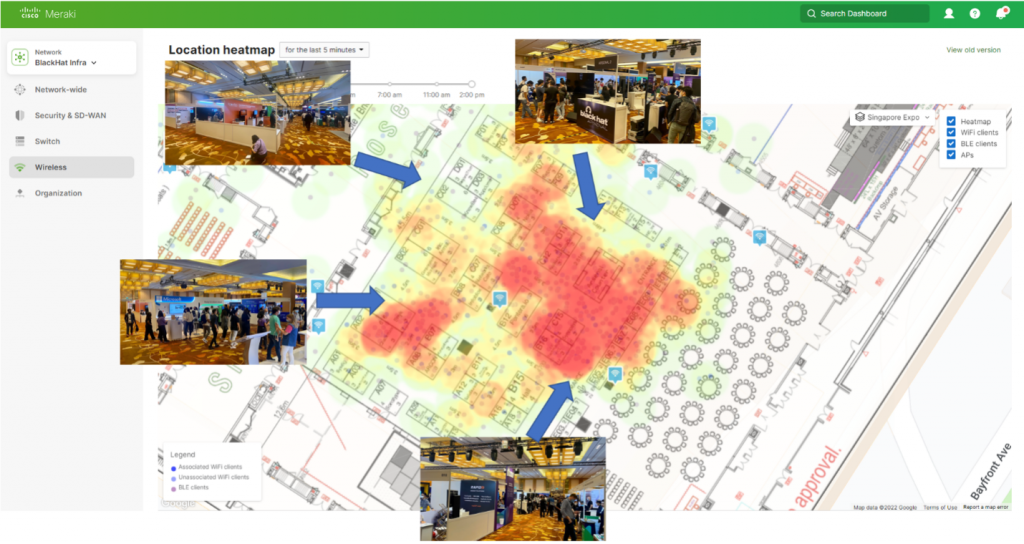
This was great for monitoring during the event, but the Dashboard would only provide 24-hours of scanning data, limiting what we could do when it came to long-term data analysis. Fortunately for us, Meraki offers an API service we can use to capture this treasure trove offline for further analysis. We only needed to build a receiver for it.
The Scanning API requires that the customer stand up infrastructure to store the data, and then register with the Meraki cloud using a verification code and secret. It is composed of two endpoints:
Returns the validator string in the response body
[GET] https://yourserver/
This endpoint is called by Meraki to validate the receiving server. It expects to receive a string that matches the validator defined in the Meraki Dashboard for the respective network.
Accepts an observation payload from the Meraki cloud
[POST] https://yourserver/
This endpoint is responsible for receiving the observation data provided by Meraki. The URL path should match that of the [GET] request, used for validation.
The response body will consist of an array of JSON objects containing the observations at an aggregate per network level. The JSON will be determined based on WiFi or BLE device observations as indicated in the type parameter.

What we needed was a simple technology stack that would contain (at minimum) a publicly accessible web server capable of TLS. In the end, the simplest implementation was a web server written using Python Flask, in a Docker container, deployed in AWS, connected through ngrok.
In fewer than 50 lines of Python, we could accept the inbound connection from Meraki and reply with the chosen verification code. We would then listen for the incoming POST data and dump it into a local data store for future analysis. Since this was to be a temporary solution (the duration of the four-day conference), the thought of registering a public domain and configuring TLS certificates wasn’t particularly appealing. An excellent solution for these types of API integrations is ngrok (https://ngrok.com/). And a handy Python wrapper was available for simple integration into the script (https://pyngrok.readthedocs.io/en/latest/index.html).
We wanted to easily re-use this stack next time around, so it only made sense to containerize it in Docker. This way, the whole thing could be stood up at the next conference, with one simple command. The image we ended up with would mount a local volume, so that the ingested data would remain persistent across container restarts.
Ngrok allowed us to create a secure tunnel from the container that could be connected in the cloud to a publicly resolvable domain with a trusted TLS certificate generated for us. Adding that URL to the Meraki Dashboard is all we needed to do start ingesting the massive treasure trove of location data from the Aps – nearly 1GB of JSON over 24 hours.

This “quick and dirty” solution illustrated the importance of interoperability and openness in the technology space when enabling security operations to gather and analyze the data they require to monitor and secure events like Black Hat, and their enterprise networks as well. It served us well during the conference and will certainly be used again going forward.

Check out part two of the blog, Black Hat Asia 2022 Continued: Cisco Secure Integrations, where we will discuss integrating NOC operations and making your Cisco Secure deployment more effective:
Acknowledgements: Special thanks to the Cisco Meraki and Cisco Secure Black Hat NOC team: Aditya Sankar, Aldous Yeung, Alejo Calaoagan, Ben Greenbaum, Christian Clasen, Felix H Y Lam, George Dorsey, Humphrey Cheung, Ian Redden, Jeffrey Chua, Jeffry Handal, Jonny Noble, Matt Vander Horst, Paul Fidler and Steven Fan.
Also, to our NOC partners NetWitness (especially David Glover), Palo Alto Networks (especially James Holland), Gigamon, IronNet (especially Bill Swearington), and the entire Black Hat / Informa Tech staff (especially Grifter ‘Neil Wyler’, Bart Stump, James Pope, Steve Fink and Steve Oldenbourg).
For more than 20 years, Black Hat has provided attendees with the very latest in information security research, development, and trends. These high-profile global events and trainings are driven by the needs of the security community, striving to bring together the best minds in the industry. Black Hat inspires professionals at all career levels, encouraging growth and collaboration among academia, world-class researchers, and leaders in the public and private sectors. Black Hat Briefings and Trainings are held annually in the United States, Europe and Asia. More information is available at: blackhat.com. Black Hat is brought to you by Informa Tech.
We’d love to hear what you think. Ask a Question, Comment Below, and Stay Connected with Cisco Secure on social!
Cisco Secure Social Channels
In part one of our Black Hat Asia 2022 NOC blog, we discussed building the network with Meraki:
In this part two, we will discuss:
SecureX: Bringing Threat Intelligence Together by Ian Redden
In addition to the Meraki networking gear, Cisco Secure also shipped two Umbrella DNS virtual appliances to Black Hat Asia, for internal network visibility with redundancy, in addition to providing:

Cisco Secure Threat Intelligence (correlated through SecureX)
Donated Partner Threat Intelligence (correlated through SecureX)
alphaMountain.ai threat intelligence
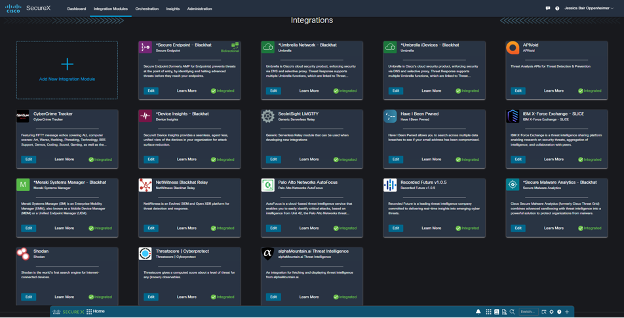
Open-Source Threat Intelligence (correlated through SecureX)
Continued Integrations from past Black Hat events
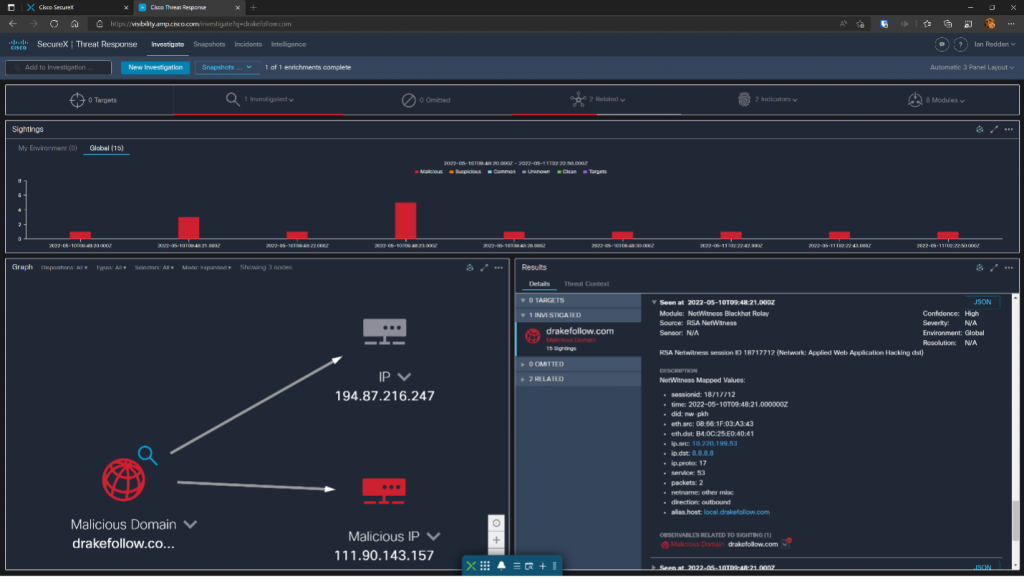
New Integrations Created at Black Hat Asia 2022
Device type spoofing event by Jonny Noble
Overview
During the conference, a NOC Partner informed us that they received an alert from May 10 concerning an endpoint client that accessed two domains that they saw as malicious:
Client details from Partner:
Based on the user agent, the partner derived that the device type was an Apple iPhone.
SecureX analysis
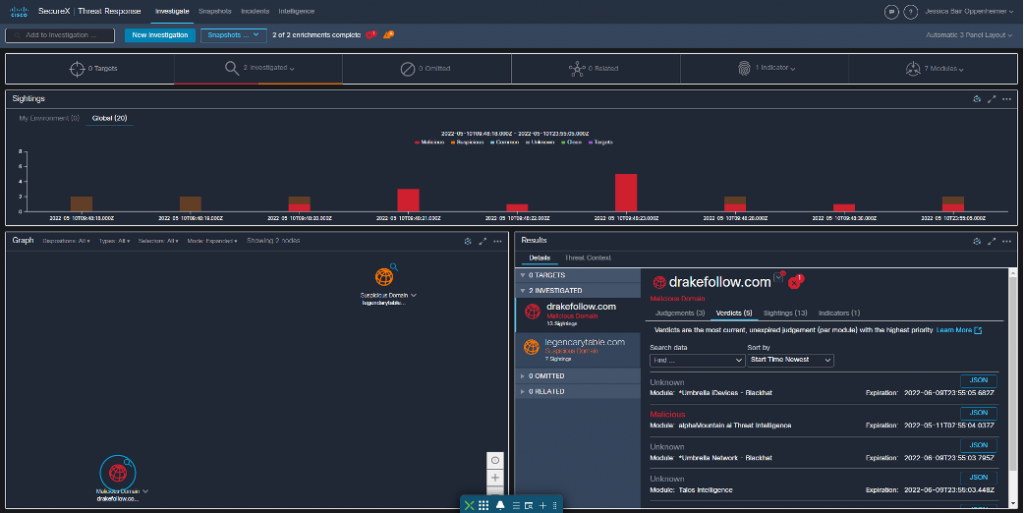
Umbrella Investigate analysis
Umbrella Investigate positions both domains as low risk, both registered recently in Poland, and both hosted on the same IP:

Despite the low-risk score, the nameservers have high counts of malicious associated domains:

Targeting users in ASA, UK, and Nigeria:

Meraki analysis
Based on the time of the incident, we can trace the device’s location (based on its IP address). This is thanks to the effort we invested in mapping out the exact location of all Meraki APs, which we deployed across the convention center with an overlay of the event map covering the area of the event:
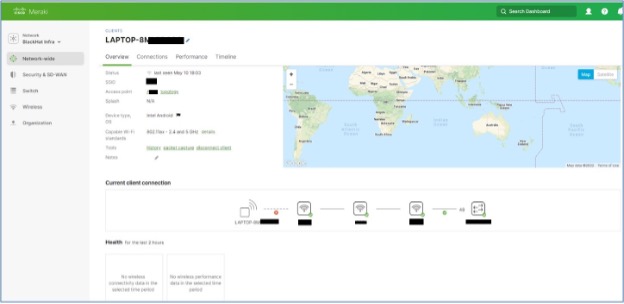
Further analysis and conclusions
The device name (LAPTOP-8MLGXXXXXX) and MAC address seen (f4:XX:XX:XX:XX:XX) both matched across the partner and Meraki, so there was no question that we were analyzing the same device.
Based on the useragent captured by the partner, the device type was an Apple iPhone. However, Meraki was reporting the Device and its OS as “Intel, Android”
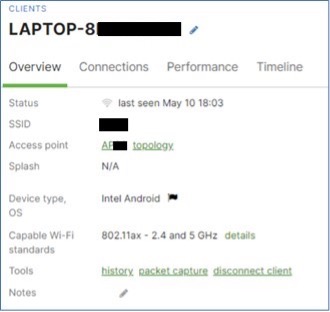
A quick look up for the MAC address confirmed that the OUI (organizationally unique identifier) for f42679 was Intel Malaysia, making it unlikely that this was an Apple iPhone.
The description for the training “Web Hacking Black Belt Edition” can be seen here:
https://www.blackhat.com/asia-22/training/schedule/#web-hacking-black-belt-edition–day-25388
It is highly likely that the training content included the use of tools and techniques for spoofing the visibility of useragent or device type.
There is also a high probability that the two domains observed were used as part of the training activity, rather than this being part of a live attack.
It is clear that integrating the various Cisco technologies (Meraki wireless infrastructure, SecureX, Umbrella, Investigate) used in the investigation of this incident, together with the close partnership and collaboration of our NOC partners, positioned us where we needed to be and provided us with the tools we needed to swiftly collect the data, join the dots, make conclusions, and successfully bring the incident to closure.
Self Service with SecureX Orchestration and Slack by Matt Vander Horst
Overview
Since Meraki was a new platform for much of the NOC’s staff, we wanted to make information easier to gather and enable a certain amount of self-service. Since the Black Hat NOC uses Slack for messaging, we decided to create a Slack bot that NOC staff could use to interact with the Meraki infrastructure as well as Palo Alto Panorama using the SecureX Orchestration remote appliance. When users communicate with the bot, webhooks are sent to Cisco SecureX Orchestration to do the work on the back end and send the results back to the user.
Design
Here’s how this integration works:

Workflow #1: Handle Slash Commands
Slash commands are a special type of message built into Slack that allow users to interact with a bot. When a Slack user executes a slash command, the command and its arguments are sent to SecureX Orchestration where a workflow handles the command. The table below shows a summary of the slash commands our bot supported for Black Hat Asia 2022:
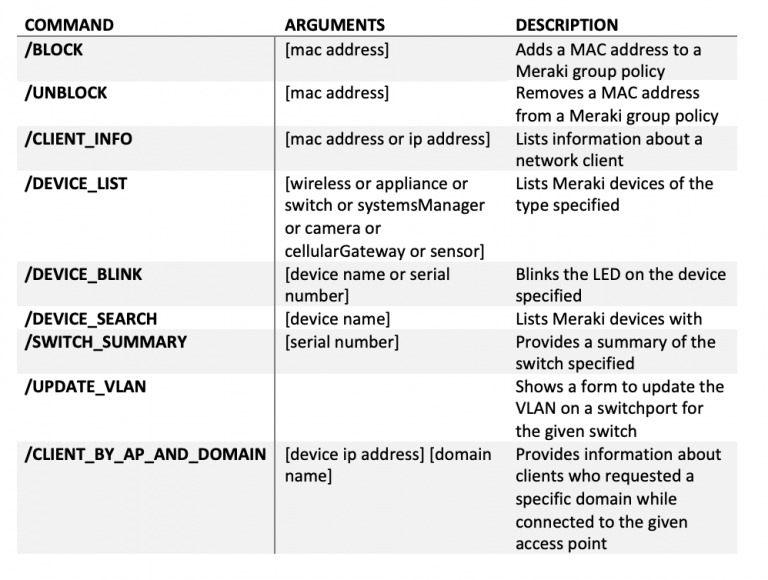

Here’s a sample of a portion of the SecureX Orchestration workflow that powers the above commands:
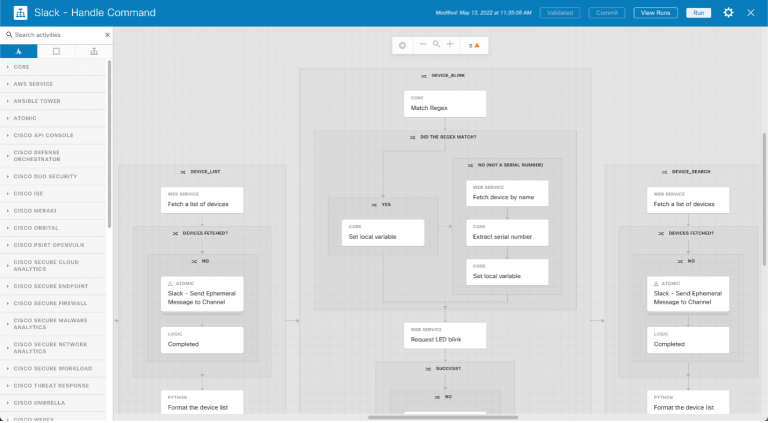
And here’s a sample of firewall logs as returned from the “/pan_traffic_history” command:
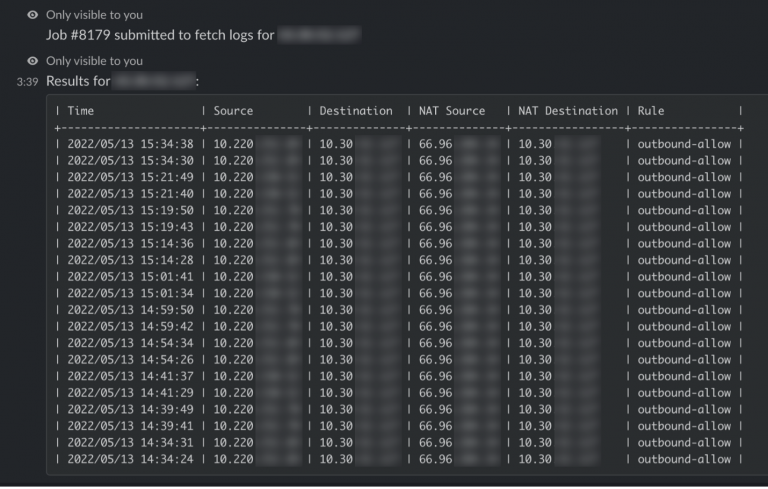
Workflow #2: Handle Interactivity
A more advanced form of user interaction comes in the form of Slack blocks. Instead of including a command’s arguments in the command itself, you can execute the command and Slack will present you with a form to complete, like this one for the “/update_vlan” command:

These forms are much more user friendly and allow information to be pre-populated for the user. In the example above, the user can simply select the switch to configure from a drop-down list instead of having to enter its name or serial number. When the user submits one of these forms, a webhook is sent to SecureX Orchestration to execute a workflow. The workflow takes the requested action and sends back a confirmation to the user:

Conclusion
While these two workflows only scratched the surface of what can be done with SecureX Orchestration webhooks and Slack, we now have a foundation that can be easily expanded upon going forward. We can add additional commands, new forms of interactivity, and continue to enable NOC staff to get the information they need and take necessary action. The goal of orchestration is to make life simpler, whether it is by automating our interactions with technology or making those interactions easier for the user.
Future Threat Vectors to Consider – Cloud App Discovery by Alejo Calaoagan
Since 2017 (starting in Black Hat USA – Las Vegas), Cisco Umbrella has provided DNS security to the Black Hat attendee network, added layers of traffic visibility previously not seen. Our efforts have largely been successful, identifying thousands of threats over the years and mitigating them via Umbrella’s blocking capabilities when necessary. This was taken a step further at Black Hat London 2021, where we introduced our Virtual Appliances to provide source IP attribution to the devices making requests.

Here at Black Hat Asia 2022, we’ve been noodling on additional ways to provide advanced protection for future shows, and it starts with Umbrella’s Cloud Application Discovery’s feature, which identified 2,286 unique applications accessed by users on the attendee network across the four-day conference. Looking at a snapshot from a single day of the show, Umbrella captured 572,282 DNS requests from all cloud apps, with over 42,000 posing either high or very high risk.
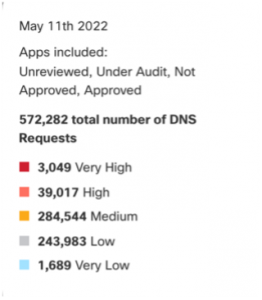
Digging deeper into the data, we see not only the types of apps being accessed…

…but also see the apps themselves…
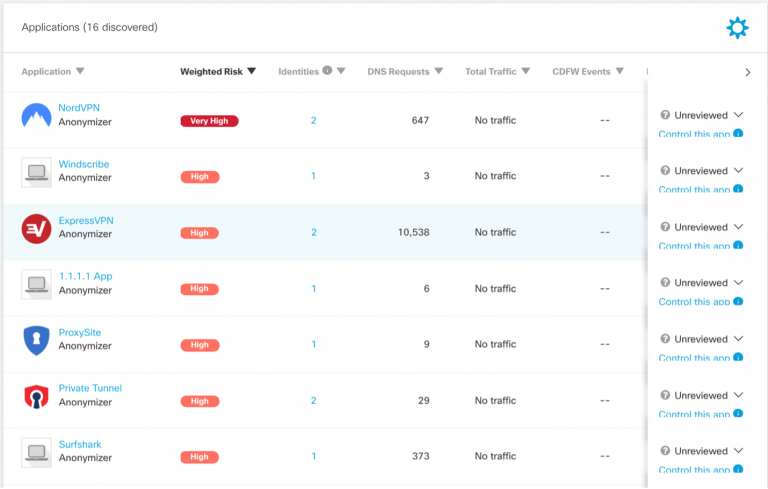
…and we can flag apps that look suspicious.

We also include risk downs breaks by category…
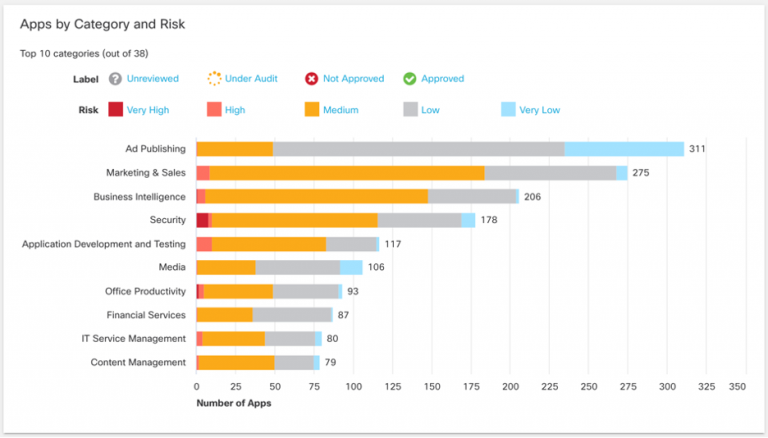
…and drill downs on each.

While this data alone won’t provide enough information to take action, including this data in analysis, something we have been doing, may provide a window into new threat vectors that may have previously gone unseen. For example, if we identify a compromised device infected with malware or a device attempting to access things on the network that are restricted, we can dig deeper into the types of cloud apps those devices are using and correlate that data with suspicious request activity, potential uncovering tools we should be blocking in the future.
I can’t say for certain how much this extra data set will help us uncover new threats, but, with Black Hat USA just around the corner, we’ll find out soon.
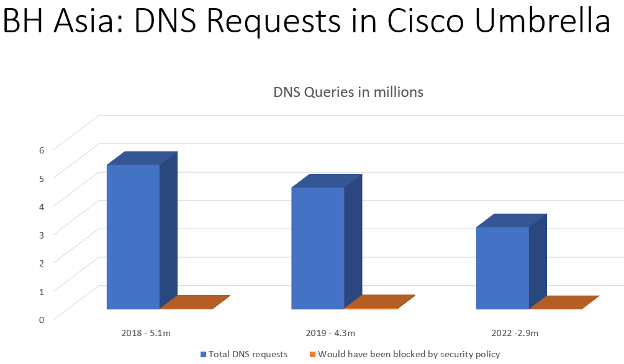
Using SecureX sign-on to streamline access to the Cisco Stack at Black Hat by Adi Sankar
From five years ago to now, Cisco has tremendously expanded our presence at Black Hat to include a multitude of products. Of course, sign-on was simple when it was just one product (Secure Malware Analytics) and one user to log in. When it came time to add a new technology to the stack it was added separately as a standalone product with its own method of logging in. As the number of products increased, so did the number of Cisco staff at the conference to support these products. This means sharing usernames and passwords became tedious and not to mention insecure, especially with 15 Cisco staff, plus partners, accessing the platforms.
The Cisco Secure stack at Black Hat includes SecureX, Umbrella, Malware Analytics, Secure Endpoint (iOS clarity), and Meraki. All of these technologies support using SAML SSO natively with SecureX sign-on. This means that each of our Cisco staff members can have an individual SecureX sign-on account to log into the various consoles. This results in better role-based access control, better audit logging and an overall better login experience. With SecureX sign-on we can log into all the products only having to type a password one time and approve one Cisco DUO Multi-Factor Authentication (MFA) push.
How does this magic work behind the scenes? It’s actually rather simple to configure SSO for each of the Cisco technologies, since they all support SecureX sign-on natively. First and foremost, you must set up a new SecureX org by creating a SecureX sign-on account, creating a new organization and integrating at least one Cisco technology. In this case I created a new SecureX organization for Black Hat and added the Secure Endpoint module, Umbrella Module, Meraki Systems Manager module and the Secure Malware Analytics module. Then from Administration à Users in SecureX, I sent an invite to the Cisco staffers that would be attending the conference, which contained a link to create their account and join the Blackhat SecureX organization. Next let’s take a look at the individual product configurations.
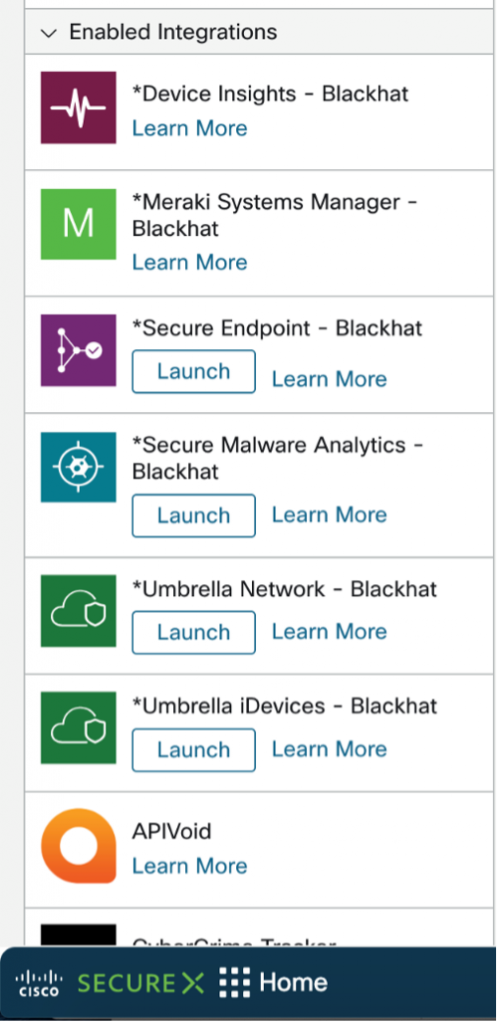

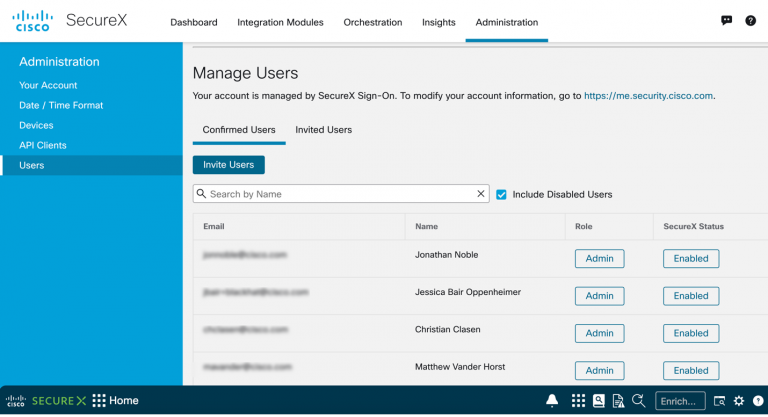
Meraki:
In the Meraki organization settings enable SecureX sign-on. Then under Organization à Administrators add a new user and specify SecureX sign-on as the authentication method. Meraki even lets you limit users to particular networks and set permission levels for those networks. Accepting the email invitation is easy since the user should already be logged into their SecureX sign-on account. Now, logging into Meraki only requires an email address and no password or additional DUO push.
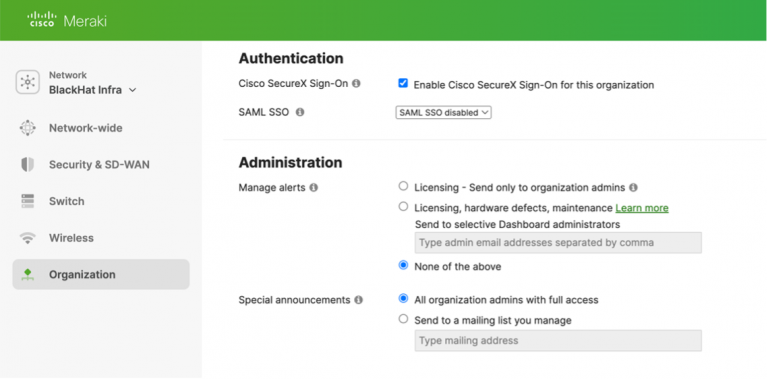
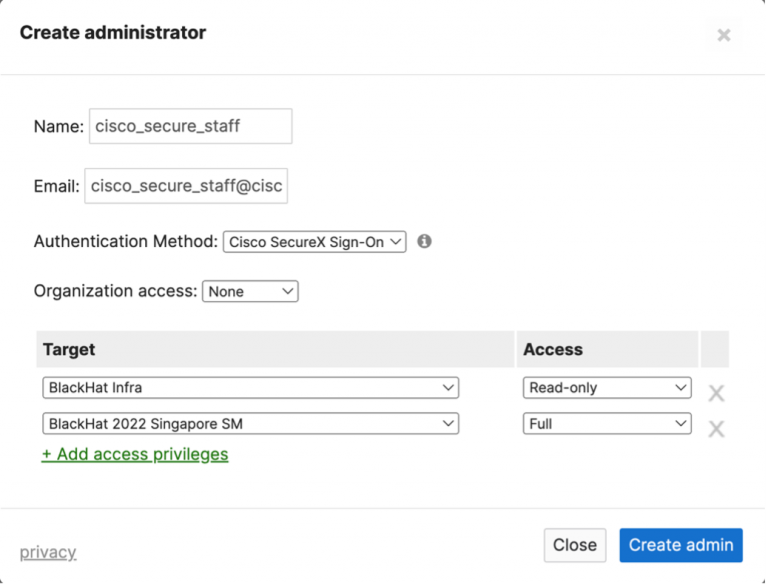
Umbrella:
Under Admin à Authentication configure SecureX sign-on which requires a test login to ensure you can still login before using SSO for authentication to Umbrella. There is no need to configure MFA in Umbrella since SecureX sign-on comes with built in DUO MFA. Existing users and any new users added in Umbrella under Admin à Accounts will now be using SecureX sign-on to login to Umbrella. Logging into Umbrella is now a seamless launch from the SecureX dashboard or from the SecureX ribbon in any of the other consoles.
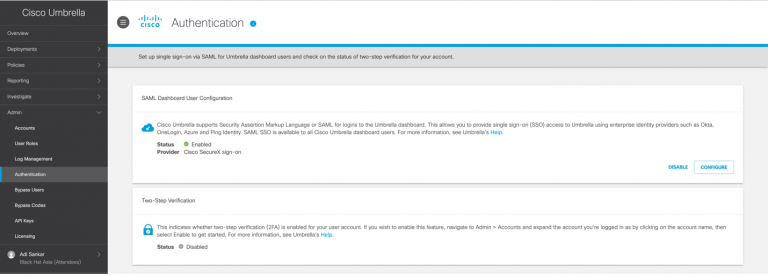

Secure Malware Analytics:
A Secure Malware Analytics organization admin can create new users in their Threat Grid tenant. This username is unique to Malware Analytics, but it can be connected to a SecureX sign-on account to take advantage of the seamless login flow. From the email invitation the user will create a password for their Malware Analytics user and accept the EULA. Then in the top right under My Malware Analytics Account, the user has an option to connect their SecureX sign-on account which is a one click process if already signed in with SecureX sign-on. Now when a user navigates to Malware Analytics login page, simply clicking “Login with SecureX Sign-On” will grant them access to the console.
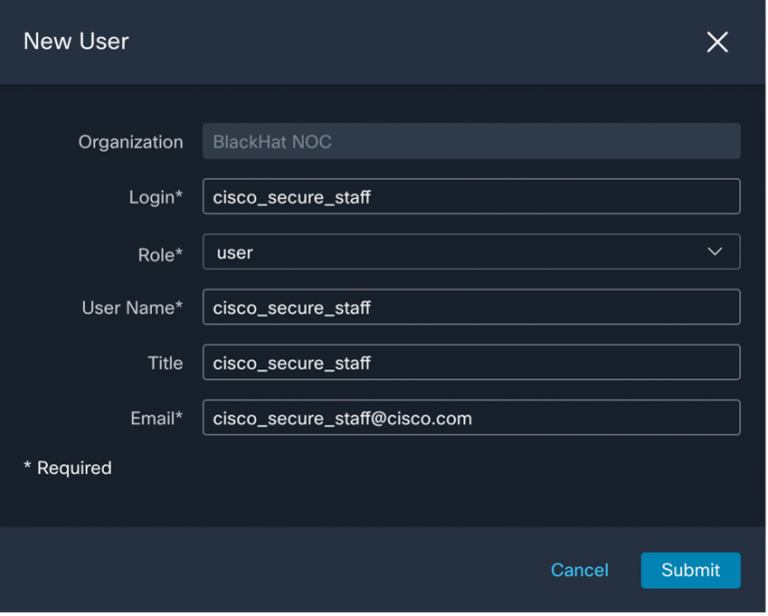

Secure Endpoint:
The Secure Endpoint deployment at Blackhat is limited to IOS clarity through Meraki Systems Manager for the conference IOS devices. Most of the asset information we need about the iPhones/iPads is brought in through the SecureX Device Insights inventory. However, for initial configuration and to view device trajectory it is required to log into Secure Endpoint. A new Secure Endpoint account can be created under Accounts à Users and an invite is sent to corresponding email address. Accepting the invite is a smooth process since the user is already signed in with SecureX sign-on. Privileges for the user in the Endpoint console can be granted from within the user account.
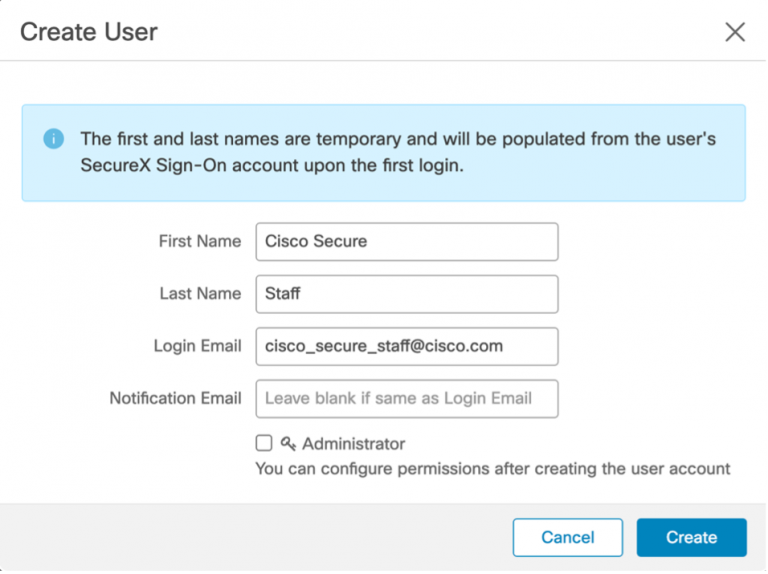
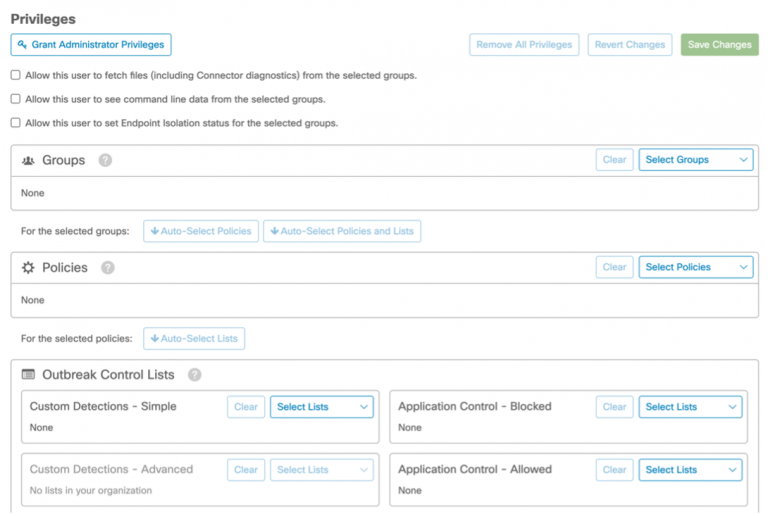
Conclusion:
To sum it all up, SecureX sign-on is the standard for the Cisco stack moving forward. With a new SecureX organization instantiated using SecureX sign-on any new users to the Cisco stack at Black Hat will be using SecureX sign-on. SecureX sign-on has helped our user management be much more secure as we have expanded our presence at Black Hat. SecureX sign-on provides a unified login mechanism for all the products and modernized our login experience at the conference.
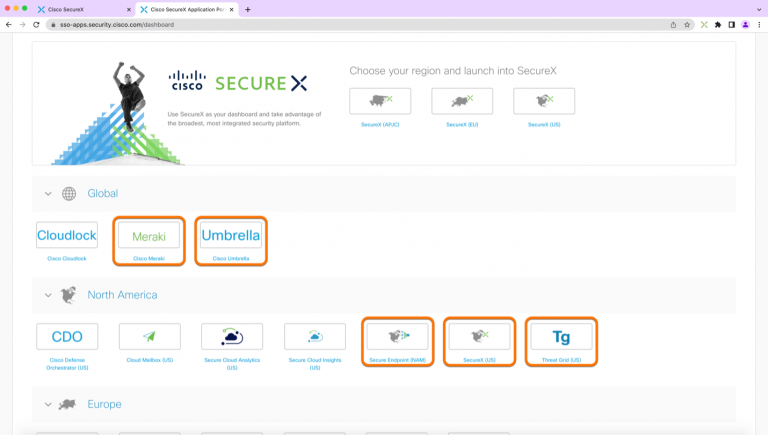
Malware Threat Intelligence made easy and available, with Cisco Secure Malware Analytics and SecureX by Ben Greenbaum
I’d gotten used to people’s reactions upon seeing SecureX in use for the first time. A few times at Black Hat, a small audience gathered just to watch us effortlessly correlate data from multiple threat intelligence repositories and several security sensor networks in just a few clicks in a single interface for rapid sequencing of events and an intuitive understanding of security events, situations, causes, and consequences. You’ve already read about a few of these instances above. Here is just one example of SecureX automatically putting together a chronological history of observed network events detected by products from two vendors (Cisco Umbrella and NetWitness) . The participation of NetWitness in this and all of our other investigations was made possible by our open architecture, available APIs and API specifications, and the creation of the NetWitness module described above.
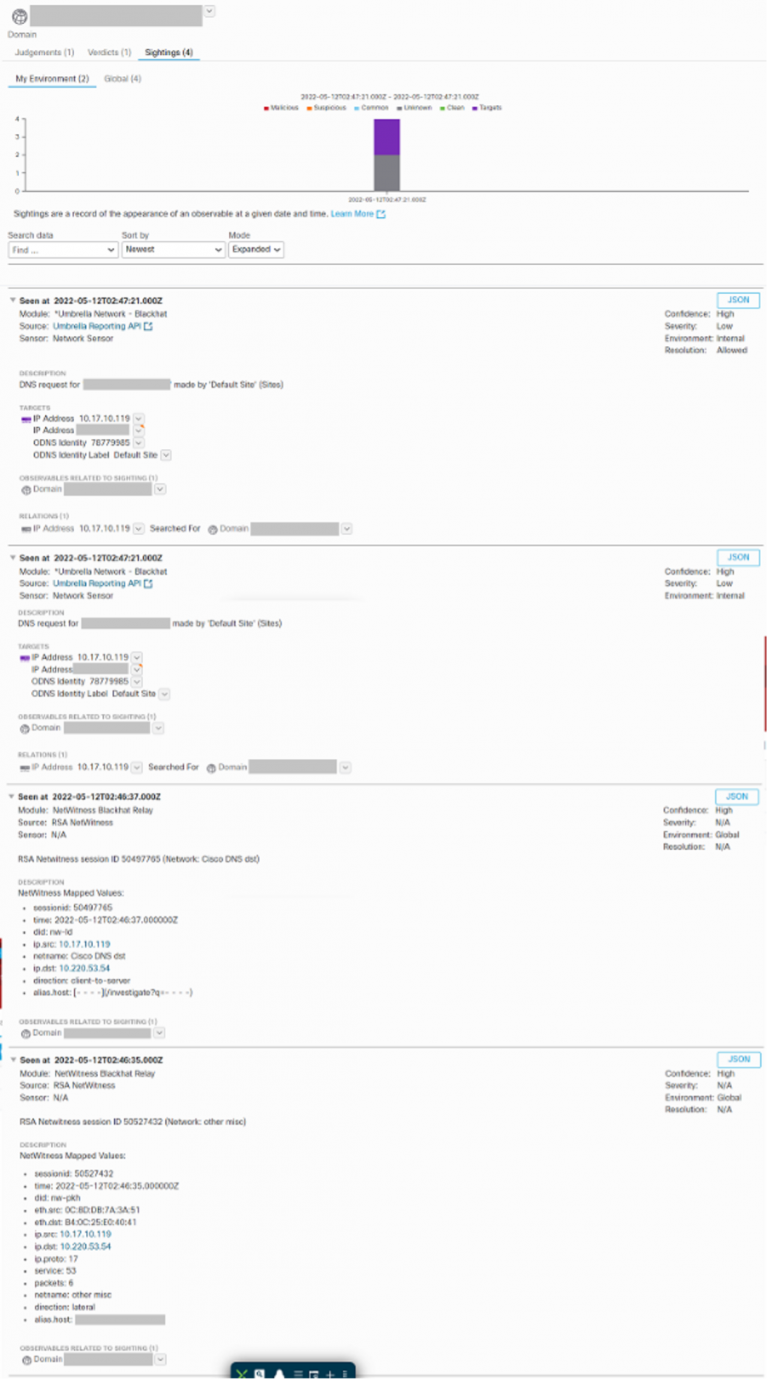
In addition to the traffic and online activities of hundreds of user devices on the network, we were responsible for monitoring a handful of Black Hat-owned devices as well. Secure X Device Insights made it easy to access information about these assets, either en masse or as required during an ongoing investigation. iOS Clarity for Secure Endpoint and Meraki System Manager both contributed to this useful tool which adds business intelligence and asset context to SecureX’s native event and threat intelligence, for more complete and more actionable security intelligence overall.

SecureX is made possible by dozens of integrations, each bringing their own unique information and capabilities. This time though, for me, the star of the SecureX show was our malware analysis engine, Cisco Secure Malware Analytics (CSMA). Shortly before Black Hat Asia, the CSMA team released a new version of their SecureX module. SecureX can now query CSMA’s database of malware behavior and activity, including all relevant indicators and observables, as an automated part of the regular process of any investigation performed in SecureX Threat Response.
This capability is most useful in two scenarios:
1: determining if suspicious domains, IPs and files reported by any other technology had been observed in the analysis of any of the millions of publicly submitted file samples, or our own.
2: rapidly gathering additional context about files submitted to the analysis engine by the integrated products in the Black Hat NOC.
The first was a significant time saver in several investigations. In the example below, we received an alert about connections to a suspicious domain. In that scenario, our first course of action is to investigate the domain and any other observables reported with it (typically the internal and public IPs included in the alert). Due to the new CSMA module, we immediately discovered that the domain had a history of being contacted by a variety of malware samples, from multiple families, and that information, corroborated by automatically gathered reputation information from multiple sources about each of those files, gave us an immediate next direction to investigate as we hunted for evidence of those files being present in network traffic or of any traffic to other C&C resources known to be used by those families. From the first alert to having a robust, data-driven set of related signals to look for, took only minutes, including from SecureX partner Recorded Future, who donated a full threat intelligence license for the Black Hat NOC.
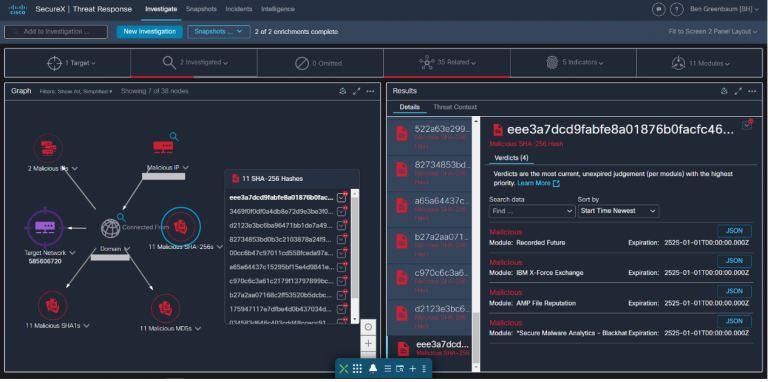
The other scenario, investigating files submitted for analysis, came up less frequently but when it did, the CSMA/SecureX integration was equally impressive. We could rapidly, nearly immediately, look for evidence of any of our analyzed samples in the environment across all other deployed SecureX-compatible technologies. That evidence was no longer limited to searching for the hash itself, but included any of the network resources or dropped payloads associated with the sample as well, easily identifying local targets who had not perhaps seen the exact variant submitted, but who had nonetheless been in contact with that sample’s Command and Control infrastructure or other related artifacts.
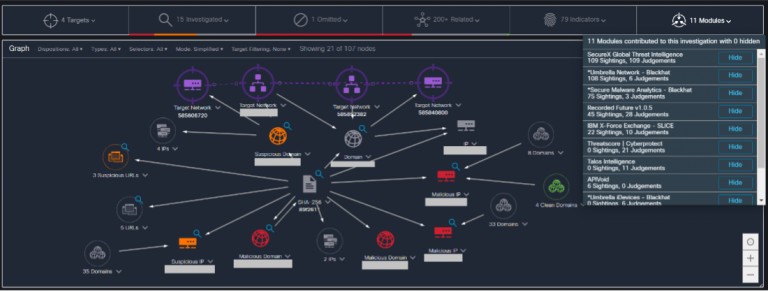
And of course, thanks to the presence of the ribbon in the CSMA UI, we could be even more efficient and do this with multiple samples at once.

SecureX greatly increased the efficiency of our small volunteer team, and certainly made it possible for us to investigate more alerts and events, and hunt for more threats, all more thoroughly, than we would have been able to without it. SecureX truly took this team to the next level, by augmenting and operationalizing the tools and the staff that we had at our disposal.
We look forward to seeing you at Black Hat USA in Las Vegas, 6-11 August 2022!

Acknowledgements: Special thanks to the Cisco Meraki and Cisco Secure Black Hat NOC team: Aditya Sankar, Aldous Yeung, Alejo Calaoagan, Ben Greenbaum, Christian Clasen, Felix H Y Lam, George Dorsey, Humphrey Cheung, Ian Redden, Jeffrey Chua, Jeffry Handal, Jonny Noble, Matt Vander Horst, Paul Fidler and Steven Fan.
Also, to our NOC partners NetWitness (especially David Glover), Palo Alto Networks (especially James Holland), Gigamon, IronNet (especially Bill Swearington), and the entire Black Hat / Informa Tech staff (especially Grifter ‘Neil Wyler’, Bart Stump, James Pope, Steve Fink and Steve Oldenbourg).
About Black Hat
For more than 20 years, Black Hat has provided attendees with the very latest in information security research, development, and trends. These high-profile global events and trainings are driven by the needs of the security community, striving to bring together the best minds in the industry. Black Hat inspires professionals at all career levels, encouraging growth and collaboration among academia, world-class researchers, and leaders in the public and private sectors. Black Hat Briefings and Trainings are held annually in the United States, Europe and Asia. More information is available at: blackhat.com. Black Hat is brought to you by Informa Tech.

Costa Rica’s national health service was hacked sometime earlier this morning by a Russian ransomware group known as Hive. The intrusion comes just weeks after Costa Rican President Rodrigo Chaves declared a state of emergency in response to a data ransom attack from a different Russian ransomware gang — Conti. Ransomware experts say there is good reason to believe the same cybercriminals are behind both attacks, and that Hive has been helping Conti rebrand and evade international sanctions targeting extortion payouts to cybercriminals operating in Russia.
The Costa Rican publication CRprensa.com reports that affected systems at the Costa Rican Social Security Fund (CCSS) were taken offline on the morning of May 31, but that the extent of the breach was still unclear. The CCSS is responsible for Costa Rica’s public health sector, and worker and employer contributions are mandated by law.
A hand-written sign posted outside a public health center in Costa Rica today explained that all systems are down until further notice (thanks to @Xyb3rb3nd3r for sharing this photo).

A hand-written notice posted outside a public health clinic today in Costa Rica warned of system outages due to a cyberattack on the nation’s healthcare systems. The message reads: “Dear Users: We would like to inform you that due a problem related to the information systems of the institution, we are unable to expend any medicine prescriptions today until further notice. Thank you for your understanding- The pharmacy.”
Esteban Jimenez, founder of the Costa Rican cybersecurity consultancy ATTI Cyber, told KrebsOnSecurity the CCSS suffered a cyber attack that compromised the Unique Digital Medical File (EDUS) and the National Prescriptions System for the public pharmacies, and as a result medical centers have turned to paper forms and manual contingencies.
“Many smaller health centers located in rural areas have been forced to close due to not having the required equipment or communication with their respective central health areas and the National Retirement Fund (IVM) was completely blocked,” Jimenez said. “Taking into account that salaries of around fifty thousand employees and deposits for retired citizens were due today, so now the payments are in danger.”
Jimenez said the head of the CCSS has addressed the local media, confirming that the Hive ransomware was deployed on at least 30 out of 1,500 government servers, and that any estimation of time to recovery remains unknown. He added that many printers within the government agency this morning began churning out copies of the Hive ransom note.

Printers at the Costa Rican government health ministry went crazy this morning after the Hive ransomware group attacked. Image: Esteban Jimenez.
“HIVE has not yet released their ransom fee but attacks are expected to follow, other organizations are trying to get a hold on the emergency declaration to obtain additional funds to purchase new pieces of infrastructure, improve their backup structure amongst others,” Jimenez said.
A copy of the ransom note left behind by the intruders and subsequently uploaded to Virustotal.com indicates the CCSS intrusion was the work of Hive, which typically demands payment for a digital key needed to unlock files and servers compromised by the group’s ransomware.
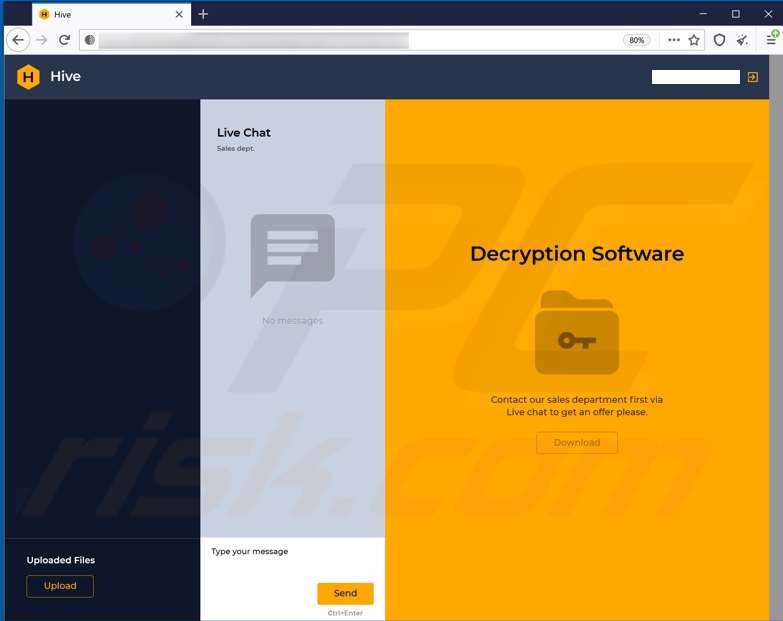
A HIVE ransomware chat page for a specific victim (redacted).
On May 8, President Chaves used his first day in office to declare a national state of emergency after the Conti ransomware group threatened to publish gigabytes of sensitive data stolen from Costa Rica’s Ministry of Finance and other government agencies. Conti initially demanded $10 million, and later doubled the amount when Costa Rica refused to pay. On May 20, Conti leaked more than 670 gigabytes of data taken from Costa Rican government servers.
As CyberScoop reported on May 17, Chaves told local media he believed that collaborators within Costa Rica were helping Conti extort the government. Chaves offered no information to support this claim, but the timeline of Conti’s descent on Costa Rica is worth examining.
Most of Conti’s public communications about the Costa Rica attack have very clearly assigned credit for the intrusion to an individual or group calling itself “unc1756.” In March 2022, a new user by the same name registered on the Russian language crime forum Exploit.

A message Conti posted to its dark web blog on May 20.
On the evening of April 18, Costa Rica’s Ministry of Finance disclosed the Conti intrusion via Twitter. Earlier that same day, the user unc1756 posted a help wanted ad on Exploit saying they were looking to buy access to “special networks” in Costa Rica.
“By special networks I mean something like Haciendas,” unc1756 wrote on Exploit. Costa Rica’s Ministry of Finance is known in Spanish as the “Ministerio Hacienda de Costa Rica.” Unc1756 said they would pay $USD 500 or more for such access, and would work only with Russian-speaking people.
Experts say there are clues to suggest Conti and Hive are working together in their attacks on Costa Rica, and that the intrusions are tied to a rebranding effort by Conti. Shortly after Russia invaded Ukraine at the end of February, Conti declared its full support, aligning itself directly with Russia and against anyone who would stand against the motherland.
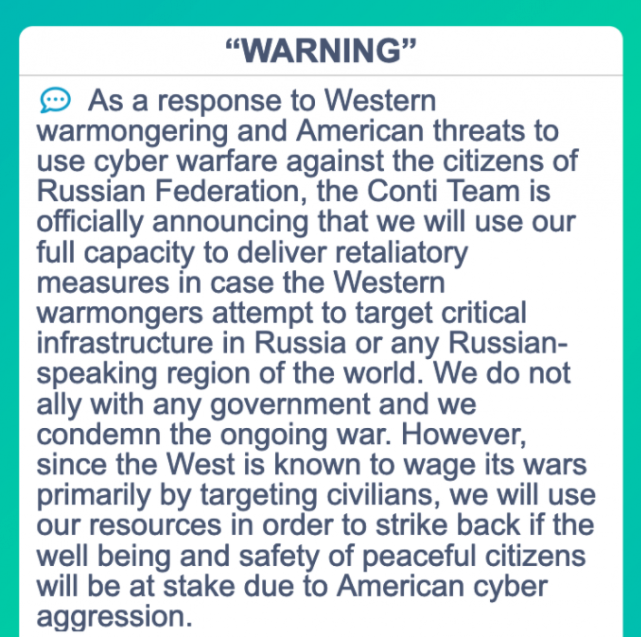
Conti’s threatening message this week regarding international interference in Ukraine.
Conti quickly deleted the declaration from its website, but the damage had already been done, and any favor or esteem that Conti had earned among the Ukrainian cybercriminal underground effectively evaporated overnight.
Shortly thereafter, a Ukrainian security expert leaked many months worth of internal chat records between Conti personnel as they plotted and executed attacks against hundreds of victim organizations. Those candid messages exposed what it’s like to work for Conti, how they undermined the security of their targets, as well as how the group’s leaders strategized for the upper hand in ransom negotiations.
But Conti’s declaration of solidarity with the Kremlin also made it increasingly ineffective as an instrument of financial extortion. According to cyber intelligence firm ADVIntel, Conti’s alliance with the Russian state soon left it largely unable to receive ransom payments because victim companies are being advised that paying a Conti ransom demand could mean violating U.S. economic sanctions on Russia.
“Conti as a brand became associated with the Russian state — a state that is currently undergoing extreme sanctions,” ADVIntel wrote in a lengthy analysis (PDF). “In the eyes of the state, each ransom payment going to Conti may have potentially gone to an individual under sanction, turning simple data extortion into a violation of OFAC regulation and sanction policies against Russia.”
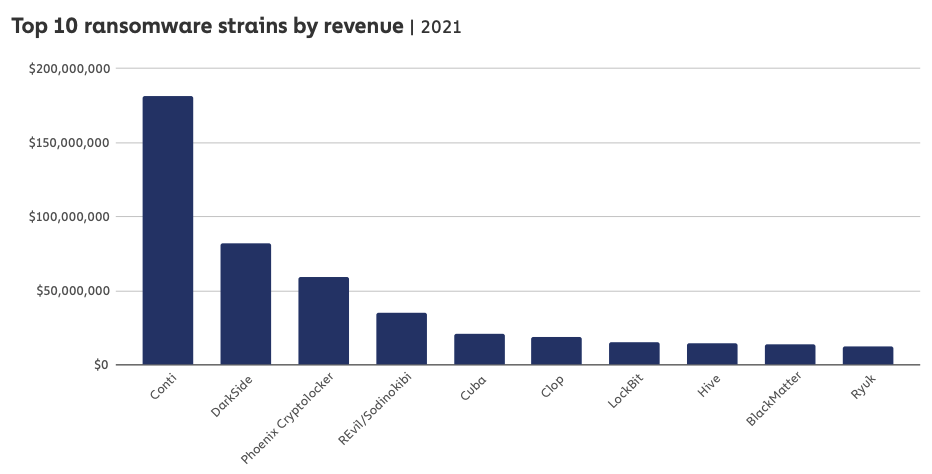
Conti is by far the most aggressive and profitable ransomware group in operation today. Image: Chainalysis
ADVIntel says it first learned of Conti’s intrusion into Costa Rican government systems on April 14, and that it has seen internal Conti communications indicating that getting paid in the Costa Rica attack was not the goal.
Rather, ADVIntel argues, Conti was simply using it as a way to appear publicly that it was still operating as the world’s most lucrative ransomware collective, when in reality the core Conti leadership was busy dismantling the crime group and folding themselves and top affiliates into other ransomware groups that are already on friendly terms with Conti.
“The only goal Conti had wanted to meet with this final attack was to use the platform as a tool of publicity, performing their own death and subsequent rebirth in the most plausible way it could have been conceived,” ADVIntel concluded.
ADVIntel says Conti’s leaders and core affiliates are dispersing to several Conti-loyal crime collectives that use either ransomware lockers or strictly engage in data theft for ransom, including AlphV/BlackCat, AvosLocker, BlackByte, HelloKitty, Hive, and Karakurt.
Still, Hive appears to be perhaps the biggest beneficiary of any attrition from Conti: Twice over the past week, both Conti and Hive claimed responsibility for hacking the same companies. When the discrepancy was called out on Twitter, Hive updated its website to claim it was not affiliated with Conti.

Conti and Hive’s Costa Rican exploits mark the latest in a string of recent cyberattacks against government targets across Latin America. Around the same time it hacked Costa Rica in April, Conti announced it had hacked Peru’s National Directorate of Intelligence, threatening to publish sensitive stolen data if the government did not pay a ransom.
But Conti and Hive are not alone in targeting Latin American victims of late. According to data gathered from the victim shaming blogs maintained by multiple ransomware groups, over the past 90 days ransom actors have hacked and sought to extort 15 government agencies in Brazil, nine in Argentina, six in Colombia, four in Ecuador and three in Chile.
A recent report (PDF) by the Inter-American Development Bank suggests many Latin American countries lack the technical expertise or cybercrime laws to deal with today’s threats and threat actors.
“This study shows that the Latin American and Caribbean (LAC) region is not sufficiently prepared to handle cyberattacks,” the IADB document explains. “Only 7 of the 32 countries studied have a critical infrastructure protection plan, while 20 have established cybersecurity incident response teams, often called CERTs or CSIRTs. This limits their ability to identify and respond to attacks.”
The SASE landscape is full of vendors. So full, in fact, that the entire SASE vendor market grew 37% in just a year between 2020 and 2021. It’s clear that SASE is on the top of everyone’s minds. Why? SASE is the evolution of networking and security – an architecture that converges them into a single, cloud delivered service. This streamlined approach is key to securing and connecting the always-on, work-from-anywhere modern work model.
Traditional, siloed security solutions aren’t equipped to handle all the challenges that come along with a multi-environment IT reality. The accelerated transition to hybrid work has increased complexity in managing security and connectivity. Businesses face increased cloud adoption, bring-your-own-device connectivity, increasingly complex cybersecurity threats, and the constant change. Businesses have struggled to keep up with the gaps in coverage, and tech vendors have hurried in to fill the space with cloud security and networking options. But not all SASE solutions are created equal.
In the rush to compete in the market for the future of networking and security, vendors positioned themselves as SASE without offering a truly integrated approach that’s critical to SASE success. Many vendors offer cloud security solutions with no native or integrated SD-WAN networking capability. Others aren’t backed with robust threat intelligence that enable them to effectively deliver on threat detection and prevention. Some don’t offer the flexibility and scalability that businesses need to adopt cloud-delivered security. Many don’t offer open, integrated management platforms. Plus, most organizations face monumental complexity – the exact opposite of what SASE should deliver – due to using several different vendors for different security functions.
Dell’Oro Group, the trusted source for market information in the telecommunications, enterprise networks, and data center IT infrastructure industries, recognized Cisco as the SASE Market Share Leader in 2021, with 19% of the total market share by revenue.
“Cisco was the SASE market share leader because of the combined strength of their networking (SD-WAN) and security capabilities (including secure web gateway, cloud access security broker, and zero trust network access),” said Mauricio Sanchez, Research Director, Network Security, and SASE & SD-WAN at Dell’Oro Group.
At Cisco, we began our journey by pioneering network connectivity and offering innovative tech solutions; today, we have the most SD-WAN market share and secure 100% of Fortune 100 companies. From that foundation, we’ve been able to build and deliver award-winning cloud security solutions that, when combined with our networking services, create a robust, complete SASE architecture.
Cisco’s SASE approach combines networking, client connectivity, security, and internet and cloud intelligence capabilities and helps organizations:
The benefits of a SASE model are unlocked by working with a single vendor who can bring together best-in-class networking, security, and internet and cloud intelligence—while offering the flexibility and investment protection to transition to the cloud at your pace.
While Cisco provides a comprehensive SASE framework, we know that everyone’s journey to the cloud is different. Organizations, especially now, are shifting and refining their strategies, particularly when it comes to cybersecurity and the increase of both the number and type of threats that businesses see every day. Cisco can help organizations make the most of their existing security and networking investments, while also offering increased and amplified functionality across their security infrastructure. Wherever you are on your journey to SASE, Cisco Secure has the unparalleled experience and reputation that can support you on your next steps.
Check out our SASE demo to find out how Cisco delivers a simple, secure, and scalable approach to SASE.
We’d love to hear what you think. Ask a Question, Comment Below, and Stay Connected with Cisco Secure on social!
Cisco Secure Social Channels
Netflix has a new documentary series airing next week — “Web of Make Believe: Death, Lies & the Internet” — in which Yours Truly apparently has a decent amount of screen time. The debut episode explores the far-too-common harassment tactic of “swatting” — wherein fake bomb threats or hostage situations are phoned in to police as part of a scheme to trick them into visiting potentially deadly force on a target’s address.

Image: Netflix.com
The producers of the Netflix show said footage from an interview I sat for in early 2020 on swatting and other threats should appear in the first episode. They didn’t specify what additional topics the series would scrutinize, but Netflix’s teaser for the show suggests it concerns cybercrimes that result in deadly, real-world kinetic attacks.
“Conspiracy. Fraud. Violence. Murder,” reads the Netflix short description for the series. “What starts out virtual can get real all too quickly — and when the web is worldwide, so are the consequences.”
Our family has been victimized by multiple swatting attacks over the past decade. Our first swatting, in March 2013, resulted in Fairfax County, Va. police surrounding our home and forcing me into handcuffs at gunpoint. For an excruciating two minutes, I had multiple police officers pointing rifles, shotguns and pistols directly at me.
More recently, our family was subjected to swatting attacks by a neo-Nazi group that targeted journalists, judges and corporate executives. We’ve been fortunate that none of our swatting events ended in physical harm, and that our assailants have all faced justice.
But these dangerous hoaxes can quickly turn deadly: In March 2019, 26-year-old serial swatter Tyler Barriss was sentenced to 20 years in prison for making a phony emergency call to police in late 2017 that resulted in the shooting death of an innocent Kansas resident.
In 2021, an 18-year-old Tennessee man who helped set in motion a fraudulent distress call to police that led to the death of a 60-year-old grandfather in was sentenced to five years in prison.
The first season of the new documentary series will be available on Netflix starting June 15. See you on TV!